- Enterprise Custom Courses
- Build Your Own Courses
- Help Center
- Clinical Trial Recruitment
- Pharmaceutical Marketing
- Health Department Resources
- Patient Education
- Research Presentation
- Remote Monitoring
- Health Literacy & SciComm
- Student Education & Higher Ed
- Individual Learning
- Member Directory
- Community Chats on Slack
- SciComm Program
- The Story-Driven Method
- The Instructional Method

How to Create an Engaging Science Presentation: A Quick Guide
We’ve all been there – rushing to put slides together for an upcoming talk, filling them with bullet points and text that we want to remember to cover. We aren’t sure exactly what the audience will want to know or how much detail to include, so we default to putting ALL the details in that might be needed. But such efforts often result in presentations that are too long, too confusing, and difficult for both ourselves and our audiences to navigate.
Today I gave a workshop to public health graduate students about how to create more engaging science presentations and talks. I’ve summarized the main takeaways below. I hope this quick guide will be useful to you as you prepare for your next science talk or presentation!
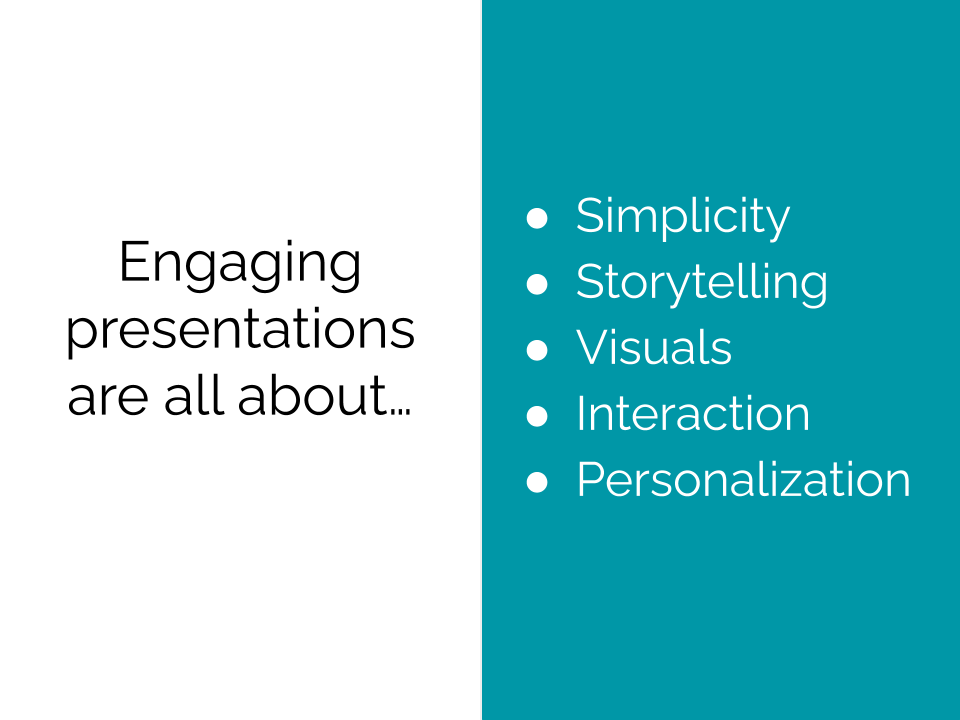
The best science talks start with a process of simplifying – peeling back the layers of information and detail to get at the one core idea that you want to communicate. Over the course of your talk, you may present 2-3 key messages that relate to, demonstrate, provide examples of or underpin this idea. (Three is a nice round number of messages or takeaways that your audience will be able to remember!) But stick to one big idea. Trying to communicate too much in a presentation or talk will overwhelm your audience, and they may walk away without a good memory of any of the ideas you presented.
Once you’ve settled on your one big idea, you can develop a theme that will pervade every aspect of your talk. This theme might be a defining element of your big idea and something that can tie all of your data or talking points together. Your theme should inform the examples, anecdotes and analogies that you use to make the science concepts you present more accessible. It should also inform your slides’ very design – the colors, visuals, layout and content flow.
If you have trouble identifying your big idea and your theme, you can try using what scientist and science author Randy Olson calls the “Dobzhansky Template.” Fill in the blanks of this statement: “ Nothing in [your talk topic, research topic or big idea] makes sense, except in the light of [your theme!] .”
Here’s an example for you: “Nothing in the creation of engaging science talks makes sense except in the light of people’s need for personal connection .” With this statement, I’m identifying a key aspect, a unifying theme, for my talk (or blog post) on how to create engaging science talks. We all crave personal connection. Yes, even to the speakers of science talks we listen to! What does this mean in terms of what we want or expect from these speakers? It means we want storytelling . We want to hear their stories, know their background, hear about their struggles and triumphs! We want to be able to step into their shoes and see what they saw. We want to interact with them.
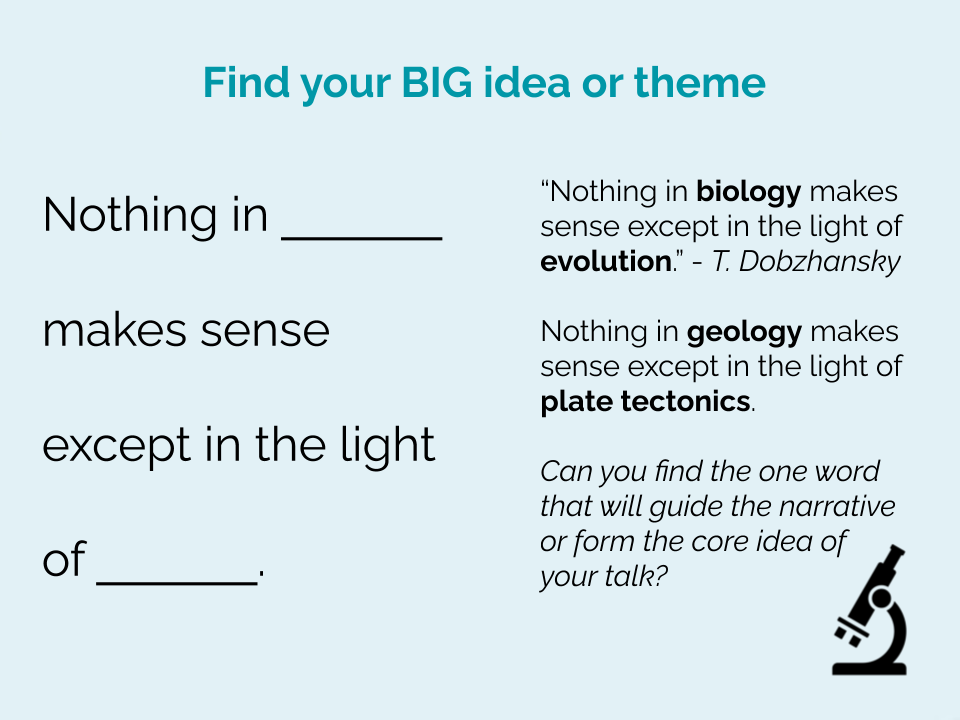
Tell a Story
Narratives engage more than facts. By telling a story , using suspense and characters to pull people through your presentation, you will capture and keep their attention for longer. People also remember information presented in a story format better than they do information presented as disparate facts or bullet points.
“Story is a pull strategy. If your story is good enough, people—of their own free will—come to the conclusion they can trust you and the message you bring.” – Annette Simmons
Storytelling is a powerful science communication tool. In storytelling, both the storyteller and the listener or reader contribute to the story’s meaning through their interpretations, feelings and emotions. Liz Neeley, former executive director of The Story Collider, once said: “Science communicators frequently fail to understand that a feeling is almost never conquered with a fact.”
Stories are exciting. They elicit emotions. They help foster a personal connection between the storyteller and the listener, and a connection between the listener and the topic, characters or ideas presented in the story.
But what IS a story? As humans, we excel at recognizing a story when we hear one, but defining a story’s key characteristics is more difficult than you might think. If you ask anyone to explain what makes for a good story, they likely will have a hard time explaining it.
In her fantastic book Wired for Story , Lisa Cron starts by explaining what a story is NOT.
It is not plot – that is just what happens in the story.
It is not characters , although characters are critical components of storytelling, even if they are not human or even alive. Cells and molecules could be the characters of your next science talk!
It is not suspense or conflict , although these elements get us closer to what defines a good story. But just because your talk builds suspense does not necessarily make it an engaging story. What if we don’t identify with your characters?
The truth is that the key defining element of story is internal change . Think of how every Aesop’s fable communicates a moral or lesson that the main character learned from some journey. As Lisa Cron writes, “A story is how what happens affects someone who is trying to achieve what turns out to be a difficult goal, and how he or she changes as a result.” The key here is the part about “how he or she changes.” A great story calls characters to a great adventure, but the adventure doesn’t leave them just as they were before. The adventure – like a scientific discovery that took years of experimentation (and failure) in the lab – leads to an internal change, in perspective or knowledge or behavior, as a result of conflicts overcome.
This is the secret of storytelling. A story asks characters to change and grow, and so the scientists in our stories must change and grow, discover new things about themselves and overcome challenges that force them to adopt new perspectives. So if you are giving a science talk about your own research, this might look like telling stories about your own struggles, growths and changes in perspective as you made your journey to discovery!
How can you bring a story of internal change to your next science presentation or talk?
What is one of the most common mistakes people make when creating slides to accompany a science talk? They use WAY too much text, and they use visuals as an afterthought. Worse yet, they use visuals that are copyrighted without attribution. They use stock imagery that reinforces stereotypes. They use visuals pasted from a Google search that don’t help the viewer understand or interpret what is said or written on the slides.
Visuals can be a powerful tool to advance audience learning or engagement during your science talks. You can use visuals to provide concrete examples of concepts you are talking about. You can use imagery that sparks thought or emotion. You can use visuals that reinforce your BIG idea or the theme of your talk, in a way that will make your talk more memorable for them. Yes, you might need to use a scientific figure, graph, chart or data visualization here and there if you are giving a more technical scientific talk, and that’s ok as long as you also talk the audience through this visual. Don’t assume they can listen to you talk about something different while also taking the time to interpret the message in this graphic or visualization – they can’t.
The same goes for text. You are demanding way too much brainpower of your audience to expect them to listen to you while also reading your slides. And if you are saying the same things as are written on your slides, they will grow bored. Simple visual aids used the right way, however, can delight your audience and help them better understand what you are saying.
Consider working with a professional artist or designer to create visuals for the slides of your next science talk! They excel at creating visuals that capture people’s attention, curiosity and emotions. And if you do this, your visuals will perfectly match what you are trying to communicate in words, boosting learning and understanding.
Foster Interaction
A good science talk or presentation gives the audience opportunities to interact with you! This could be through questions, activities, discussions or thought experiments. Let the audience explore your data or interpretations with you. They will be more engaged and likely trust you more as a result, because they felt heard .
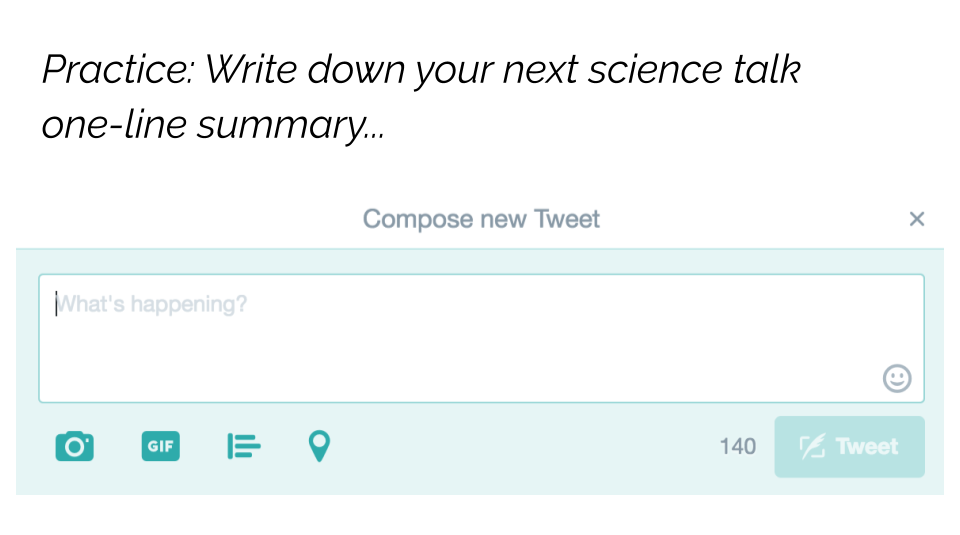
Personalize!
Most great science speakers make themselves vulnerable in a way – they tell personal stories of struggles, growth and discovery. Personal stories are engaging. They also help the audience care about what the speaker has to say.
It can be scary to talk about yourself, especially for a scientist who has been trained to focus solely on the data. But the humans listening to your talk or presentation crave human connection. They will also grab hold of anything that helps them better relate to you. Give them that in the form of personal stories of obstacles overcome, of personal lessons learned, of work-life balance, of your fears and passions. Better yet, tell personal stories that reinforce your theme and show the power of your big idea!
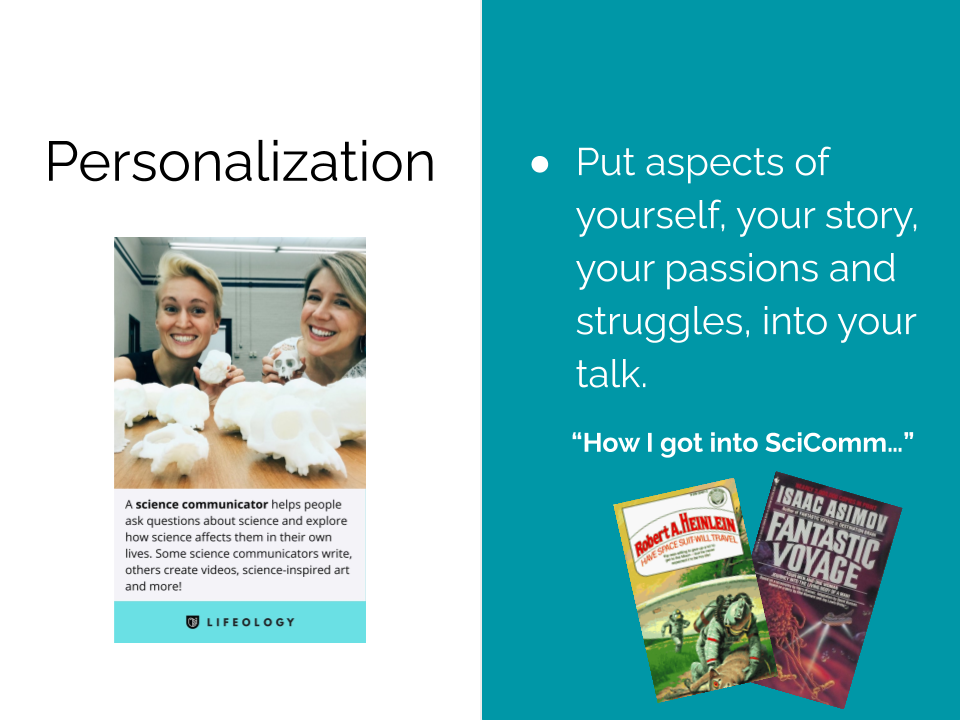
Do you have other strategies for how you make your science talks and presentations more engaging? Let me know in the comments below!
Share This Story, Choose Your Platform!
About the author: paige jarreau.

Related Posts

Una actividad práctica para ayudarte a comunicar la ciencia de forma culturalmente relevante

The Power of SciComm in Combatting Mental Health Stigma
Make your scicomm more culturally relevant: a practice activity.

Communicating About Postpartum Depression

Science Communication and Genetic Counselling

Creating Analogies: Elevate Your Science with a Lifeology Course
Get in touch
555-555-5555

Limited time offer: 20% off all templates ➞

Scientific Presentation Guide: How to Create an Engaging Research Talk
Creating an effective scientific presentation requires developing clear talking points and slide designs that highlight your most important research results..
Scientific presentations are detailed talks that showcase a research project or analysis results. This comprehensive guide reviews everything you need to know to give an engaging presentation for scientific conferences, lab meetings, and PhD thesis talks. From creating your presentation outline to designing effective slides, the tips in this article will give you the tools you need to impress your scientific peers and superiors.

Step 1. Create a Presentation Outline
The first step to giving a good scientific talk is to create a presentation outline that engages the audience at the start of the talk, highlights only 3-5 main points of your research, and then ends with a clear take-home message. Creating an outline ensures that the overall talk storyline is clear and will save you time when you start to design your slides.
Engage Your Audience
The first part of your presentation outline should contain slide ideas that will gain your audience's attention. Below are a few recommendations for slides that engage your audience at the start of the talk:
- Create a slide that makes connects your data or presentation information to a shared purpose, such as relevance to solving a medical problem or fundamental question in your field of research
- Create slides that ask and invite questions
- Use humor or entertainment
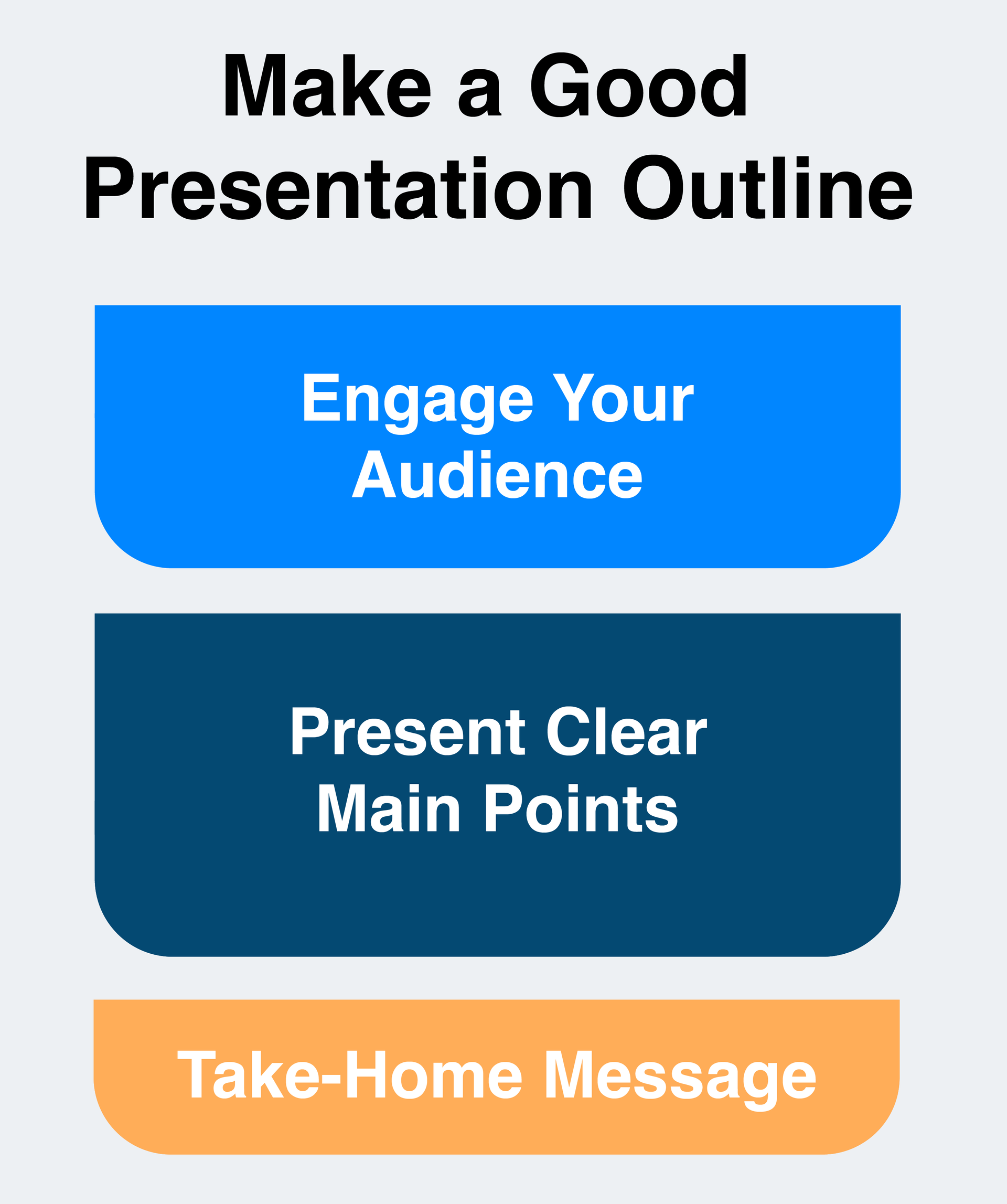
Identify Clear Main Points
After writing down your engagement ideas, the next step is to list the main points that will become the outline slide for your presentation. A great way to accomplish this is to set a timer for five minutes and write down all of the main points and results or your research that you want to discuss in the talk. When the time is up, review the points and select no more than three to five main points that create your talk outline. Limiting the amount of information you share goes a long way in maintaining audience engagement and understanding.

Create a Take-Home Message
And finally, you should brainstorm a single take-home message that makes the most important main point stand out. This is the one idea that you want people to remember or to take action on after your talk. This can be your core research discovery or the next steps that will move the project forward.
Step 2. Choose a Professional Slide Theme
After you have a good presentation outline, the next step is to choose your slide colors and create a theme. Good slide themes use between two to four main colors that are accessible to people with color vision deficiencies. Read this article to learn more about choosing the best scientific color palettes .
You can also choose templates that already have an accessible color scheme. However, be aware that many PowerPoint templates that are available online are too cheesy for a scientific audience. Below options to download professional scientific slide templates that are designed specifically for academic conferences, research talks, and graduate thesis defenses.
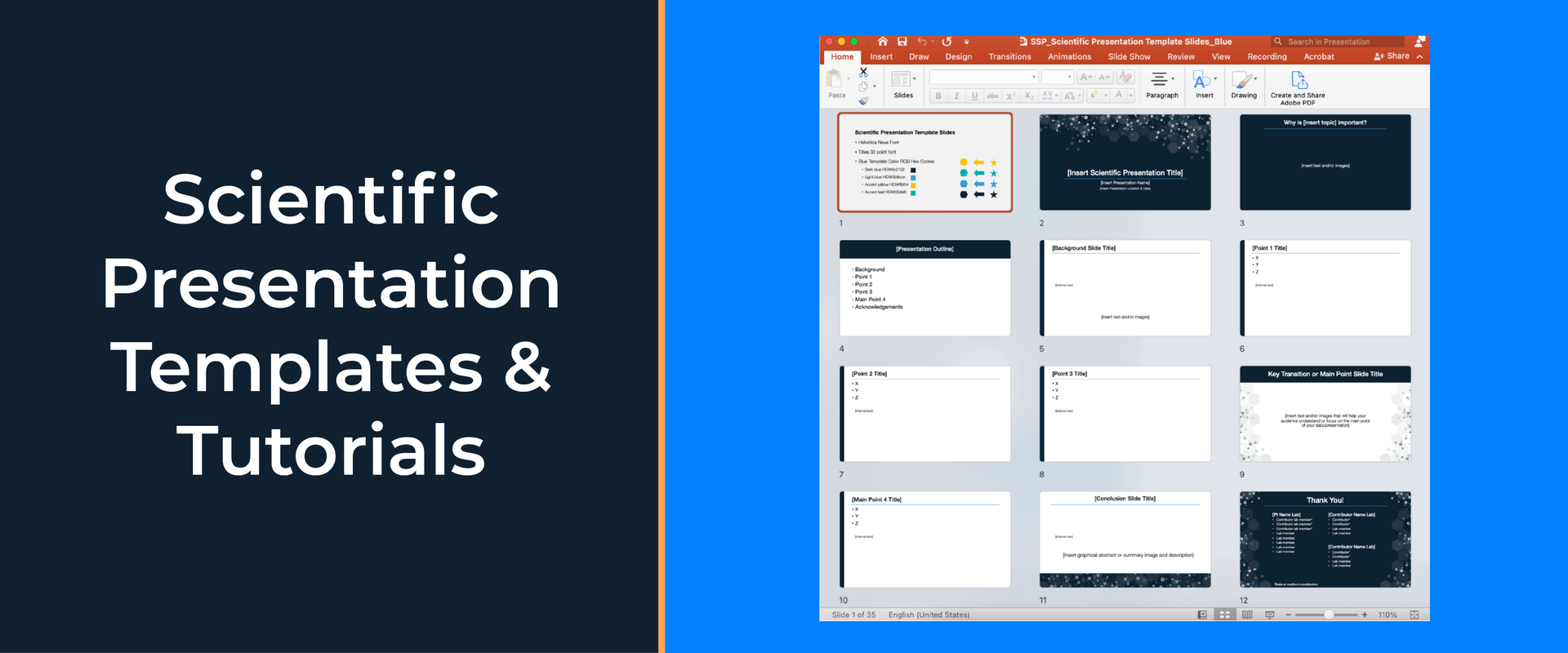
Step 3. Design Your Slides
Designing good slides is essential to maintaining audience interest during your scientific talk. Follow these four best practices for designing your slides:
- Keep it simple: limit the amount of information you show on each slide
- Use images and illustrations that clearly show the main points with very little text.
- Read this article to see research slide example designs for inspiration
- When you are using text, try to reduce the scientific jargon that is unnecessary. Text on research talk slides needs to be much more simple than the text used in scientific publications (see example below).
- Use appear/disappear animations to break up the details into smaller digestible bites
- Sign up for the free presentation design course to learn PowerPoint animation tricks
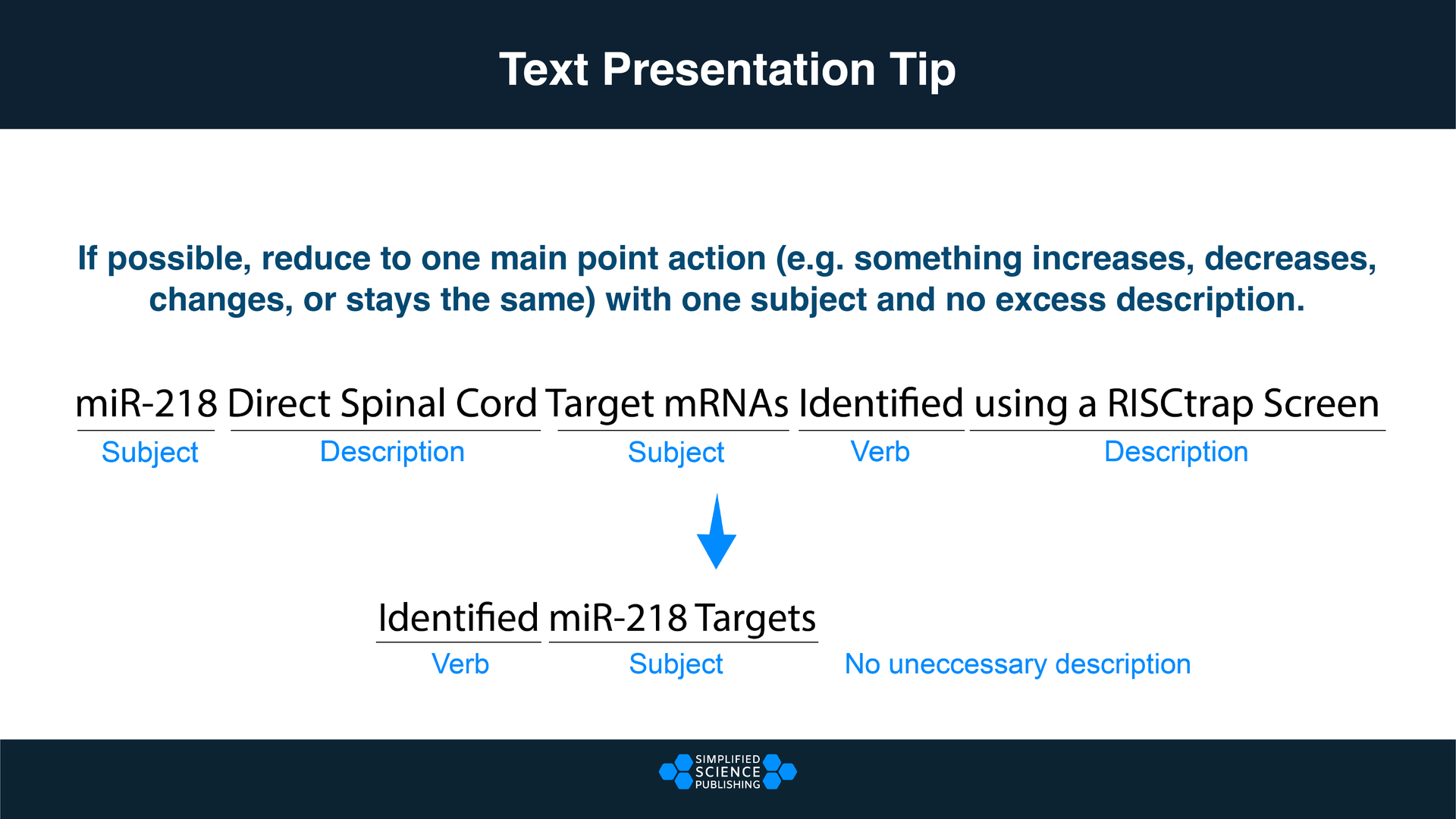
Scientific Presentation Design Summary
All of the examples and tips described in this article will help you create impressive scientific presentations. Below is the summary of how to give an engaging talk that will earn respect from your scientific community.
Step 1. Draft Presentation Outline. Create a presentation outline that clearly highlights the main point of your research. Make sure to start your talk outline with ideas to engage your audience and end your talk with a clear take-home message.
Step 2. Choose Slide Theme. Use a slide template or theme that looks professional, best represents your data, and matches your audience's expectations. Do not use slides that are too plain or too cheesy.
Step 3. Design Engaging Slides. Effective presentation slide designs use clear data visualizations and limits the amount of information that is added to each slide.
And a final tip is to practice your presentation so that you can refine your talking points. This way you will also know how long it will take you to cover the most essential information on your slides. Thank you for choosing Simplified Science Publishing as your science communication resource and good luck with your presentations!
Interested in free design templates and training?
Explore scientific illustration templates and courses by creating a Simplified Science Publishing Log In. Whether you are new to data visualization design or have some experience, these resources will improve your ability to use both basic and advanced design tools.
Interested in reading more articles on scientific design? Learn more below:

Data Storytelling Techniques: How to Tell a Great Data Story in 4 Steps

Best Science PowerPoint Templates and Slide Design Examples
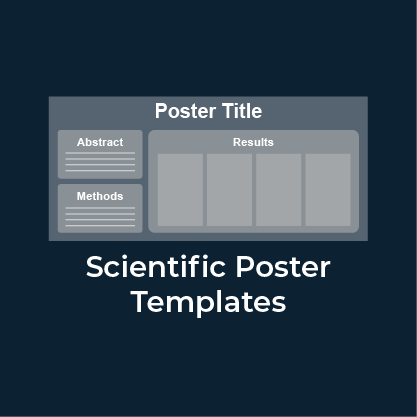
Free Research Poster Templates and Tutorials
Content is protected by Copyright license. Website visitors are welcome to share images and articles, however they must include the Simplified Science Publishing URL source link when shared. Thank you!
Online Courses
Stay up-to-date for new simplified science courses, subscribe to our newsletter.
Thank you for signing up!
You have been added to the emailing list and will only recieve updates when there are new courses or templates added to the website.
We use cookies on this site to enhance your user experience and we do not sell data. By using this website, you are giving your consent for us to set cookies: View Privacy Policy
Simplified Science Publishing, LLC
Home Blog Education How to Prepare Your Scientific Presentation
How to Prepare Your Scientific Presentation
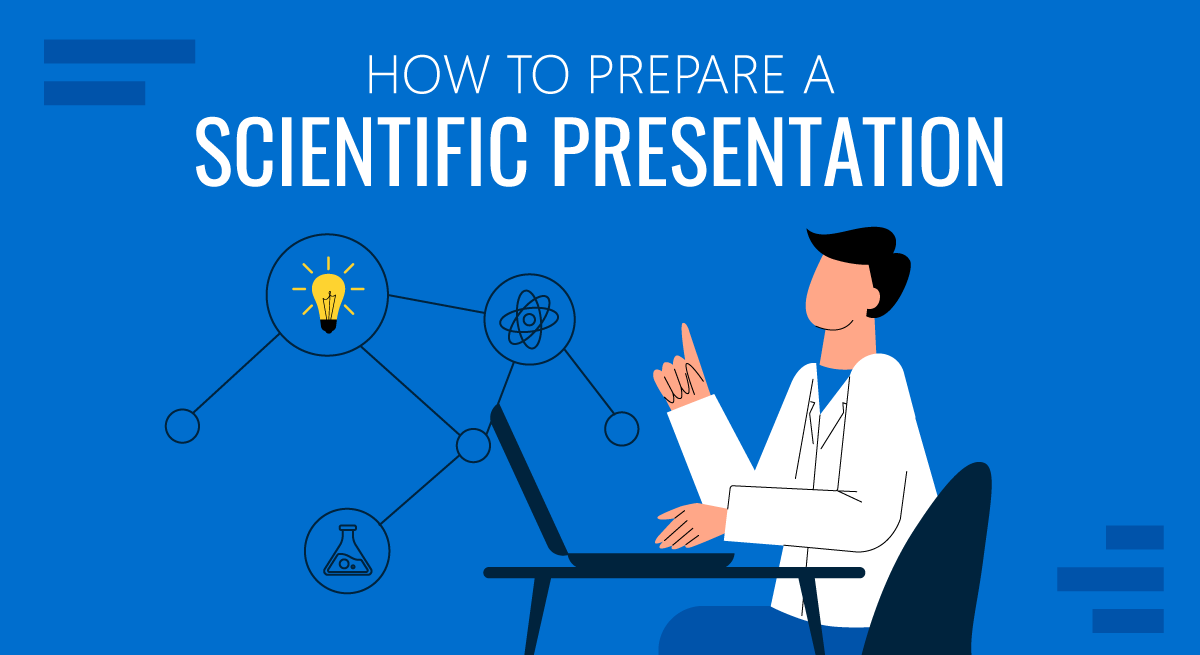
Since the dawn of time, humans were eager to find explanations for the world around them. At first, our scientific method was very simplistic and somewhat naive. We observed and reflected. But with the progressive evolution of research methods and thinking paradigms, we arrived into the modern era of enlightenment and science. So what represents the modern scientific method and how can you accurately share and present your research findings to others? These are the two fundamental questions we attempt to answer in this post.
What is the Scientific Method?
To better understand the concept, let’s start with this scientific method definition from the International Encyclopedia of Human Geography :
The scientific method is a way of conducting research, based on theory construction, the generation of testable hypotheses, their empirical testing, and the revision of theory if the hypothesis is rejected.
Essentially, a scientific method is a cumulative term, used to describe the process any scientist uses to objectively interpret the world (and specific phenomenon) around them.
The scientific method is the opposite of beliefs and cognitive biases — mostly irrational, often unconscious, interpretations of different occurrences that we lean on as a mental shortcut.
The scientific method in research, on the contrary, forces the thinker to holistically assess and test our approaches to interpreting data. So that they could gain consistent and non-arbitrary results.
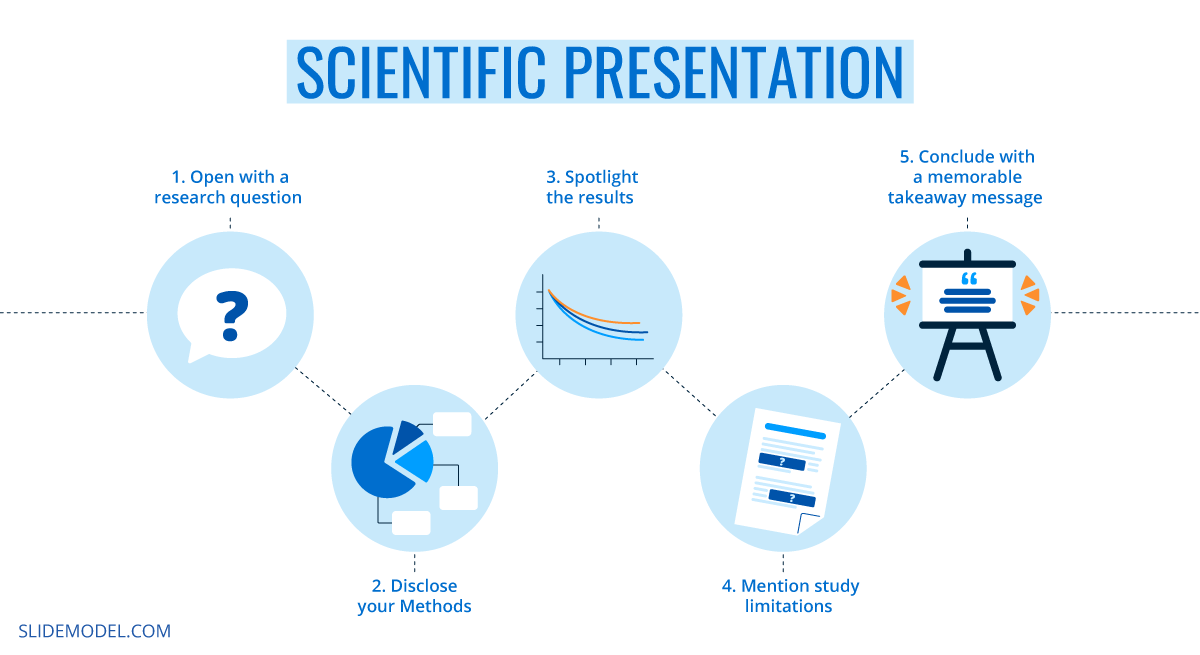
The common scientific method examples are:
- Systematic observation
- Experimentation
- Inductive and deductive reasoning
- Formation and testing of hypotheses and theories
All of the above are used by both scientists and businesses to make better sense of the data and/or phenomenon at hand.
The Evolution of the Scientific Method
According to the Stanford Encyclopedia of Philosophy , ancient thinkers such as Plato and Aristotle are believed to be the forefathers of the scientific method. They were among the first to try to justify and refine their thought process using the scientific method experiments and deductive reasoning.
Both developed specific systems for knowledge acquisition and processing. For example, the Platonic way of knowledge emphasized reasoning as the main method for learning but downplayed the importance of observation. The Aristotelian corpus of knowledge, on the contrary, said that we must carefully observe the natural world to discover its fundamental principles.
In medieval times, thinkers such as Thomas Aquinas, Roger Bacon, and Andreas Vesalius among many others worked on further clarifying how we can obtain proven knowledge through observation and induction.
The 16th–18th centuries are believed to have given the greatest advances in terms of scientific method application. We, humans, learned to better interpret the world around us from mechanical, biological, economic, political, and medical perspectives. Thinkers such as Galileo Galilei, Francis Bacon, and their followers also increasingly switched to a tradition of explaining everything through mathematics, geometry, and numbers.
Up till today, mathematical and mechanical explanations remain the core parts of the scientific method.
Why is the Scientific Method Important Today?
Because our ancestors didn’t have as much data as we do. We now live in the era of paramount data accessibility and connectivity, where over 2.5 quintillions of data are produced each day. This has tremendously accelerated knowledge creation.
But, at the same time, such overwhelming exposure to data made us more prone to external influences, biases, and false beliefs. These can jeopardize the objectivity of any research you are conducting.
Scientific findings need to remain objective, verifiable, accurate, and consistent. Diligent usage of scientific methods in modern business and science helps ensure proper data interpretation, results replication, and undisputable validity.
6 Steps of the Scientific Method
Over the course of history, the scientific method underwent many interactions. Yet, it still carries some of the integral steps our ancestors used to analyze the world such as observation and inductive reasoning. However, the modern scientific method steps differ a bit.
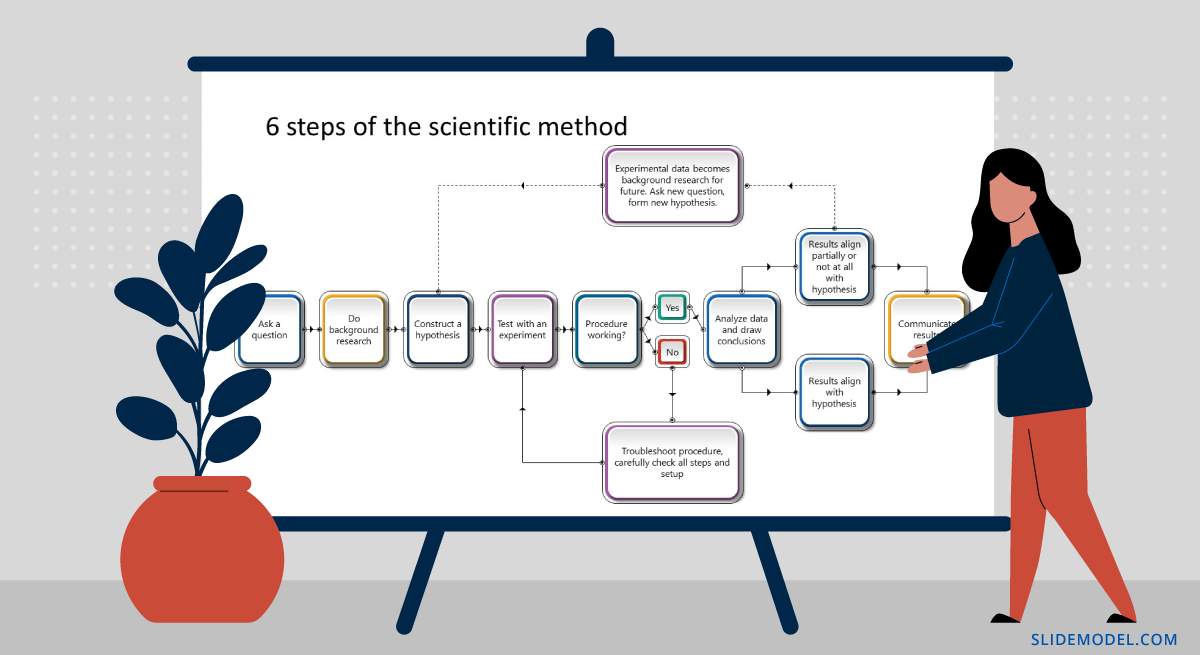
1. Make an Observation
An observation serves as a baseline for your research. There are two important characteristics for a good research observation:
- It must be objective, not subjective.
- It must be verifiable, meaning others can say it’s true or false with this.
For example, This apple is red (objective/verifiable observation). This apple is delicious (subjective, harder-to-verify observation).
2. Develop a Hypothesis
Observations tell us about the present or past. But the goal of science is to glean in the future. A scientific hypothesis is based on prior knowledge and produced through reasoning as an attempt to descriptive a future event.
Here are characteristics of a good scientific hypothesis:
- General and tentative idea
- Agrees with all available observations
- Testable and potentially falsifiable
Remember: If we state our hypothesis to indicate there is no effect, our hypothesis is a cause-and-effect relationship . A hypothesis, which asserts no effect, is called a null hypothesis.
3. Make a Prediction
A hypothesis is a mental “launchpad” for predicting the existence of other phenomena or quantitative results of new observations.
Going back to an earlier example here’s how to turn it into a hypothesis and a potential prediction for proving it. For example: If this apple is red, other apples of this type should be red too.
Your goal is then to decide which variables can help you prove or disprove your hypothesis and prepare to test these.
4. Perform an Experiment
Collect all the information around variables that will help you prove or disprove your prediction. According to the scientific method, a hypothesis has to be discarded or modified if its predictions are clearly and repeatedly incompatible with experimental results.

Yes, you may come up with an elegant theory. However, if your hypothetical predictions cannot be backed by experimental results, you cannot use them as a valid explanation of the phenomenon.
5. Analyze the Results of the Experiment
To come up with proof for your hypothesis, use different statistical analysis methods to interpret the meaning behind your data.
Remember to stay objective and emotionally unattached to your results. If 95 apples turned red, but 5 were yellow, does it disprove your hypothesis? Not entirely. It may mean that you didn’t account for all variables and must adapt the parameters of your experiment.
Here are some common data analysis techniques, used as a part of a scientific method:
- Statistical analysis
- Cause and effect analysis (see cause and effect analysis slides )
- Regression analysis
- Factor analysis
- Cluster analysis
- Time series analysis
- Diagnostic analysis
- Root cause analysis (see root cause analysis slides )
6. Draw a Conclusion
Every experiment has two possible outcomes:
- The results correspond to the prediction
- The results disprove the prediction
If that’s the latter, as a scientist you must discard the prediction then and most likely also rework the hypothesis based on it.
How to Give a Scientific Presentation to Showcase Your Methods
Whether you are doing a poster session, conference talk, or follow-up presentation on a recently published journal article, most of your peers need to know how you’ve arrived at the presented conclusions.
In other words, they will probe your scientific method for gaps to ensure that your results are fair and possible to replicate. So that they could incorporate your theories in their research too. Thus your scientific presentation must be sharp, on-point, and focus clearly on your research approaches.
Below we propose a quick framework for creating a compelling scientific presentation in PowerPoint (+ some helpful templates!).
1. Open with a Research Question
Here’s how to start a scientific presentation with ease: share your research question. On the first slide, briefly recap how your thought process went. Briefly state what was the underlying aim of your research: Share your main hypothesis, mention if you could prove or disprove them.
It might be tempting to pack a lot of ideas into your first slide but don’t. Keep the opening of your presentation short to pique the audience’s initial interest and set the stage for the follow-up narrative.
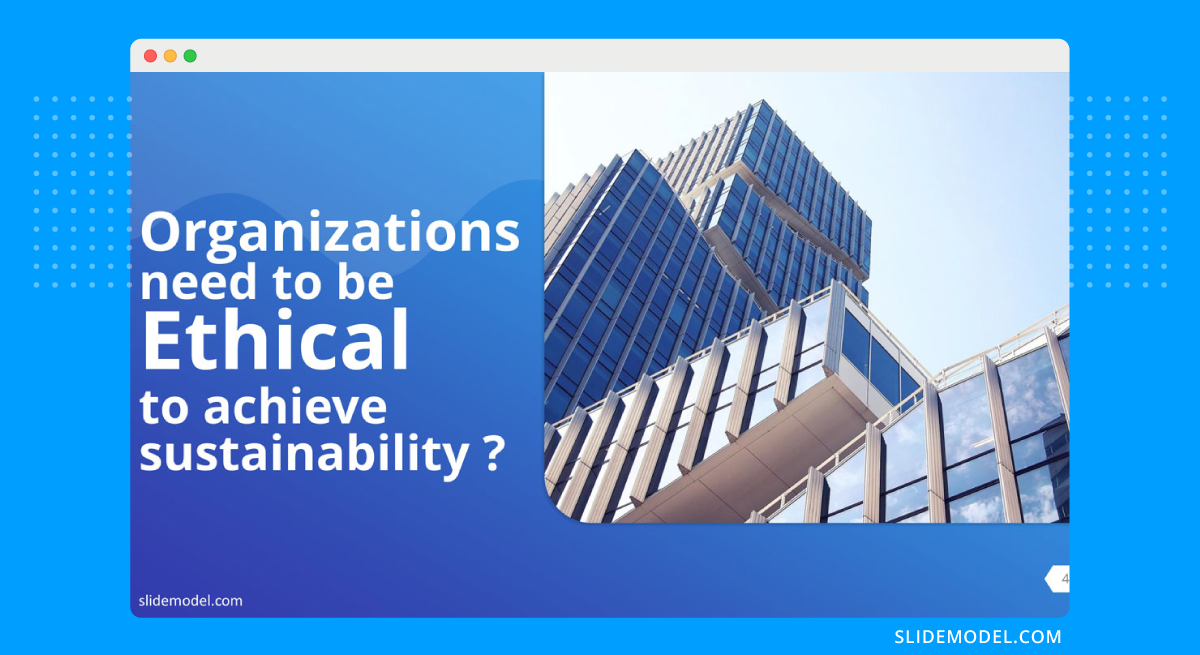
2. Disclose Your Methods
Whether you are doing a science poster presentation or conference talk, many audience members would be curious to understand how you arrived at your results. Deliver this information at the beginning of your presentation to avoid any ambiguities.
Here’s how to organize your science methods on a presentation:
- Do not use bullet points or full sentences. Use diagrams and structured images to list the methods
- Use visuals and iconography to use metaphors where possible.
- Organize your methods by groups e.g. quantifiable and non-quantifiable
Finally, when you work on visuals for your presentation — charts, graphs, illustrations, etc. — think from the perspective of a subject novice. Does the image really convey the key information around the subject? Does it help break down complex ideas?
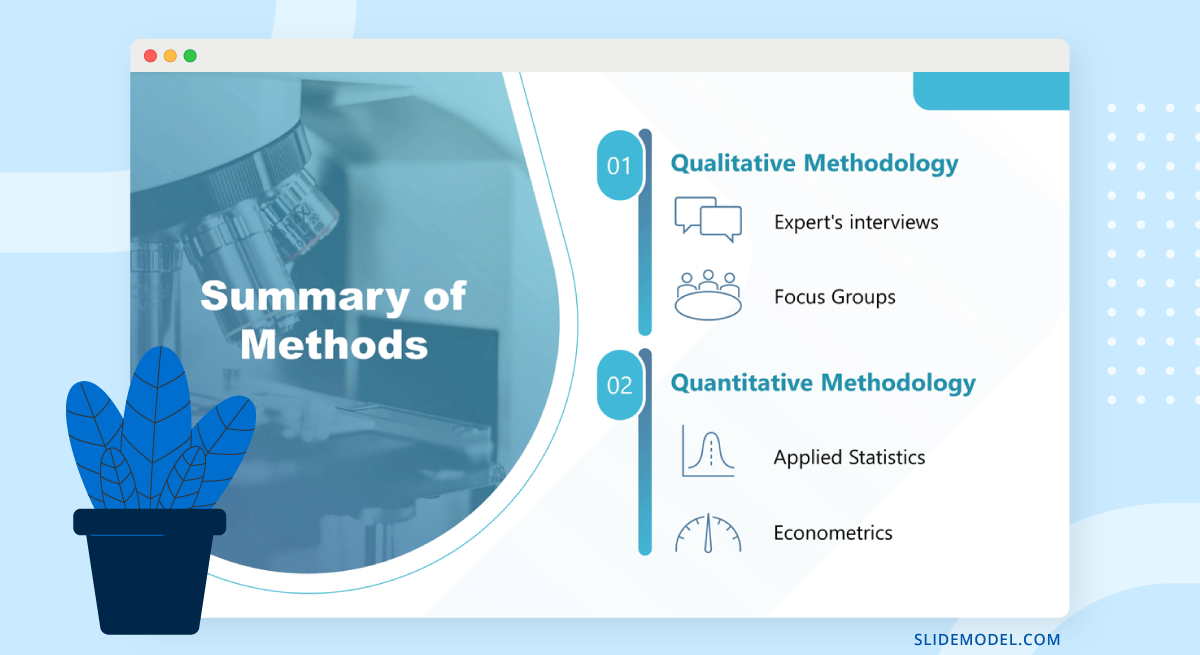
3. Spotlight the Results
Obviously, the research results will be your biggest bragging right. However, don’t over-pack your presentation with a long-winded discussion of your findings and how revolutionary these may be for the community.
Rather than writing a wall of text, do this instead:
- Use graphs with large axis values/numbers to showcase the findings in great detail
- Prioritize formats that are known to everybody (e.g. odds ratios, Kaplan Meier curves, etc.)
- Do not include more than 5 lines of plain text per slide
Overall, when you feel that the results slide gets too cramped, it’s best to move the data to a new one.
Also, as you work on organizing data on your scientific presentation PowerPoint template , think if there are obvious limitations and gaps. If yes, make sure you acknowledge them during your speech.
4. Mention Study Limitations
The scientific method mandates objectivity. That’s why every researcher must clearly state what was excluded from their study. Remember: no piece of scientific research is truly universal and has certain boundaries. However, when you fail to personally state those, others might struggle to draw the line themselves and replicate your results. Then, if they fail to do so, they’d question the viability of your research.
5. Conclude with a Memorable Takeaway Message
Every experienced speaker will tell you that the audience best retains the information they hear first and last. Most people will attend more than one scientific presentation during the day.
So if you want the audience to better remember your talk, brainstorm a take-home message for the last slide of your presentation. Think of your last slide texts as an elevator pitch — a short, concluding message, summarizing your research.
To Conclude
Today we have no shortage of research and scientific methods for testing and proving our hypothesis. However, unlike our ancestors, most scientists experience deeper scrutiny when it comes to presenting and explaining their findings to others. That’s why it’s important to ensure that your scientific presentation clearly relays the aim, vector, and thought process behind your research.
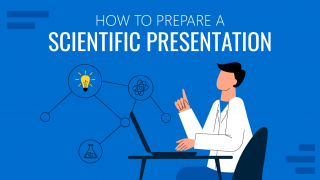
Like this article? Please share
Education, Presentation Ideas, Presentation Skills, Presentation Tips Filed under Education
Related Articles

Filed under Google Slides Tutorials • March 22nd, 2024
How to Share a Google Slides Presentation
Optimize your presentation delivery as we explore how to share a Google Slides presentation. A must-read for traveling presenters.

Filed under Presentation Ideas • February 15th, 2024
How to Create a 5 Minutes Presentation
Master the art of short-format speeches like the 5 minutes presentation with this article. Insights on content structure, audience engagement and more.

Filed under Design • January 24th, 2024
How to Plan Your Presentation Using the 4W1H & 5W1H Framework
The 4W1H and 5W1H problem-solving frameworks can benefit presenters who look for a creative outlook in presentation structure design. Learn why here.
Leave a Reply
Thank you for visiting nature.com. You are using a browser version with limited support for CSS. To obtain the best experience, we recommend you use a more up to date browser (or turn off compatibility mode in Internet Explorer). In the meantime, to ensure continued support, we are displaying the site without styles and JavaScript.
- View all journals
- Explore content
- About the journal
- Publish with us
- Sign up for alerts
- CAREER GUIDE
- 01 December 2021
How to tell a compelling story in scientific presentations
- Bruce Kirchoff 0
Bruce Kirchoff is a botanist and storyteller at the University of North Carolina at Greensboro in North Carolina, USA. His new book is Presenting Science Concisely .
You can also search for this author in PubMed Google Scholar
You have full access to this article via your institution.
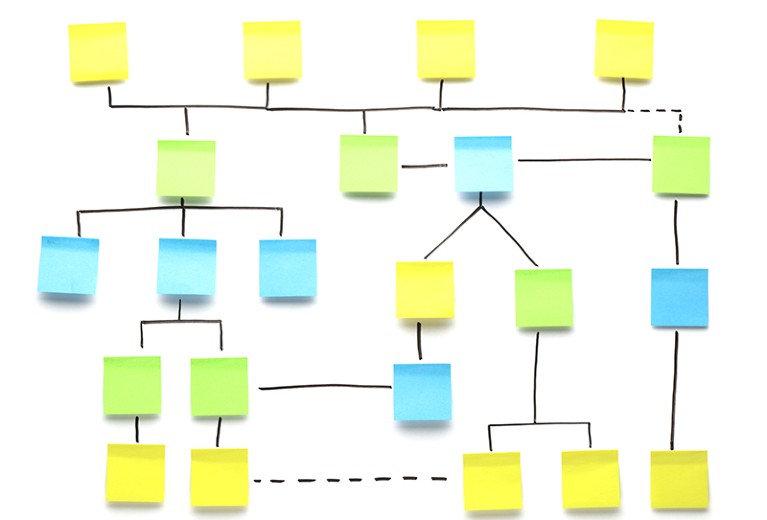
Structuring your presentations with care can help you to clearly communicate to your audience. Credit: Getty
Scientific presentations are too often boring and ineffective. Their focus on techniques and data do not make it easy for the audience to understand the main point of the research.
If you want to reach beyond the narrow group of scientists who work in your specific area, you need to tell your audience members why they should be interested. Three things can help you to be engaging and convey the importance of your research to a wide audience. I had been teaching scientific communication for several years when I was approached to write a book about improving scientific presentations 1 . These are my three most important tips.
State your main finding in your title
The best titles get straight to the point. They tell the audience what you found, and they let them know what your talk will be about. Throughout this article, I will use titles from Nature papers published in the past two years as examples that will stand in for presentation titles. This is because Nature articles have a similar goal of attempting to make discipline-specific research available to a broader audience of scientists. Take, for example: ‘Supply chain diversity buffers cities against food shocks’ 2 .
A great title tells the reader exactly what’s new and precisely conveys the main result, as this one demonstrates. A more conventional title would have been ‘Effect of supply chain diversity on food shocks’, which omits the direction of the effect — so mainly scientists who are interested in your research area will be attracted to the talk. Others will wonder whether the talk will be a waste of time: maybe there was no effect at all.

Collection: Careers toolkit
Another example of a good title is: ‘Organic management promotes natural pest control through altered plant resistance to insects’ 3 .
This title ensures that the audience members know that the talk will be about the beneficial effects of organic crop management before they hear it. They also know that organic management increases plant resistance to insects. This title is much better than one such as: ‘Effects of organic pest management on plant insect resistance’. This title tells the audience the general area of the talk but does not give them the main result.
Finally, look at: ‘A highly magnetized and rapidly rotating white dwarf as small as the Moon’ 4 .
Good titles can just as easily be written for descriptive work as for experimental results. All you need to do is tell your audience what you found. Be as specific as possible. Compare this title with a more conventional one for the same work: ‘Use of the Zwicky Transient Facility to search for short period objects below the main white dwarf cooling sequence’. This title might be of interest to astronomers interested in using this facility, but is unlikely to attract anyone beyond them.
‘But’ is good — use it for dramatic effect
The contradiction implied by the word ‘but’ is one of the most powerful tools a scientist can use 5 . Contradictions introduce problems and provide dramatic effect, tension and a reason to keep listening.
Without such contradictions, the talk will consist of a bunch of results strung together in a seemingly endless and mind-numbing list. We can think of this list as a series of ‘and’ statements: “We did this and this and ran this experiment and found this result and . . . and . . . and.”
Contrast this with a structure that begins with a few important facts, tethered by ands, and then introduces the problem to be solved. Finally, ‘therefore’ can introduce results or subsequent actions. That structure would look like this: ‘X is the current state of knowledge, and we know Y. But Z problem remains. Therefore, we carried out ABC research.’ The introduction of even one contradiction wakes up people in the audience and helps them to focus on the results.
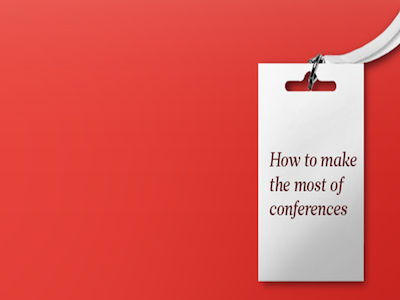
Collection: Conferences
A paper published earlier this year on SARS-CoV-2 and host protein synthesis provides an excellent example of the narrative form using ‘and’, ‘but’ and ‘therefore’ 6 . In the example below, I have shortened the abstract and simplified the transitions, but maintained the authors’ original structure 6 . Although they did not use ‘but’ or ‘therefore’ in their abstract, the existence of these terms is clearly implied. I have made them explicit in the following rendition.
“Coronaviruses have developed a variety of mechanisms to repress host messenger RNA translation and to allow the translation of viral mRNA and block the cellular immune response. But a comprehensive picture of the effects of SARS-CoV-2 infection on cellular gene expression is lacking. Therefore, we combine RNA sequencing, ribosome profiling and metabolic labelling of newly synthesized RNA to comprehensively define the mechanisms that are used by SARS-CoV-2 to shut off cellular protein synthesis.”
In this example, background information is given in the first sentence, linked by a series of conjunctions. Then the problem is introduced — this is the contradiction that comes with ‘but’. The solution to this problem is given in the next sentence (and introduced by using ‘therefore’). This structure makes the text interesting. It will do the same for your presentations.
Use repeated problems and solutions to create a story
Use the power of contradiction to maintain audience engagement throughout your talk. You can string together a series of problems and solutions (buts and therefores) to create a story that leads to your main result. The result highlighted in your title will help you to focus your talk so that the solutions you present lead to this overarching result.
Here is the general pattern:
1. Present the first part of your results.
2. Introduce a problem that remains.
3. Provide a solution to this problem by presenting more results.
4. Introduce the next problem.
5. Present the results that address this problem.
6. Continue this ‘problem and solution’ process through your presentation.
7. End by restating your main finding and summarize how it arises from your intermediate results.
The SARS-CoV-2 abstract 6 uses this pattern of repeated problems (buts) and solutions (therefores). I have modified the wording to clarify these sections.
1. Result 1: SARS-CoV-2 infection leads to a global reduction in translation, but we found that viral transcripts are not preferentially translated.
2. Problem 1: How then does viral mRNA comes to dominate the mRNA pool?
3. Solution 1: Accelerated degradation of cytosolic cellular mRNAs facilitates viral takeover of the mRNA pool in infected cells.
4. Problem 2: How is the translation of induced transcripts affected by SARS-CoV-2 infection?
5. Solution 2: The translation of induced transcripts (including innate immune genes) is impaired.
6. Problem 3: How is translation impaired? What is the mechanism?
7. Solution 3: Impairment is probably mediated by inhibiting the export of nuclear mRNA from the nucleus, which prevents newly transcribed cellular mRNA from accessing ribosomes.
8. Final summary: Our results demonstrate a multipronged strategy used by SARS-CoV-2 to take over the translation machinery and suppress host defences.
Using these three basic tips, you can create engaging presentations that will hold the attention of your audience and help them to remember you. For young scientists, especially, that is the most important thing the audience can take away from your talk.
Nature 600 , S88-S89 (2021)
doi: https://doi.org/10.1038/d41586-021-03603-2
This article is part of Nature Events Guide , an editorially independent supplement. Advertisers have no influence over the content.
This is an article from the Nature Careers Community, a place for Nature readers to share their professional experiences and advice. Guest posts are encouraged .
Kirchoff, B. Presenting Science Concisely (CABI, 2021).
Google Scholar
Gomez, M., Mejia, A., Ruddell, B. L. & Rushforth, R. R. Nature 595 , 250–254 (2021).
Article Google Scholar
Blundell, R. et al. Nature Plants 6 , 483–491 (2020).
Article PubMed Google Scholar
Caiazzo, I. et al. Nature 595 , 39–42 (2021).
Olson, R. The Narrative Gym (Prairie Starfish Press, 2020).
Finkel, Y. et al. Nature 594 , 240–245 (2021).
Download references
Competing Interests
B.K. receives royalties for his book, which this article is based on.
Related Articles

Partner content: Scientific Conferences to fuel new ideas and the next generation of scientists
Partner content: Wellcome Connecting Science: A global provider of genomics learning and training
- Conferences and meetings

‘Woah, this is affecting me’: why I’m fighting racial inequality in prostate-cancer research
Career Q&A 20 MAR 24

So … you’ve been hacked
Technology Feature 19 MAR 24

Four years on: the career costs for scientists battling long COVID
Career Feature 18 MAR 24

How to stop ‘passing the harasser’: universities urged to join information-sharing scheme
News 18 MAR 24

People, passion, publishable: an early-career researcher’s checklist for prioritizing projects
Career Column 15 MAR 24

China promises more money for science in 2024
News 08 MAR 24

One-third of Indian STEM conferences have no women
News 15 NOV 23

How remote conferencing broadened my horizons and opened career paths
Career Column 04 AUG 23
Postdoctoral Associate
Our laboratory at the Washington University in St. Louis is seeking a postdoctoral experimental biologist to study urogenital diseases and cancer.
Saint Louis, Missouri
Washington University School of Medicine Department of Medicine
Recruitment of Global Talent at the Institute of Zoology, Chinese Academy of Sciences (IOZ, CAS)
The Institute of Zoology (IOZ), Chinese Academy of Sciences (CAS), is seeking global talents around the world.
Beijing, China
Institute of Zoology, Chinese Academy of Sciences (IOZ, CAS)
Postdoctoral Fellow-Proteomics/Mass Spectrometry
Location: Tulane University School of Medicine, New Orleans, LA, USA Department: Biochemistry and Molecular Biology Tulane University School of Med...
New Orleans, Louisiana
Tulane University School of Medicine (SOM)
Open Faculty Position in Mathematical and Information Security
We are now seeking outstanding candidates in all areas of mathematics and information security.
Dongguan, Guangdong, China
GREAT BAY INSTITUTE FOR ADVANCED STUDY: Institute of Mathematical and Information Security
Faculty Positions in Bioscience and Biomedical Engineering (BSBE) Thrust, Systems Hub, HKUST (GZ)
Tenure-track and tenured faculty positions at all ranks (Assistant Professor/Associate Professor/Professor)
The university is situated in the heart of the Guangdong-Hong Kong-Macau Greater Bay Area, a highly active and vibrant region in the world.
The Hong Kong University of Science and Technology (Guangzhou)
Sign up for the Nature Briefing newsletter — what matters in science, free to your inbox daily.
Quick links
- Explore articles by subject
- Guide to authors
- Editorial policies
Reference management. Clean and simple.
5 tips for giving a good scientific presentation

What is a scientific presentation?
What is the objective of a scientific presentation, why is giving scientific presentations necessary, how to give a scientific presentation, tip 1: prepare during the days leading up to your talk, tip 2: deal with presentation nerves by practicing simple exercises, tip 3: deliver your talk with intention, tip 4: be adaptable and willing to adjust your presentation, tip 5: conclude your talk and manage questions confidently, concluding thoughts, other sources to help you give a good scientific presentation, frequently asked questions about giving scientific presentations, related articles.
You have made the slides for your scientific presentation. Now, you need to prepare to deliver your talk. But, giving an oral scientific presentation can be nerve-wracking. How do you ensure that you deliver your talk well, and leave a good impression on the audience?
Mastering the skill of giving a good scientific presentation will stand you in good stead for the rest of your career, as it may lead to new collaborations or even new employment opportunities.
In this guide, you’ll find everything you need to know to give a good oral scientific presentation, including
- Why giving scientific presentations is important for your career;
- How to prepare before giving a scientific presentation;
- How to keep the audience engaged and deliver your talk with confidence.
The following tips are a product of our research into the literature on giving scientific presentations as well as our own experiences as scientists in giving and attending talks. We advise on how to make a scientific presentation in another post.
A scientific presentation is a talk or poster where you describe the findings of your research to others. An oral presentation usually involves presenting slides to an audience. You may give an oral scientific presentation at a conference, give an invited seminar at another institution, or give a talk as part of an interview. A PhD thesis defense is one type of scientific presentation.
➡️ Read about how to prepare an excellent thesis defense
The objective of a scientific presentation is to communicate the science such that the audience:
- Learns something new;
- Leaves with a clear understanding of the key message of your research;
- Has confidence in you and your work;
- Remembers you afterward for the right reasons.

As a scientist, one of your responsibilities is disseminating your scientific knowledge by giving presentations. Communicating your research to others is an altruistic act, as it is an opportunity to teach others about your research findings, and the knowledge you have gained while researching your topic.
Giving scientific presentations confers many career benefits , such as:
- Having the opportunity to share your ideas and to have insightful conversations with other scientists. For example, a thoughtful question may create a new direction for your research.
- Gaining recognition for your work and generating excitement for your research program can help you to forge new collaborations and to obtain more citations of your papers. It's your chance to impress some of the biggest names in your field, build your reputation as a scientist, and get more people interested in your work.
- Improving your future employment prospects by getting presentation experience in high-stakes settings and by having talks listed on your academic CV.
➡️ Learn how to write an academic CV
You might have just 10 minutes for your talk. But those 10 minutes are your golden ticket. To make them shine, you'll need to put in some homework. You need to think about the story you want to tell , create engaging slides , and practice how you're going to deliver it.
Why all this effort? Because the rewards are potentially huge. Imagine speaking to the top names in your field, boosting your visibility, and getting more eyes on your work. It's more than just a talk; it's your chance to showcase who you are and what you do.
Here we share 5 tips for giving effective scientific presentations.
- Prepare adequately for your talk on the days leading up to it
- Deal with presentation nerves
- Deliver your talk with intention
- Be adaptable
- Conclude your talk with confidence
You should prepare for your talk with the seriousness it deserves and recognize the potential it holds for your career advancement. Here are our suggestions:
- Rehearse your talk multiple times to ensure smooth flow. Know the order of your slides and key transitions without memorizing every word. Practice your speech as though you are discussing with friendly and attentive listeners.
- Record your speech and listen back to yourself giving your talk while doing household chores or while going for a walk. This will help you remember the important points of your talk and feel more comfortable with the flow of it on the day.
- Anticipate potential questions that may arise during your talk, write down your responses to those questions, and practice them aloud.
- Back up your presentation in cloud storage and on a USB key. Bring your laptop with you on the day of your talk, if needed.
- Know the time and location of your talk. Familiarize yourself with the room, if you can. Introduce yourself to the moderator before the session begins.
- Giving a talk is a performance, so preparing yourself physically and mentally is essential. Prioritize good sleep and hydration, and eat healthy, nourishing food on the day of your talk. Plan your attire to be both professional and comfortable.
It’s natural to feel nervous before your talk, but you want to harness that energy to present your work with confidence. Here are some ways to manage your stress levels:
- Remember that your audience want to listen to you and learn from you. Believe that your audience will be kind, friendly, and interested, rather than bored and skeptical.
- Breathing slow and deep before your talk calms the mind and nervous system. Psychologist Amy Cuddy recommends practicing open, confident postures while sitting and standing to help you get into a positive frame of mind.
- Fight off impostor syndrome with positive affirmations. You’ve got this! Remember that you know more about your research than anyone else in the room and you are giving your talk to teach others about it.
Giving your talk with confidence is crucial for your credibility as a scientist. Focusing on your delivery helps ensure that your audience remembers and believes what you say. Here are some techniques to try:
- Before beginning, remember your professional goals and the benefits of giving your presentation. Start with a smile and exhale deeply.
- Memorize a simple opening. After the moderator introduces you, pause and take a breath. Welcome the audience, thank them for coming, and introduce yourself. You don’t need to read the title of your talk. But briefly, say something like, “today I’m going to talk to you about why [topic] is important and [what I hope you will learn from this talk]” in 1-2 sentences. Preparing your opening will settle your nerves and prevent you from starting your talk on a tangential topic, ensuring you stay on time.
- Project confidence outwardly, even if you feel nervous. Stand up tall with your shoulders back and make eye contact with individuals in the audience. Move your focus around the room, so everyone in the audience feels included.
- Maintain open body language and face the audience as much as possible, not your slides.
- Project your voice as much as you can so that people at the back of the room can hear you. Enunciate your words, avoid mumbling, and don’t trail off awkwardly.
- Varying your vocal delivery and intonation will make your talk more interesting and help the audience pay attention, particularly when you want to emphasize key points or transitions.
- Pausing for dramatic effect at crucial moments can help you relax and remember your message, as well as being an effective engagement device.
- A laser pointer can be off-putting for the audience if you are prone to having a shaky hand when nervous. Use a laser pointer only to emphasize information on the slide while providing an explanation. If you design your slides thoughtfully , you won’t need to use a laser pointer.
Not all parts of your talk may go according to plan. Here are some ways to adapt to hitches during your talk:
- Handle talk disruptions gracefully. If you make a mistake, or a technical issue occurs during your talk, remember that it’s okay to skip something and move on without apologizing.
- If you forget to mention something but the audience hasn’t noticed, don’t point it out! They don’t need to know.
- As you give your talk, be time-conscious, and watch the moderator for signals that the time is about to expire. If you realize you won’t have time to discuss all your slides, skip the less important ones. Adjust your presentation on the fly to finish on time, prioritizing content as needed.
- If you run out of time completely, just stop. You don’t have to give a conclusion, but you do need to stop on time! Practicing your talk should prevent this situation.
The ending of your talk is important for emphasizing your key message and ensuring the audience leave with a positive impression of you and your work. Here are some pointers.
- Conclude your talk with a memorized closing statement that summarizes the key take-home message of your research. After making your closing statement, end your talk with a simple “Thank you”. Then pause and wait for the applause. You don’t need to ask if the audience has questions because the moderator will call for questions on your behalf.
- When you receive a question, pause, then repeat the question. This ensures the whole audience understands the question and gives you time to calmly consider your answer.
- In a talk on attaining confidence in your scientific presentations, Michael Alley suggests that if you don’t know the answer to the question, then emphasize what you do know. Say something like, “Although I can’t fully answer your question, I can say [this about the topic].”
- Approach the Q&A with interest rather than anxiety by reframing it as an opportunity to further share your knowledge. Being curious, instead of feeling fearful, can help you shine during what might be the most stressful part of your presentation.
Communicating your research effectively is a key skill for early career scientists to learn. Taking ample time to prepare and practice your presentation is an investment in your scientific development.
But here's the good part: all that effort pays off. Think of your talk as not just a presentation, but as a way to show off what you and your research are all about. Giving a compelling scientific presentation will raise your professional profile as a scientist, lead to more citations of your work, and may even help you obtain a future academic job.
But most importantly of all, giving talks contributes to science, and sharing your knowledge is an act of generosity to the scientific community.
➡️ Questions to ask yourself before you make your talk
➡️ How to give a great scientific talk
1) Have a positive mindset. To help with nerves, breathe deeply and keep in mind that you are an authority on your topic. 2) Be prepared. Have a short list of points for each slide and know the key transition points of your talk. Practice your talk to ensure it flows smoothly. 3) Be well-rested before your talk and eat a light meal on the day of your presentation. A talk is a performance. 4) Project your voice and vary your vocal intonation and pitch to retain the interest of the audience. Take pauses at key moments, for emphasis. 5) Anticipate questions that audience members could ask, and prepare answers for them.
The goal of a scientific presentation is that the audience remembers the key outcomes of your research and that they leave with a good impression of you and your science.
Take a moment to exhale deeply and collect your thoughts after the moderator has introduced you. Don’t read your talk's title. Instead, introduce yourself, thank the audience for attending, and provide a warm welcome. Then say something along the lines of, "Today I'm going to talk to you about why [topic] is important and [what I hope you will learn from this presentation].” A rehearsed opening will ensure that you start your talk on a confident note.
Prepare a memorable closing statement that emphasizes the key message of your talk. Then end with a simple “Thank you”.
Preparation is key. Practice many times to familiarize yourself with the content of your presentation. Before giving your talk, breathe slowly and deeply, and remind yourself that you are the expert on your topic. When giving your talk, stand up tall and use open body language. Remember to project your voice, and make eye contact with members of the audience.

This website uses cookies to improve your user experience. By continuing to use the site, you are accepting our use of cookies. Read the ACS privacy policy.
- ACS Publications
10 Keys to an Engaging Scientific Presentation
- May 31, 2018
What makes an engaging scientific presentation? Georgia Tech Professor Will Ratcliff uses a method based on the style of nature documentary presenter David Attenborough. Ratcliff’s approach looks to capture an audience’s natural curiosity by using engaging visuals and simple storytelling techniques. Here are his 10 keys to an engaging scientific presentation: 1) Be an Entertainer First: […]

What makes an engaging scientific presentation? Georgia Tech Professor Will Ratcliff uses a method based on the style of nature documentary presenter David Attenborough. Ratcliff’s approach looks to capture an audience’s natural curiosity by using engaging visuals and simple storytelling techniques.
Here are his 10 keys to an engaging scientific presentation:
1) Be an Entertainer First : Before your science can wow your audience, they have to understand it. Before they can understand it, you must engage them with what you’re saying. Look at your presentation from your audience’s perspective and think about how they’ll relate to your material. Focus on presenting your science in a way that engages and entertains as it explains.
2) Be a Storyteller, Not a Lecturer : Don’t assume that your audience knows your field. Tell the story of your science: identify the big picture backdrop, your specific research questions, how you answer those questions, and how it affects the way we now think about the big picture.
3) Prioritize Clarity : If the audience doesn’t understand every word you use, they’ll stop paying attention, and you may never win them back. Your goal is to never lose their attention in the first place, so make an effort to be clear and have a simple narrative arc to your talk.
4) Mind Your Transitions: The easiest place to lose your audience’s focus is when you move from one slide to another. Practice the transitions in your talk to make sure the link between the ideas of one slide and the next remains clear.
5) Keep Complete Sentences Out of Your Slides: Keep the text in your slides to a minimum. Instead, use compelling visual to hold your audience’s attention while you speak.
6) Animations Are Your Friend: You can use animations to reveal new details on your slide as they become relevant to what you are saying. That way you get to control what your audience is seeing, minimizing distraction and putting laser pointers out of a job. Note: never use silly and unnecessary animations, like spinning or scrolling text, this will just annoy your audience.
7) Get Excited: If you’re not excited and energetic about your work, your audience won’t be either.
8) Look at the Audience: Don’t stare at the floor, the ceiling, or your slides while you’re presenting. Look directly at your audience, or if you’re nervous, toward the back of the lecture hall. This will help you connect with your audience.
9) Be Wary of Jokes: Scientific talks are serious by nature and you have more to lose than to gain. If a joke is poorly timed or if you misjudge an audience, you risk alienating them. Play it safe and find other ways to be entertaining unless you know your audience well.
10) Leave the Laser Pointer at Home: Laser pointers are distracting. If you feel you need one to guide your audience through a slide, that’s a sign your slide is too cluttered.
Want More Tips on Giving an Engaging Scientific Presentation? Check Out: 3 Elements of a Great Scientific Talk
Want the latest stories delivered to your inbox each month.
- Program Design
- Peer Mentors
- Excelling in Graduate School
- Oral Communication
- Written communication
- About Climb
A 10-15 Minute Scientific Presentation, Part 1: Creating an Introduction
For many young scientists, the hardest part of a presentation is the introduction. How do you set the stage for your talk so your audience knows exactly where you're going?
Here's how: follow the the CCQH pattern -- C ontext, C omplication, Q uestion, H ypothesis. Fit your research into this pattern, and you will be able to introduce your work in just a few minutes, using just 1 or 2 slides.
The video below show how to use the CCQH pattern using an example of published scientific research. You will see how powerful -- and how adapatable -- the CCQH pattern is.
Make sure you select 720p HD on the video (bottom right corner) for best resolution and so scientific illustrations and figures are clear.
You can also find this video, and others related to scientific communication, at the CLIMB youtube channel: http://www.youtube.com/climbprogram
Quick Links
Northwestern bioscience programs.
- Biomedical Engineering (BME)
- Chemical and Biological Engineering (ChBE)
- Driskill Graduate Program in the Life Sciences (DGP)
- Interdepartmental Biological Sciences (IBiS)
- Northwestern University Interdepartmental Neuroscience (NUIN)
- Campus Emergency Information
- Contact Northwestern University
- Report an Accessibility Issue
- University Policies
- Northwestern Home
- Northwestern Calendar: PlanIt Purple
- Northwestern Search
Chicago: 420 East Superior Street, Rubloff 6-644, Chicago, IL 60611 312-503-8286
- PRO Courses Guides New Tech Help Pro Expert Videos About wikiHow Pro Upgrade Sign In
- EDIT Edit this Article
- EXPLORE Tech Help Pro About Us Random Article Quizzes Request a New Article Community Dashboard This Or That Game Popular Categories Arts and Entertainment Artwork Books Movies Computers and Electronics Computers Phone Skills Technology Hacks Health Men's Health Mental Health Women's Health Relationships Dating Love Relationship Issues Hobbies and Crafts Crafts Drawing Games Education & Communication Communication Skills Personal Development Studying Personal Care and Style Fashion Hair Care Personal Hygiene Youth Personal Care School Stuff Dating All Categories Arts and Entertainment Finance and Business Home and Garden Relationship Quizzes Cars & Other Vehicles Food and Entertaining Personal Care and Style Sports and Fitness Computers and Electronics Health Pets and Animals Travel Education & Communication Hobbies and Crafts Philosophy and Religion Work World Family Life Holidays and Traditions Relationships Youth
- Browse Articles
- Learn Something New
- Quizzes Hot
- This Or That Game New
- Train Your Brain
- Explore More
- Support wikiHow
- About wikiHow
- Log in / Sign up
- Education and Communications
How to Present a Science Project
Last Updated: August 17, 2023 Fact Checked
This article was co-authored by Meredith Juncker, PhD . Meredith Juncker is a PhD candidate in Biochemistry and Molecular Biology at Louisiana State University Health Sciences Center. Her studies are focused on proteins and neurodegenerative diseases. This article has been fact-checked, ensuring the accuracy of any cited facts and confirming the authority of its sources. This article has been viewed 52,928 times.
After creating a science project , you’ll likely have to present your work to your class or at a science fair. Try to give yourself a few weeks to plan and put together your presentation. Outline your main points, make note cards, and practice ahead of time. Make a clear, neat display board or PowerPoint presentation. When it comes time to present, relax, speak clearly and loudly, and avoid reading your presentation word for word.
Putting Together Your Presentation

- Finish up your experiment, research, and other aspects of your project.
- Get the materials you’ll need for your display board.
- Start to imagine how you’ll organize your information.

- An introduction to your topic or the problem you’ve addressed.
- How the problem impacts the real world (such as how a better understanding of the issue can impact humans).
- Your hypothesis, or what you expected to learn about through your experiment.
- The research you did to learn more about your topic.
- The Materials that you used in your project.
- Each step of your experiment’s procedure.
- The results of your experiment.
- Your conclusion, including what you learned and whether your data supports your hypothesis.

- When writing your speech, try to keep it simple, and avoid using phrases that are more complicated than necessary. Try to tailor the presentation to your audience: will you be presenting to your class, judges, a higher grade than yours, or to an honors class?
- Writing out your presentation can also help you manage your time. For example, if you’re supposed to talk for less than five minutes, shoot for less than two pages.

- For example, if you've made a volcano, make sure you know the exact mix of chemicals that will create the eruption.

Creating Your Display Board

- When you purchase your board, you should also acquire other materials, like a glue stick, construction paper, a pencil, markers, and a ruler.

- Consider using the top left corner for your topic introduction, the section under that for your hypothesis, and the bottom left section to discuss your research.
- Use the top right corner to outline your experiment’s procedure. List your results underneath, and finally, put the section with your conclusion under the results.

- Be sure to use a dark font color that’s easy to see from a distance.
- You can also write everything out by hand. Draft your lettering in pencil before using a pen or marker, and use a ruler to make sure everything is straight.

- Before gluing anything, make sure you plan out each section’s position and are sure everything will fit without looking cluttered. Use rulers to make sure everything is positioned evenly.

- Consider including 1 slide for each section, like 1 for the title of your project, 1 for your hypothesis, and 1 that outlines each main point of your research. If a slide becomes too dense, break it down by concept.
- Limit the text to 1 line and include a visual aid, like an image or a graph, that demonstrates the concept or explains the data. [6] X Research source
Giving a Great Presentation

- Take the time to iron your clothes and tuck your shirt in to avoid looking sloppy.

- It’s a good idea to use the restroom before you have to present your project.

- It can be really hard to resist, but try to avoid saying “um” or “uh” during your presentation.
- Speaking when you have a dry mouth can be difficult, so it’s a good idea to keep a water bottle handy.

- Remember it’s better to be honest if you don't know how to answer a question instead of making something up. Ask the person who asked the question to repeat or rephrase it, or say something like, "That's certainly an area I can explore in more detail in the future."
Community Q&A
You Might Also Like

- ↑ https://www.opencolleges.edu.au/informed/teacher-resources/science-fair-projects/#sciencefairpresentation
- ↑ https://www.youtube.com/watch?v=4KVTLT6QeTE
- ↑ https://www.youtube.com/watch?v=NHXidlH-dBw
- ↑ https://www.youtube.com/watch?v=g3hT6Ocf39w
- ↑ https://www.sciencebuddies.org/science-fair-projects/science-fair/judging-tips-to-prepare-science-fair
About This Article

- Send fan mail to authors
Reader Success Stories
Shruti Choudhary
Dec 17, 2017
Did this article help you?
Dec 11, 2017
Dec 5, 2016
Feb 5, 2017
Oct 13, 2017

Featured Articles

Trending Articles

Watch Articles

- Terms of Use
- Privacy Policy
- Do Not Sell or Share My Info
- Not Selling Info
wikiHow Tech Help Pro:
Develop the tech skills you need for work and life

Princeton Correspondents on Undergraduate Research
How to Make a Successful Research Presentation
Turning a research paper into a visual presentation is difficult; there are pitfalls, and navigating the path to a brief, informative presentation takes time and practice. As a TA for GEO/WRI 201: Methods in Data Analysis & Scientific Writing this past fall, I saw how this process works from an instructor’s standpoint. I’ve presented my own research before, but helping others present theirs taught me a bit more about the process. Here are some tips I learned that may help you with your next research presentation:
More is more
In general, your presentation will always benefit from more practice, more feedback, and more revision. By practicing in front of friends, you can get comfortable with presenting your work while receiving feedback. It is hard to know how to revise your presentation if you never practice. If you are presenting to a general audience, getting feedback from someone outside of your discipline is crucial. Terms and ideas that seem intuitive to you may be completely foreign to someone else, and your well-crafted presentation could fall flat.
Less is more
Limit the scope of your presentation, the number of slides, and the text on each slide. In my experience, text works well for organizing slides, orienting the audience to key terms, and annotating important figures–not for explaining complex ideas. Having fewer slides is usually better as well. In general, about one slide per minute of presentation is an appropriate budget. Too many slides is usually a sign that your topic is too broad.

Limit the scope of your presentation
Don’t present your paper. Presentations are usually around 10 min long. You will not have time to explain all of the research you did in a semester (or a year!) in such a short span of time. Instead, focus on the highlight(s). Identify a single compelling research question which your work addressed, and craft a succinct but complete narrative around it.
You will not have time to explain all of the research you did. Instead, focus on the highlights. Identify a single compelling research question which your work addressed, and craft a succinct but complete narrative around it.
Craft a compelling research narrative
After identifying the focused research question, walk your audience through your research as if it were a story. Presentations with strong narrative arcs are clear, captivating, and compelling.
- Introduction (exposition — rising action)
Orient the audience and draw them in by demonstrating the relevance and importance of your research story with strong global motive. Provide them with the necessary vocabulary and background knowledge to understand the plot of your story. Introduce the key studies (characters) relevant in your story and build tension and conflict with scholarly and data motive. By the end of your introduction, your audience should clearly understand your research question and be dying to know how you resolve the tension built through motive.

- Methods (rising action)
The methods section should transition smoothly and logically from the introduction. Beware of presenting your methods in a boring, arc-killing, ‘this is what I did.’ Focus on the details that set your story apart from the stories other people have already told. Keep the audience interested by clearly motivating your decisions based on your original research question or the tension built in your introduction.
- Results (climax)
Less is usually more here. Only present results which are clearly related to the focused research question you are presenting. Make sure you explain the results clearly so that your audience understands what your research found. This is the peak of tension in your narrative arc, so don’t undercut it by quickly clicking through to your discussion.
- Discussion (falling action)
By now your audience should be dying for a satisfying resolution. Here is where you contextualize your results and begin resolving the tension between past research. Be thorough. If you have too many conflicts left unresolved, or you don’t have enough time to present all of the resolutions, you probably need to further narrow the scope of your presentation.
- Conclusion (denouement)
Return back to your initial research question and motive, resolving any final conflicts and tying up loose ends. Leave the audience with a clear resolution of your focus research question, and use unresolved tension to set up potential sequels (i.e. further research).
Use your medium to enhance the narrative
Visual presentations should be dominated by clear, intentional graphics. Subtle animation in key moments (usually during the results or discussion) can add drama to the narrative arc and make conflict resolutions more satisfying. You are narrating a story written in images, videos, cartoons, and graphs. While your paper is mostly text, with graphics to highlight crucial points, your slides should be the opposite. Adapting to the new medium may require you to create or acquire far more graphics than you included in your paper, but it is necessary to create an engaging presentation.
The most important thing you can do for your presentation is to practice and revise. Bother your friends, your roommates, TAs–anybody who will sit down and listen to your work. Beyond that, think about presentations you have found compelling and try to incorporate some of those elements into your own. Remember you want your work to be comprehensible; you aren’t creating experts in 10 minutes. Above all, try to stay passionate about what you did and why. You put the time in, so show your audience that it’s worth it.
For more insight into research presentations, check out these past PCUR posts written by Emma and Ellie .
— Alec Getraer, Natural Sciences Correspondent
Share this:
- Share on Tumblr

- Google Slides Presentation Design
- Pitch Deck Design
- Powerpoint Redesign
- Other Design Services

- Design Tips
- Guide & How to's
How to prepare a scientific presentation
Putting together a scientific presentation might be a pretty challenging undertaking. However, with careful preparation and planning, it can turn into a rewarding experience.
In this article, we’ll discuss the purpose, presentation methods, and structure of an excellent scientific ppt, as well as share essential tips on how to introduce a scientific presentation, so dive in!

What’s a scientific presentation
A scientific presentation is a formal way to share an observation, propose a hypothesis, show and explain the findings of a study, or summarize what has been discovered or is still to be studied on the subject.
Professional scientific presentations aid in disseminating research and raise peers’ awareness of novel approaches, findings, or issues. They make conferences memorable for both the audience and the presenter.
Presentation methods
The three major presentation methods that are frequently used at large conferences include platform (oral), poster, and lecture presentations. Although appearing seemingly different at times, they all have the same requirements and difficulties for successful execution, and their main prerequisite is you, the presenter.
An effective presenter should have led the research, taken part in the analysis, and written the abstract and manuscript, which means the presenter should be fully knowledgeable about the topic at hand.
Scientific presentation structure
For the majority of scientific presentations, it is advisable to follow the traditional structure:
Title → Introduction/Background → Methods → Results → Discussion → Conclusion → Acknowledgements.
1. Introduction
The main elements that make up the introduction include the background of the study, the research problem, the significance of the research, the research objectives, research questions, and/or hypotheses.
The background is the premise upon which the study’s problem is built. It usually consists of one or two sentences.
After the background usually comes the research problem, which is made up of one or two sentences with clear statements. These can be anything from conflicting findings to a knowledge gap your scientific presentation PowerPoint addresses.
The justification part should briefly outline how the findings will contribute to the problem’s solution. It can also discuss the possible implications of the study in not more than two sentences.
Next comes the purpose of the study, which has to outline your goals and relate to the study’s title.
You may wrap up the introduction by listing the objectives of your study, research questions, or hypotheses. The study’s objectives describe the specific steps that must be taken to accomplish the goal. Please note that the objective can be turned into a research question and a research question, in turn, into a hypothesis.
2. Methodology
This section of your presentation should include a relevant study area map. It is recommended that you adequately describe the research design and use diagrams like flowcharts whenever possible.
Additionally, explain the procedures for obtaining the data for each objective, research question, and hypothesis. Finally, state the statistical analysis procedures used.
3. Results and discussion
An oral presentation will always include both the results and the discussion. However, the slides will only contain the results.
You can use tables and figures together, but they shouldn’t be applied to the same data set.
The results of your scientific PowerPoint presentation have to be organized in the same order as the objectives, research questions, and hypotheses. Still, describing and discussing the obtained results should be done off-head.
During your presentation, explain the findings in the tables and figures, pointing out any patterns. Also, discuss the results by assigning reasons to patterns, comparing the results with earlier research, and offering interpretations and implications for your findings.
4. Conclusion
Your presentation’s final section should offer closing remarks on the study’s key findings, not restate the results. Discuss the findings and their implications and make recommendations for additional research briefly and concisely.
If you include in-text references in your slides, always provide external references on a separate slide.
Prepare your title slide before beginning the research’s introduction section. Your name, your institution or department, the title of the presentation, and its date should all be included on the title slide.
Last but not least, your second slide should include the scientific presentation outline.
3 things to pay attention to when creating a scientific presentation
Color is a powerful tool for setting a pattern. It can make it easier for the reader or the audience to follow you and comprehend the connection between the subjects you are presenting.
According to our design experts, you have to create a natural flow of information and emphasize information that the reader has to see first (e.g., title or main image). Secondary data has to be less prominent, not to take priority. This all can be achieved through colors. Striking colors will quickly grab the audience’s attention. Meanwhile, a grayscale will be more discreet, making it ideal for secondary information.
Pro tip: Select one or two primary colors for your presentation, then use them repeatedly on the slides.
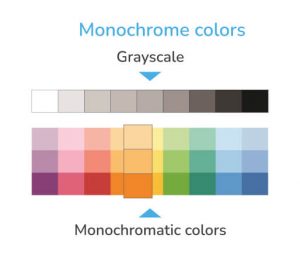
2. Typography
Font selection is crucial for the overall success of your presentation. Therefore, make sure your text is simple to see and read even if the person is sitting a considerable distance from the screen. Separate paragraphs and headings and stick with three different fonts at most (e.g., Helvetica, Gotham).
Remember that your audience will be looking at the slides while you are speaking, so avoid putting too much text on them.
Pro tip: Use a different font for your headline but ensure it doesn’t create the “comic sans” effect.
Visual aids such as charts, graphs, and images are indispensable for effectively conveying information and grabbing the audience’s attention, but you must choose them carefully.
Make sure to move from this to this:
Pro tip: If there’s a diagram, chart, or other visual that you don’t plan to walk your audience through, cut it.
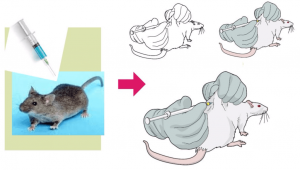
Here’s a good scientific presentation example to follow:
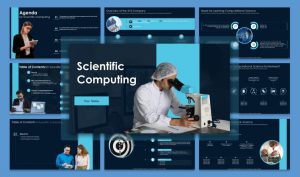
Now that you know how to make a scientific presentation and what to pay attention to when creating one, let’s move on to the scientific presentation tips from the best designers of our professional presentation services .
Top 10 tips on how to present a scientific paper
Tip #1: Know your audience
View the presentation as a dialogue with the audience rather than a monologue, and always consider the interests and expertise of your audience. This will help you tailor your scientific presentation to their level of knowledge and interests.
Tip #2: Make use of PowerPoint
PowerPoint is an excellent tool for presenting scientific research if appropriately used. Generally, this involves inserting a lot of relevant visuals and minimum words with a font size of 24 points and above.
Tip #3: Tell your audience about your research rather than its background
Focus on discussing the research that you are directly contributing to. The background information should only include the bare minimum. People don’t attend conferences to hear a review of previous work. They do so to learn about new and intriguing research, so use the allotted time to your advantage.
Tip #4: Practice and rehearse
Always practice your presentation of science thoroughly before giving it to anyone. By doing so, you’ll gain a better understanding of the material and make sure your presentation flows smoothly.
Tip #5: Keep to the time limit
A basic rule of thumb is to keep your presentation to 80% of the allotted time. If you are given 55 minutes to deliver your presentation, prepare 45 minutes worth of information: 15 minutes for introduction, 25 for the main aspects of your presentation, 5 to summarize and conclude, and leave the last ten for a Q&A session.
A well-done abstract, a set of carefully chosen viewgraphs, a brief “cheat sheet,” and an outline (perhaps placed in the corner of each viewgraph) should all help you stay on track throughout your presentation.
Tip #6: Don’t read from the slides
Reading from slides is commonplace in various fields, but do you really find it interesting to hear someone read their conference presentation? If reading is an absolute must, then our experts advise you to do it in such a way that no one in the audience notices it. Writing your text in a conversational tone and reading with emotion, conviction, and variations in tone is a great trick to achieve that.
Tip #7: Summarize the key points
Reiterate your main message and briefly touch on your main points in your conclusion. By doing so, you can ensure that your audience will remember the most crucial details of your presentation.
Tip #8: Use effective communication techniques
When delivering your presentation, use appropriate body language and effective communication techniques. These include maintaining eye contact with the audience, speaking clearly and at a reasonable volume, and conveying enthusiasm about your work. Remember, genuine enthusiasm accounts for 90% of a speaker’s success.
Tip #9: Engage the audience
Always ask questions and use polls or other interactive tools to interact with your audience and encourage discussion.
Tip #10: Dress for success
When preparing to give a scientific presentation, dress up professionally. This will help convey two crucial messages: you respect your audience and are willing to conform.
Wrapping up
Following the above science presentation structure and tips, you can create clear, informative, and engaging slides that effectively communicate your message to the audience. However, if you’re still wondering how to start a scientific presentation or need a PowerPoint makeover , don’t hesitate to contact our dedicated design experts!
At SlidePeak, we know that building a visually captivating presentation may be a real challenge for researchers and scientists. That’s why we’ve developed several services, including presentation redesign and creation from scratch by qualified scientific, technical, and medical designers who can make your work stand out both in science and creativity.
With over a decade of experience in presentation design, SlidePeak is trusted by thousands of researchers and scientists worldwide. So, submit your scientific presentation order today, and let dedicated experts turn your ideas into professional slides that will help you make an impact!
#ezw_tco-2 .ez-toc-widget-container ul.ez-toc-list li.active::before { background-color: #ededed; } Table of contents
- Presenting techniques
- 50 tips on how to improve PowerPoint presentations in 2022-2023 [Updated]
- Keynote VS PowerPoint
- Types of presentations
- Present financial information visually in PowerPoint to drive results

Crafting an engaging presentation script

- Business Slides
Franchise presentation: what it is and how to create an effective one

Annual report design templates and tips: how to tell a great story with financial data in 2023

Scientific discoveries are the lifeblood of progress, but for those discoveries to have a meaningful impact, they must be effectively communicated to the world. Scientists often find themselves in the role of presenters, tasked with conveying complex ideas, research findings, and insights to diverse audiences. Whether you’re presenting your research to fellow scientists, students, or the general public, the ability to give a captivating and memorable presentation is a vital skill. Yet, giving a science presentation before a live audience is one of life’s greatest stressors. Public speaking is a top fear for almost everyone. Scientists who are non-native English speakers have the added difficulty of language to overcome. With proper preparation, practice, knowledge, and enthusiasm, however, both fear and language difficulties can be conquered and mastered.

Pros and Cons of Using Bullet Points in Your Science Presentation
Bullet points have long been recommended for presentations due to several advantages. They offer clarity and organization by breaking down complex ideas into concise, digestible points, aiding audience comprehension. They serve as visual aids, guiding both presenters and audiences through the presentation’s content. Bullet points also excel at highlighting key information and emphasizing crucial takeaways. Additionally, they enhance readability by presenting information in an easily digestible format, avoiding overwhelming paragraphs.
However, recent years have witnessed a shift away from traditional bullet point-heavy presentations in favor of more engaging and effective techniques. These alternatives encompass visual storytelling, using visuals like images and infographics to convey information more effectively. Less text and more images are favored for visual appeal, while data visualization techniques are adopted for complex data. Minimalist slide design focuses on content rather than distractions, and narrative structures create engaging, memorable stories.

Presentation tips for scientists to improve your public speaking
Know your audience.
The first step to delivering a captivating science presentation is to know your audience. Understanding their background, interests, and level of expertise will allow you to tailor your content and delivery style accordingly. Consider the following:
- Expert Audience : If you are presenting to fellow scientists or experts in your field, you can delve into the technical details of your research. Use specialized terminology and assume a certain level of prior knowledge.
- General Audience : When speaking to a non-expert audience, simplify complex concepts, avoid jargon, and provide context for your research. Use relatable examples and analogies to make your points more accessible.
- Mixed Audience : In some cases, your audience may include both experts and non-experts. Striking a balance between technical depth and accessibility is essential. You can provide a high-level overview for non-experts while offering more detailed information in supplementary materials or during a Q&A session.
Know Your Material and Craft a Clear Message
Of key importance is to know your subject matter well. Be concise and clear in conveying your message without reading a script or slides. Imagine if the power went out and you had to give your presentation without your slides or sound amplification. Yes – a nightmare! When you know your material well enough to teach it to your audience, you can do it in the dark… but this takes practice and rehearsal.
Before you start creating your science presentation, distill your key message or takeaway into a single, concise sentence. Your message should convey the essence of your research and why it matters. This message will serve as the foundation upon which you build your presentation.
For example, if your research is about a breakthrough in cancer treatment, your key message might be: “Our novel approach to cancer treatment has the potential to save lives and revolutionize cancer care.”
Create a Strong Narrative
A compelling science presentation is not just a collection of facts and data; it’s a story. People remember stories much better than isolated pieces of information. Start your presentation with a clear narrative structure, including:
- Introduction : Begin with a captivating opening that grabs your audience’s attention. You can use a personal anecdote, a surprising fact, or a thought-provoking question related to your research.
- Body : Organize your content logically, following the flow of your key message. Each section should build upon the previous one, leading your audience toward a deeper understanding of your research.
- Conclusion : Summarize your main points and reiterate your key message. End with a memorable closing statement that leaves a lasting impression.

Engage Your Audience
Engaging your audience is crucial for keeping their attention and making your presentation memorable. Here are some strategies to consider:
- Visual Aids : Use visuals such as graphs, charts, images, and videos to supplement your verbal explanations. Visuals can make complex information easier to understand and remember.
- Storytelling : Incorporate stories or anecdotes related to your research. Personal or relatable stories can humanize your presentation and make it more engaging.
- Handouts: Providing handouts for reference encourages focus on key points. Interactivity : Encourage audience participation through questions, polls, or interactive activities. This not only keeps your audience engaged but also helps them connect with the material.
- Humor : When appropriate, use humor to lighten the mood and make your presentation more enjoyable. Be mindful of your audience’s sensibilities and avoid offensive jokes.
- Surprises : Incorporate unexpected elements into your presentation to pique curiosity. Surprise your audience with intriguing facts or findings.
Practice and Rehearse Your Science Presentation
Practice by breaking down your science presentation into pieces or sections and going over each section until it is perfect and you are confident in being able to present that section. You know your material, you have worked through any language difficulties word by word, you know how to lead into a slide, and you know the length of time required for each section. Once each section of your presentation has been perfected, you can begin rehearsing.
“Practice” is fine-tuning the sections of your presentation, while “rehearsal” is fine-tuning the entire presentation.
Rehearsal of your science presentation is similar to a stage play rehearsal. You no longer need notes, your timing is good, your speech projects clearly with no stumbling over words, and you are feeling more confident in presenting to an audience. You are getting into a flow. Once you have practiced all of your presentation sections, you are ready for rehearsals – complete run-throughs of your entire presentation without stopping. Only by rehearsing the entire presentation will you notice any problems and areas that need improvement. It is during rehearsals when you really start to own your presentation and your confidence builds.
The more you practice, the better your rehearsals will be. The more you rehearse your presentation, the better the presentation will be for your audience and the more confident you will feel.
Non-native language speakers will need to prepare, practice, and rehearse more than native speakers to be able to communicate clearly and to be understood by the audience. Not only is mastery of vocabulary and grammar necessary, but proper pronunciation and intonation are, too.
Non-native speakers must identify words that occur frequently in their field of research and practice the correct pronunciation with native-speaking colleagues. Mispronounced words are jarring to the ear of the audience, distracting them from your message.
Practicing and rehearsing using your smartphone video camera and voice recorder is also helpful to hear your pronunciation, hone your message, fine-tune your speaking speed, and gauge the timing of your presentation. Practicing before a mirror helps you to see your facial expressions, nervous tics, and posture, and to correct as needed.
Refine the Delivery of Your Science Presentation
The way you deliver your presentation is just as important as the content itself. Effective delivery can make the difference between a forgettable talk and a memorable one. Here are some tips for mastering the art of delivery:
- Practice : Rehearse your presentation multiple times to become familiar with the content and timing. Practice in front of a mirror, record yourself, or seek feedback from colleagues.
- Body Language : Pay attention to your body language. Maintain good posture, make eye contact with the audience, and use gestures to emphasize key points. Avoid distracting mannerisms.
- Voice Control : Modulate your voice to convey enthusiasm and emphasize important information. Speak clearly and at a comfortable pace. Avoid speaking too quickly or monotonously.
- Pauses : Use strategic pauses to allow your audience to absorb information and to build anticipation. Pauses can also help you collect your thoughts if you lose your place.
- Visual Contact : If you’re using slides, avoid reading directly from them. Your slides should complement your presentation, not serve as a script. Maintain visual contact with the audience.

Address Questions Effectively
Q&A sessions are an integral part of most science presentations. Handling questions effectively can enhance your credibility and leave a positive impression. Here’s how to do it:
- Be Prepared : Anticipate potential questions and prepare answers in advance. This will help you respond confidently and knowledgeably.
- Active Listening : Listen carefully to the question and ensure you fully understand it before responding.
- Repeat or paraphrase the question : Rephrasing the question both validates and clarifies the question for the audience. Doing so also gives you additional time to compose your response.
- Stay Calm : If you encounter a challenging or unexpected question, stay calm and composed. You can acknowledge that it’s an interesting question and that you’ll do your best to address it.
- Be Concise : Keep your responses concise and on-topic. Avoid rambling or going off on tangents.
- Encourage Interaction : If appropriate, encourage discussion and interaction during the Q&A session. This can lead to interesting insights and a more engaged audience.
Use Visuals Wisely
Your oral presentation is more important than your slides. Why?
Studies show that audience comprehension of your message is vastly better from speech-only versus text-only or combined text and speech presentations. Research suggests that simultaneous aural and visual presentation overwhelms the language processor in the brain, resulting in lower information retention.
This means that the usual presentation format of reading blocks of text on slides – by the audience or the speaker – results in inadequate audience comprehension as well as a terribly dull presentation. If the audience is reading, they are not listening to the presenter.
Choosing your visuals carefully is therefore very important. Slides that do not have blocks of text and instead rely on the speaker to inform the audience offer better presentations and better audience understanding of the message. This style of slide presentation is the Assertion-Evidence format (the What, the Why, the How), created by Michael Alley, presentation expert and engineering communication professor at Pennsylvania State University. More details on his work and examples can be found here http://writing.engr.psu.edu/speaking.html .
Using the Assertion-Evidence format for your slides will enable better audience comprehension of your message because the slides showcase key messages, not topics, backed by supporting visuals. No bulleted lists and no blocks of text are used in the Assertion-Evidence approach. In this approach, the load of conveying the message is on the oral presentation, not the slides – hence the strong requirement for practice and rehearsal.
Key Elements of the Assertive-Evidence Science Presentation Slide Format
The key elements of Assertion-Evidence slides are a concise, declarative, and complete sentence used as the key message headline of each slide, with fortification – Evidence – of that assertion by the image on the slide. Images may be charts, maps, graphs, pie charts, photos, etc.
The Assertion sentence should be no longer than two lines, and in a large enough font to be seen at the back of the room. Do not use a question as the headline as the audience will be searching the slide for the answer. Use succinct declarative sentences with visuals to reinforce the assertion. If you can state your point in 140 characters, you are concise and clear.
Visual aids are powerful tools for enhancing the clarity and impact of your presentation. However, it’s important to use visuals wisely to avoid overwhelming or distracting your audience. Consider the following tips:
- Simplicity : Keep your visuals simple and uncluttered. Avoid using too much text on slides. Use visuals to illustrate key points rather than duplicating your spoken words.
- Relevance : Ensure that each visual contributes to your narrative and reinforces your message. Irrelevant visuals can confuse your audience.
- Consistency : Maintain a consistent style and format for your visuals. Use a cohesive color scheme and font style throughout your presentation.
- Visual Hierarchy : Use visual hierarchy to emphasize important information. Make use of size, color, and placement to guide your audience’s attention.
- Practice with Visuals : Practice your presentation with the visuals to ensure smooth transitions and timing. Familiarize yourself with any software or equipment you’ll be using.

Key Science Presentation Speaking Tips
- Keep your audience in mind and adapt your presentation to their comprehension levels. Speaking to colleagues or other scientists will be different from speaking to the general public or high school students.
- Go early to the venue to view the layout of the room and stage, and to perform a lighting, sound, slide, and temperature check.
- View your slides from the back of the room
- Before going onstage, step up your energy and shake off stage fright by doing a few quick calisthenics or even simple jumping, and walk onstage with a smile.
- Greet your audience, and let your audience know if you are non-native speaking and that you will be happy to clarify anything unclear in the Q&A at the end of your presentation. The audience wants to be on your side, so let them.
- If a non-native speaker, start off slowly so the audience has time to become accustomed to your accent.
- Start by telling your audience in a sentence or two what you will be telling them in your presentation so they will have context.
- Speak with a loud, clear, full voice to be heard at the back of the room, especially if there is no microphone. Pause after key points.
- Speak with enthusiasm and a varied cadence, speed, pitch, and tone and avoid sounding boring with a dull, quiet monotone, or you will put your audience to sleep!
- Look at members of your audience in the eye across all areas of the room and smile; it helps them bond with you.
- Notice if you are losing your audience! If they are busy on their phones, nodding off, yawning, or generally look uninterested, change the pace of your presentation – speed up or slow down – or skip particular slides that are less important.
- At the end of your presentation, summarize your message for your audience and accept questions. Allow 5 minutes for questions if the format allows.
- Repeat audience questions after they are asked so that all audience members will hear the question.
With a clear message, concise assertion statements, and useful evidence images on your slides; enthusiastic energy; and many practices and rehearsals, your presentation will communicate your findings to a most appreciative and attentive audience.
In the world of science, effective communication is essential for sharing discoveries, advancing knowledge, and making an impact. Giving a captivating and memorable presentation requires careful planning, audience consideration, and the mastery of both content and delivery. Whether you’re presenting to fellow scientists, students, or the general public, the principles outlined in this article can help you convey your research in a way that engages, informs, and leaves a lasting impression. By knowing your audience, crafting a clear message, creating a strong narrative, engaging your audience, mastering the art of delivery, addressing questions effectively, and using visuals wisely, you can become a more effective and memorable science communicator.
Want MORE Writing Tips?
Subscribe to our newsletter!
Email (required) *
Recent Articles

Enhancing Research Efficiency: Strategies for Collaboration, Data Utilization, and High-Impact Publications
Discover key strategies to boost your scientific research efficiency. Learn how streamline your research process in this 2 min read.

Leveraging Social Media for Research: Applications, Benefits, Challenges, and Future Potential
Discover strategies to leverage social media for research, enhancing visibility, collaboration, and engagement in the scientific community. 1 min read.

The Role of Social Media for Scientists
Explore the crucial role of social media for scientists in enhancing communication, collaboration, and public engagement in today’s digital age. 1 minute read.
Need Help With Your Writing?
At SciTechEdit, we are committed to delivering top-notch science editing services to enhance the impact and clarity of your research. We understand the importance of effective communication in the scientific community, and our team of experienced editors is here to help you refine and elevate your scientific manuscripts.


Introduction
Presentation methods, delivering a presentation, study methods, discussion: transform, acknowledgements, how to prepare and deliver a scientific presentation : teaching course presentation at the 21st european stroke conference, lisboa, may 2012.
- Split-Screen
- Article contents
- Figures & tables
- Supplementary Data
- Peer Review
- Open the PDF for in another window
- Get Permissions
- Cite Icon Cite
- Search Site
Andrei V. Alexandrov , Michael G. Hennerici; How to Prepare and Deliver a Scientific Presentation : Teaching Course Presentation at the 21st European Stroke Conference, Lisboa, May 2012 . Cerebrovasc Dis 1 April 2013; 35 (3): 202–208. https://doi.org/10.1159/000346077
Download citation file:
- Ris (Zotero)
- Reference Manager
Background: A scientific presentation is a professional way to share your observation, introduce a hypothesis, demonstrate and interpret the results of a study, or summarize what is learned or to be studied on the subject. Presentation Methods: Commonly, presentations at major conferences include podium (oral, platform), poster or lecture, and if selected one should be prepared to PRESENT: P lan from the start (place integral parts of the presentation in logical sequence); R educe the amount of text and visual aids to the bare minimum; E lucidate (clarify) methods; S ummarize results and key messages; E ffectively deliver; N ote all shortcomings, and T ransform your own and the current thinking of others. We provide tips on how to achieve this. Presentation Results: After disclosing conflicts, if applicable, start with a brief summary of what is known and why it is required to investigate the subject. State the research question or the purpose of the lecture. For original presentations follow a structure: Introduction, Methods, Results, Conclusions. Invest a sufficient amount of time or poster space in describing the study methods. Clearly organize and deliver the results or synopsis of relevant studies. Include absolute numbers and simple statistics before showing advanced analyses. Remember to present one point at a time. Stay focused. Discuss study limitations. In a lecture or a podium talk or when standing by your poster, always think clearly, have a logical plan, gain audience attention, make them interested in your subject, excite their own thinking about the problem, listen to questions and carefully weigh the evidence that would justify the punch-line. Conclusions: Rank scientific evidence in your presentation appropriately. What may seem obvious may turn erroneous or more complex. Rehearse your presentation before you deliver it at a conference. Challenge yourself to dry runs with your most critically thinking colleagues. When the time comes, ace it with a clear mind, precise execution and fund of knowledge.
Over time communication standards between -scientists have evolved along with improved scientific method, increasing scrutiny of analyses and upholding to the highest level of evidence anything we call research. Scientific presentation is a professional way of sharing your observation, introducing a hypothesis, demonstrating and interpreting the results of a study, or -summarizing what has been learned or is to be studied on the subject. Professional presentations help disseminate research, make peers aware of novel approaches, findings or problems. These presentations make conferences memorable for both presenters and the audience. Anyone can recall the most exciting and most boring, the most clear and most convoluted, the most ‘-seriously?!' and the most ‘wow!!' presentations. Most presentations, however, fall in the in-between level of ‘so what?', ‘I did not quite get it …', or ‘maybe'. This means that all the work the authors have put in did not result in a paradigm shift, -advancement, or even ‘well, this is good to know' kind of an impact. We struggle to shape up our young presenters to make their science clear and visible, their presence known and their own networks grow.
Having initially struggled in preparing and delivering presentations ourselves, and having seen the many baby steps of our trainees now accomplished or shy of a track record, we have put together these suggestions on how to start, organize and accomplish what at first sight looks like a daunting task: presenting in front of people, many of whom may have expertise way beyond your own or who are scrutinizing every bit of data and ready to shred any evidence you might have to pieces. Unfortunately, there is no other way to advance science and become recognized than to survive this campaign from conception of a project to publication. This campaign has its own (often interim and hopefully not singular) culmination in a scientific presentation. This presentation also comes with question and answer sessions and importantly, with you and the audience possibly coming out of it with new messages, new thinking and even energy for breakthroughs, no matter how small or large the leap would be. So let's explore how to prepare and deliver a scientific presentation.
Currently, the common types of presentations at major conferences include podium (oral, platform), poster or lecture. Although seemingly different and at times some being more desirable over others, they all share the same prerequisites and challenges for successful execution. We will examine common threads and identify unique aspects of each type of these presentations. However, the first prerequisite for any scientific presentation (successful or not) is you, the presenter.
An effective presenter should have led the study, participated in the analysis and drafting of the abstract and manuscript, i.e. the presenter should know the subject of his or her talk inside out. One should therefore be prepared to PRESENT:
P lan from the start (place integral parts of the presentation in logical sequence);
R educe the amount of text and visual aids to the bare minimum;
E lucidate (clarify) methods;
S ummarize results and key messages;
E ffectively deliver;
N ote all shortcomings, and
T ransform your own and the current thinking of others.
So, as the scuba-diving instructors say: plan the dive, and dive the plan. The most important parts of scientific presentations should follow the logic of delivering the key messages. For the original presentations (platforms or posters), it is easy to simply follow the accepted abstracts, most often structured following the IMRaD principle: Introduction, Methods, Results and Discussion (Conclusions).
Lecture format, content and logical flow of information often depend on the topic choice, which should be appropriate to the level of audience [ 1 ], time allotment and the target audience. Most competitive conferences offer short times even for invited lecturers as experts are expected to demonstrate cutting edge science, which assumes that the audience is already knowledgeable and the expert is capable of delivering information that sparks new thinking. The suggestion here to both novice and experienced speakers is to quickly summarize why the subject of presentation is important (catch audience attention [ 2,3 ]), where we are now (show the landscape of completed studies that established the common knowledge or conundrums, equipoise, etc.) and to move then to the latest advancements (this may include just-in publications, ongoing or planned future research or the most provocative take on the evidence out there).
Turning back to original presentations, advice is available on how to write abstracts following the IMRaD principle [ 4 ] and how to draft subsequent manuscripts [ 5 ]. We cannot stress enough the need to quickly follow-up the abstract submission with drafting the full manuscript. If the authors complete a manuscript before the presentation at a conference, the presenter will have a luxury of material to work with to compile either a set of slides for the podium or text and illustrations for the poster. If a manuscript was drafted and reviewed by coauthors, the challenge for a presenter is going to be a good one: trim down most sentences as both slides and posters benefit from short statements (not even full sentences) and large font sizes so that text can be easily read from a distance. Put yourself into the audience: your slides should be readable from the last row of a large room or a huge ballroom and your poster should be still readable from at least 2 m. The latter will allow better poster viewing by several people during guided poster tours or when a small group gathers spontaneously to view it.
This logically brings us to the second step: use bare minimum of any type of information to deliver your -presentation. Minimum text, minimum lines, minimum images, graphs, i.e. provide only the essential information as the audience attention span is short. Brevity, however, should not compromise quality: you should always stride to have the highest quality visual aids since these leave an impression on the audience [ 6 ] and good quality graphics are attributes of effective presentations [ 3 ].
At the same time, we cannot overemphasize the need to stick to time limits set for a specific presentation. Presenters should test their presentation in ‘real life' at home to their friends or at work in front of colleagues and ask for criticism. It is better to get criticism from members of the department (including your boss) than in a huge auditorium. Use a simple rule: an average talking time is 1 min per slide in oral presentations. You can then see how little you really can allocate to each slide if you load your talk with the most complicated visual presentation of data.
Let's go to the specifics. The ‘Introduction' slide usually includes a very brief description of background and should explicitly state the research question. Call it ‘Introduction and Study Purpose'. Adding a separate slide for study aims lengthens the talk. Fewer slides also reduce the chance of making an error when advancing them on the podium that can send presenters into further time deficit and stress, a commonplace even with those who know how to right-click.
Methods should have bullet points, not necessarily full sentences since you will be speaking over slides projecting or in front of the poster to connect brief statements showing behind you. The basic rule is not to read your slides or poster, nor tell the audience to read what the slide or poster says. Think of your slides or display material as a reminder to yourself of what you are supposed to say in detail and leave the noncritical words out of the slide and off the poster as it is an even easier source to pack with unreadable information. When you develop a presentation imagine you are a novice to the field who would like to be educated and taken on a journey while seeing and hearing the presentation. What can I learn in these few minutes? As the presenter, also think ‘what can I pass to the audience in these few minutes?' Further advice on how to plan, focus and arrange material to support key messages is available [ 7,8 ].
Results are the key part of any scientific presentation, podium, poster or lecture, and the most time, space and careful ascertainment should be allotted to this section as is necessary and feasible. It is vital to pack your presentation with data that support your key messages. Remember, a picture is worth a thousand words but show only quint-essential images or graphs. If appropriate include statistics and make this easy in structure, i.e. use formats or values known by everybody such as odds ratios, Kaplan Meier curves, etc. (do not forget to include these data in the abstract as abstracts without data, numbers and calculations are often low rated or rejected). After presenting data, show what you think of that or what the limitations are since you thought more about this than the audience, at least through preparation of your own presentation.
The last two concluding paragraphs (poster), comments (this section of a lecture), or slides (podium) are supposed to cover study limitations and conclusions. These should be the most carefully thought through, strategically worded and evidence-based part of your presentation. Your reputation depends on the quality of data interpretation. Also, think about a take-home message with the main message you want to be remembered. When practicing your presentations, deliver your talk to your nonmedical spouse, boyfriend or girlfriend: by the end of your presentation he or she should be able to repeat the take home message with best-prepared presentations.
After conclusions, an ‘Acknowledgements' slide is nice to have at the end showing whom you are grateful to, but it will not rescue a hopeless presentation. The ‘thanks to my colleagues' should not come at the expense of time, quality and content of your scientific presentation. There is no need to thank multiple people like they often do at the Oscars. You have to rationally consider who and when to acknowledge if their functions were important to your work but they were not listed among coauthors. If you received funding to support your work, it is very important where appropriate or at the end of the presentation to acknowledge your sponsors or grant providers (such as NIH Institute and grant number, MRC grant, INSERM or DFG labels, etc.). The higher the scientific level of the grant donors, the more your presentation will be recognized.
While preparing any part of your presentation, remind yourself to check whether the included material is any good and worthy of inclusion. You can simply ask, ‘am I wasting time during the oral presentation or space in the poster by including this and that?' The answer lies in checking if this material is directly related to the study aim, data obtained, or in support of conclusions drawn.
Table 1 summarizes how you should structure the sequence of slides for the podium presentation. If you are only given 8 min to present + 2 min for questions (10 min total), you can see that with 8 mandatory slides you are already at the limit of 1 min per slide. In due course, we will give you tips on how to reallocate time within your presentation to expand the Methods and, most importantly, the Results section as needed.
Basic structure for a podium presentation of an original paper

Always clarify study methods. Posters offer a greater freedom since you can show details of your experimental setup or the methodology of your study design. A podium presentation often requires abbreviated mention of key elements of design, scales, inclusion/exclusion criteria, intervention or dependent variables and outcomes. This requires diligent work with your coauthors and biostatisticians to make sure that you are brief but clear and sufficient.
A well-assembled Methods section will lead to a shorter Results summary since your clear statement of the study aim and key methodology logically leads to audience anticipation of the primary end-point findings. There are key messages and delivered data points that distinguish effective and clear presentations from those resulting in confusion and further guesswork.
Effective presenters capture audience attention and stay focused on key messages [ 1,2,3,6,7,8 ]. A study was performed at scientific conferences asking reviewers to identify the best features of effective presentations [ 3 . ]The most frequent comments on best features of presentations with respect to ‘content' were identifying a key concept (43% of presentations) and relevance (43%). Best features in evaluations of ‘slides' were clarity (50%), graphics (27.3%) and readability of the text and font size (23%). Finally, best features in ‘presentation style' were clarity (59%), pace (52%), voice (48%), engaging with the audience (43%), addressing questions (34%) and eye contact (28%) [ 3 ].
Here are some tips on how to avoid forcing yourself to rush during a talk. Before you start (usually in the intermission or just before your session) familiarize yourself with the podium and learn how to advance slides and operate the pointer or point with the mouse. If you stumble at the beginning, you start your presentation with a time deficit.
Get to the podium while you are being introduced and start right away (it is the responsibility of the moderator to properly announce you, your team and the title of the talk and it is the responsibility of the conference organizers to have your title slide showing during the moderator's announcement). Do not read or repeat your study title. Thank the moderators and while the title slide is showing you may consider briefly thanking your coauthors/mentor here in just a few seconds.
Show the ‘Conflicts of Interest' slide next and disclose if any conflicts are related to the study subject. If they exist, conflicts should be acknowledged briefly but clearly. Do not show a slide with several conflicts and tell the audience ‘here are my conflicts' and switch to the next slide. It is important to simply say, ‘pertinent to this study I have …' or ‘this study includes an off-label or investigational use of …'. Now you are logically ready to turn to the subject of your presentation.
Start with a brief summary of what is known and why is it important to investigate the subject. This -introduces the audience to the subject of research and starts the flow of logic. If you are facing a challenge to present a complex study within in a short allotted period of time (such as 8 min for podium or a just a few minutes during a guided poster tour), do not waste time. You may cut to the chase and simply say why you did the study. Coming with straight forward messages, which are authentic and concerned about the scientific question, gets you more credit with the audience than careful orchestration of a perceived equipoise. However, we have digressed.
For an effective message delivery, identify two people towards opposite far ends of the audience and speak as if you are personally talking to one of them at a time and alternate between them. If lights shining in your face are too bright, still look towards the back of the room (or from time to time directly into the camera if your talk is being shown on monitors in a large ballroom) and do not bury your head into the podium or notes that you might have brought with you. The nonverbal part of any presentation and the presenter's body language are also important [ 6 ]. At all cost avoid bringing notes with you to any scientific presentation since you should have practiced your talk enough to remember it or you should be familiar with the subject of your lecture to the point that even if you have just been woken up, you can still maintain an intelligent conversation. Do not count on ‘it will come to me' - practice your talk! Further advice on effective presenting skill is available [ 2 ].
Remember that at international conferences many attendees are not native English-speaking people. Thus speak slowly and train your voice for best possible pronunciation! This recommendation is applicable to natives of English-speaking countries too. Native English speakers from the UK, Commonwealth countries and the USA tend to speak fast, with a variety of accents that international audiences may not understand easily while the interpreters may not be able to keep up. When speaking, do not turn away from the audience and look at your slide projection on the main screen or at your poster all the time. If it is necessary to remind yourself what to talk about next, advance the slide, briefly glance at it, turn to the audience and continue your presentation. Turn to your slide again only if you have to use a laser pointer or a mouse on the computer screen. Do so briefly, underline the important finding, point to the key part of an image and avoid long circular pointer motions around the whole text line or big areas of graphic illustrations. It is distracting. Try to use the pointer only when necessary and do not read your slides with the pointer constantly aiming at where you are reading.
When presenting your methods, clearly state the type of study, e.g. retrospective analysis, case series, -cohort or controlled trials, etc., and describe patient inclusion/exclusion criteria. If too numerous, only list the major ones. As an example, in a clinical trial of a fibrinolytic agent the list of exclusion criteria could be very extensive, so how can you present this on a dime? Your slide should focus on the key inclusion criteria since a patient who did not have those was obviously excluded, and an audience at a stroke conference is generally familiar with multiple exclusion criteria for tissue plasminogen activator treatment. So, your slide or poster may have the following in it (highlighted in bold ) to which you may add the plain text in your (limited) verbal statements:
Our Major Inclusion Criteria: were
• total Pre-treatment NIHSS score >6 points
• Presence of mismatch on MRI determined by -( EPTITHET ) trial criteria
• Age <80 years and
• Time from symptom onset <8 h
After that, you may omit including a slide with the long list of exclusions in favor of time. If there is a -specific contraindication new to the treatment agent in your study, you could say ‘in addition to well-known contraindications for systemic thrombolysis, patients were excluded if they had …' at the end of showing the ‘Major Inclusion Criteria' slide as shown above. Similarly, in a poster, list only the most relevant inclusion and exclusion criteria and walk the audience through the methods without stumbling on too many detail -disclosures. The audience will lose track of where you are going.
It is important to keep a balance between sufficient disclosure of study methods and the length of this part of your presentation. It is always helpful if you have a prior study that used a similar or from which you developed your methodology that has already been published - you may show a reference to this study and move on faster without sacrificing the quality. For example, ‘ultrasound tests were done by experienced sonographers using a previously published standard protocol', ‘CT scans were read independently using the ASPECTS score', and ‘sICH was defined by the SITS-MOST criteria'. Say this while showing or pointing to the line and published source reference on your visual aid.
Clearly organize and deliver the Results section. Include absolute numbers and simple statistics before showing advanced analyses. Remember not to show data in Methods and equally so do not introduce new methods when presenting Results. As a rule, describe characteristics of the general study population or balance/imbalances between target and control groups. Follow this by a slide that shows the primary end-point findings or observations that directly address the study aim or research question. This follows the logic of a scientific presentation and will help you avoid deviations to side observations no matter how unexpected or valuable they seem. Stay the course, address the main question first and only then show additional findings. When presenting a poster, point to the area where the key results are displayed. Unlike a slide presentation or lecture where the audience is forced to see one slide at a time, busy posters could be distracting. Posters that are heavily packed with graphs, images, tables and text are often difficult to follow during a brief guided poster presentation tour. It is the presenter's responsibility to drive the audience attention to key results in a logical sequence. When you present a graph, start by telling the audience what is shown and in what units on each access, and briefly point to the numbers on each axis.
Remember to present one point at a time. It makes common sense but sometimes may be difficult to follow if complex experiments or studies with multiple confounding variables have to be navigated through a brief presentation. Do not lose sight of your original research question or the objective of your lecture. Remember what you have shown so far, and what logically should be shown next. If you are pressed on time or made a mistake while advancing slides, take a deep breath and relax. Clear state of mind will buy you time. Racing thoughts such as ‘I have to cover that and that, and oh, that too' are not helpful. Dry runs, or practice presentations are essential for you to master the material that you need to present.
After finishing the Results part of your presentation, remember not to introduce more new results in Discussion and Conclusions. That surprise is hard for the audience to process. If you'd like to reemphasize the main finding, use the following suggestion. Let's say your goal was to show the prevalence of a new syndrome in your study population and you found it to be 24% (your primary research question). Unexpectedly, you also found that patients with this syndrome have an increased risk of dying (RR 2.08, 95% CI 1.23-4.34). These numbers and statistics obviously belong to the Results section. However, you want to stress in your conclusion once again how important your finding is. You can present it as follows: ‘Conclusions: nearly a quarter of stroke patients can be affected by this new syndrome and, if present, it doubles the patient chance of dying in hospital'. This recaps the main finding and makes practical interpretation of the relative risk estimate.
Before you jump into Conclusions, however, we always encourage presenters to note and openly discuss current study limitations. This improves your own assessment for biases and ranking of the level of obtained evidence. If you do not disclose the obvious study limitations, you will most likely receive questions after your presentation that will point to these shortcomings. Thus, instead of a positive discussion of how your study advances our knowledge, the discussion with the audience will focus on shortcomings and the key message may be lost with the negative audience response. Unlike Twitter™ or future media-based quick popularity scores, science can only advance when it endures the highest scrutiny (even though in the future presenters may be concurrently judged by the audience as our technologies improve). Regardless, if you are a good scientist, prepare yourself to stand the ground if the evidence is behind you. Be proactive, acknowledge study limitations and how you attempted to control for biases, etc.
In a lecture or a podium talk or when standing by your poster, always think clearly, have a logical plan for presentation parts that should be covered next, gain audience attention, make them interested in your subject, excite their own thinking about the problem, listen to questions and carefully weigh the evidence that would justify the punch-line. This will support your conclusions!
With posters, we often see a Discussion section but no conclusions listed, or they are listed in the abstract but not in the poster itself. This will lead to an obvious question after you stop presenting: ‘So, what is your take on this?' Our advice is, have your conclusions listed and be prepared to defend them point-by-point as the question and answer part could be challenging. If you do not understand the question, ask for clarification rather than talk nonsense.
To arrive at the right conclusions, you have to rank scientific evidence in your presentation appropriately. What may seem obvious may turn erroneous or more complex at a closer look by experts. Helpful hints here include you maintaining careful documentation while you are conceiving the project, designing it with your colleagues and consulting with a biostatistician on all steps taken in ascertaining the study population, interventions, end-point data collection and bias verification. Put all methodological issues against your findings and this will give you an idea of the strengths and weaknesses of your study. Preparing and delivering your presentation is a great experience to see if your knowledge and gained expertise stand up to peer scrutiny.
Rehearse your presentation before you deliver it at a conference. Challenge yourself to dry runs with your most critically thinking colleagues. Quite often, it is not the presentation itself but these questions, comments and subsequent late night debates with your colleagues that bring new thinking, advance our understanding and spark new ideas. This is the chance to transform your own current thinking and that of your peers. Think about your upcoming presentation, whether it is a podium, poster or lecture, as an opportunity, a launch pad, a reward for the hard work you did to bring this project to the attention of the scientific community.
When time comes, ace it with a clear mind, precise execution and fund of knowledge.
Before his first oral presentation in English, Dr. Alexandrov was nervous and asked his mentor, Dr. John W. Norris, for a dry run. Dr. Norris generously came to listen to him at 10 p.m. the night before, and Dr. Alexandrov survived his talk.
Email alerts
Citing articles via, related articles.
- Online ISSN 1421-9786
- Print ISSN 1015-9770
INFORMATION
- Contact & Support
- Information & Downloads
- Rights & Permissions
- Terms & Conditions
- Catalogue & Pricing
- Policies & Information
- People & Organization
- Stay Up-to-Date
- Regional Offices
- Community Voice
SERVICES FOR
- Researchers
- Healthcare Professionals
- Patients & Supporters
- Health Sciences Industry
- Medical Societies
- Agents & Booksellers
Karger International
- S. Karger AG
- P.O Box, CH-4009 Basel (Switzerland)
- Allschwilerstrasse 10, CH-4055 Basel
- Tel: +41 61 306 11 11
- Fax: +41 61 306 12 34
- Email: [email protected]
- Experience Blog
- Privacy Policy
- Terms of Use
This Feature Is Available To Subscribers Only
Sign In or Create an Account

Make your scientific presentation slide design healthy with 5 simple cures

Dr. PPT’s diagnosis is with the slides. Because let’s get one thing clear first; the fact that we dislike so many presentations is not because presentations or slides themselves are bad. What’s often wrong is the execution of the presentation.
People are very visual, so a combination of a story with images works very well to convey information. A movie works best, but a presentation is the next best thing. As a consequence, there is nothing inherently wrong with PowerPoint or Prezi – besides perhaps the potential of the latter to give you motion sickness, and as a Dr we can’t condone that…
There is no need to run with the latest gimmick when we can just improve our use of slides. This is easier said than done of course, because even though we all have been working with presentations for decades, this doesn’t make everyone good at using it. Maybe even the other way around (hello lecturer who recently moved on from overhead projectors!).
Use your slides as the illustrated background to the story you tell.
We have been working with professors that wanted to get their message very clear. They asked Dr. PPT to help them cure their slides. In this blog we want to share some of those healthy tips with you. This is very hands-on, and assumes you have your story crystal clear. If you feel like you need help with your story, it might be better to start with this blog with tips on how to write the story of your presentation .
1 Write conclusions, not descriptions.
It’s ‘good practise’ amongst scientists to put the title of a graph on the slide, as if that explains it all. Take this example: the original slide, while pretty clear otherwise, says ‘ Prevalence in 2012 of diabetes amongst Dutch men and women 25 years of age and over, separated by their highest completed level of education. ’
And, make no mistake, that is exactly what that graph shows. No criticism there, and this has its function in a journal. But the symptom becomes clear when you look at the one on the right: ‘ Diabetes more prevalent among the uneducated. ’
If your audience wanted data and complex graphs, they would read your article.
This simple adjustment brings the slide one step further in two ways. First of all, it’s taking the slide from being a presented version of the paper to a story. You want to tell a story, and this slide should help you do that. Presenting the raw data does not do that; you need to use those data to tell your story! And your audience would agree; if they wanted to read the graphs they could just go to Pubmed. The second reason to change your slides this way is that it saves valuable mental capacity in your audience. In other words: when they don’t have to crunch the numbers themselves, they have more attention left for you and your story!

2 No chart junk!
This one is easy, but oh, is it important. If you create slides with charts or graphs, make them clean. We can all see in 3D, so it’s really not remarkable enough to use it in your slides. Get rid of the grid lines, shadows, patterns, outlines and what not. Chart junk is basically the homeopathy of presentation design; it costs you a lot to make it, and doesn’t help your audience one bit. By getting rid of the junk, you’re giving your audience a very clear image of what you want them to grasp from that slide. Again, you want to waste none of their mental capacity on WordArt, so all of it goes to understanding your story.
Take these slides, with the same graph. The left one is hazy, and does not adhere to point 1 either. The right one is clear, descriptive and ready to be part of a narrative.

3 Get rid of things that do not support your message
What we just said about graphs goes for anything on a slide, really. If it does not serve the purpose (the goal and/or message that you defined when you wrote the story ), get rid of it. This is true for images, clip-art (please don’t use that), graphs, pictures, animations etc. However, these elements should never be on your slide ‘because it’s so empty otherwise’.
Images and text
Images can enhance a presentation, but they can also take focus away from your main message, confuse or distract people, and reduce their bandwidth. If the image does not add support the goal of your presentation or the main message (or if it’s clip-art), it’s better to leave it out.
PowerPoint is not a teleprompter, don’t use it to read text out loud!

Your audience may be smart or in the same field as you are, that’s not an excuse to turn a presentation into an IQ test. Help them grasp it as smoothly as possible. If you can manage that, you have more time in your presentation to get your message across. Read more about savouring mental capacity in your audience.
Research has shown that one of the main annoyances when it comes to presentations is too much text on a slide. Another reason to limit the amount of text is to keep yourself from reading the slides out loud. The text is there to have an added value to your story, not to be the story.
4 Think about what your presentation will look like in the actual setting
Now, this may be simultaneously the easiest and the hardest thing to do. The easiest, because making your slides and text readable has nothing to do with the story – which is the hard part. On the other hand it’s challenging because it’s not easily done in the comfort of your own office.
Ideally, you have an opportunity to visit the room you will be presenting in. This will allow you to see what the colours, texts and other elements look like in this specific setting. In a perfect world you won’t need to do this, but we all know that no two beamers are the same, the proportion of screen size to the distance to the last row varies profoundly, and that – of course ! – the sun happens to be shining on the table right in front of the screen at the time of your presentation.
Check out the scene of your presentation to prevent illegible slides
It’s difficult to give you specific advice on how to handle this, but the point is clear: try to see what it looks like before you’re up. With most multi-day conferences, you will have the opportunity to take a look in the room you’ll be using, and if you’re lucky you can try out some settings on the spot. If possible, try the presentation on the computer it’s shown on to prevent compatibility issues.
Don’t underestimate the power of this point; it’s easy to lose your audience on readability before you’ve even started, and that’s a waste of all your work. Good news is it’s quite easy to prevent it.
5 Forget about ‘conventional wisdom’

Well…you’d be wrong. Of course, such rules of thumb might be useful in some cases, but more often than not they prevent you from making a lasting impression. We believe they don’t warrant the religious following that they often enjoy.
And if you use one or two words per slide (or a single image), do you really think your audience will be phased if there are more than one slide per minute? No. We’ve seen amazing presentations where there were more than 150 slides in 45 minutes.
The fact that PowerPoint gives you room for a title on every new slide does not mean you have to use it!
What you want is to create a presentation that feels comfortable with the audience. It needs to be easy to digest to savour their mental bandwidth. Using less words, less frills and no junk will help you achieve that, even if you break all of the common conventions.
A strong start and a catchy ending
Then there’s some traditions about first and last slides. Don’t use your first slide to tell your audience where they are (they are already there), what day it is (they tend to know or not care), or who you are (they came, that counts for something!). Of course, when your H-index is not in the triple digits (yet…) you might want to introduce yourself, but it’s better to introduce yourself on the second or third slide if it’s necessary. A date really only is necessary for an online version of your presentation.
Don’t start with your name, date and location, and don’t end with a “Questions?” slide
Don’t let your presentation fade out with your last slide. Forget the slide with a cheesy image and in big font “Questions?”. This is confusing for the audience when there is no time for questions, or when the audience doesn’t have any. End with a slide containing your name and twitter handle, so people can follow you when they liked your talk and maybe repeat the most important message, so you’re sure it’s stuck in the heads of your audience.
If you follow these five steps, you can be sure that your slides become much clearer, and your presentation better. Yes, it takes effort that could also be spend on research or writing grant proposals. But that extra effort may also go a long way in audience engagement. And you never know where that may lead to…
Don’t hesitate to contact us if you have questions or remarks about this blog. we’d love to help you out, share these tips with your colleagues, about the author: liesbeth smit, related posts.

PowerPoint: a double-edged sword

How to write your scientific presentation in 5 easy steps

25 Useful Presentation Topics for Science
By: Author Shrot Katewa
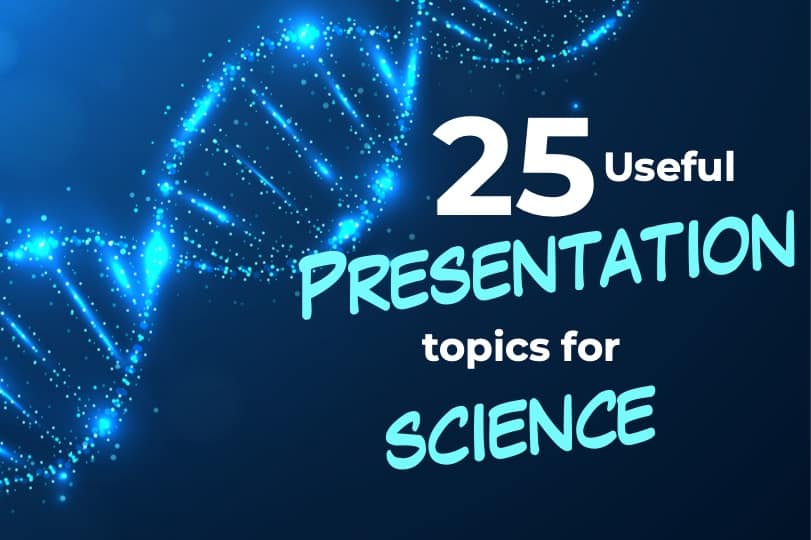
We are mostly asked questions about Presentation Design. But, sometimes, we do have our patrons reaching out to us to seek help with the “content” that needs to be created even before we begin with the design of the presentation.
So, today we are sharing a few really easy-to-cover super useful presentation topics for Science. This is especially helpful for all those teachers and parents who are looking to increase the curiosity of aspiring students and children.
So, let’s dive right into it –
A Quick Note Before We Begin – if you want to make jaw-dropping presentations, I would recommend using one of these Presentation Designs . The best part is – it is only $16.5 a month, but you get to download and use as many presentation designs as you like! I personally use it from time-to-time, and it makes my task of making beautiful presentations really quick and easy!
1. Big Bang Theory – Origin of Our Universe
As a kid, I was always curious about how we came into existence! How the planet Earth was created? How did it all start? This is a great topic to really generate and at times, even quench the curiosity of your students or children. While it is a great topic for presentation in class, it is also an equally good topic for a dinner conversation with your kids.
2. DNA structure
Our DNA is the very core of our life. If the Big Bang Theory is how the universe came into being, DNA is where our personal journey begins. While the structure of DNA is quite fascinating, the impact it has on our lives and how it affects our characteristics is mind-boggling!
It is another great topic for a Science Presentation. Do keep in mind, use of visual aids will most likely improve comprehension and retention among your audience.
3. Gene Editing & Its Uses
In case you choose to go with the previous topic of DNA, Gene Editing serves as a perfect extension of that topic even though it can be a great topic in itself. Sharing insights on Gene Editing and how it works, can showcase the capacity of human endeavors and its resolve to make things better.
4. Important Discoveries of Science
Okay, so this can really be a fun topic. As a kid, it was always fascinating to know about some of the world’s greatest discoveries and inventions.
Be it Penicillium or the first flight by the Wright Brothers, such topics allow you to take your audience on a journey and relive the times in which these discoveries and inventions were made. The thing that I like the most about this topic is that it doesn’t have to be completed in one session.
In fact, this can be turned into a knowledge series of multiple sessions as the list of discoveries is endless.
5. Aerodynamics
Most kids and students are really fascinated with planes. But, only a few really understand the basic principles of how a plane works. Explaining Aerodynamics can be an interesting topic.
It also allows you to introduce props such as a plane and practical exercises such as creating your own plane and analyzing its aerodynamics. The introduction of visuals for such a topic can greatly enhance the learning experience.
So this is a topic that most of the kids and students would have at least heard of, most might know about it a little. But very few would really understand how gravity truly changed our concepts not just on Earth, but also beyond our Planet in our Solar System.
Gravity alone is responsible for the tectonic shift of mindset that the Earth was the center of our Solar System to the fact that the Sun is the center of our Solar System around which the rest of the planets revolve. That and much more!
Explaining the stories of Galileo who first challenged this assumption and how Newton turned everything we knew upside down (almost literally!)
7. Photosynthesis
Another interesting Science topic for a presentation.
How do non-moving organisms produce and consume food? How Photosynthesis is not just limited to trees but virtually drives all lifeforms on Earth through the transfer of energy.
Also, touching upon the fact how Photosynthesis has led to the revolutionary discovery of Solar cells and how it is potentially going to be powering our future.
8. Artificial Intelligence – Boon or Bane
When it comes to Artificial Intelligence, there is a lot that we can do to engage the curiosity of our kids and students. It is an evolving part of Science as we haven’t fully applied and utilized AI.
One of the reasons this can be a great topic is because it engages your students or kids to really think. You may consider forming 2 teams and allowing an open debate on how AI could be a boon or a bane – a great way to promote cross-learning.
9. Ocean – The Unknown World
Our Ocean is what sets our planet Earth apart from the other planets in our solar planet. It is not only one of the main factors contributing to life on earth, the Ocean holds a world of its own with hidden creatures which have only recently been explored.
There is a lot to cover when it comes to the Ocean. Don’t limit your imagination to just lifeforms as you can even talk about treasures troves contained in the ships that sank!
10. Astronomy
So I have a confession to make. Which is this – Astronomy astonished me as a kid, and it amazes me even now! There have been countless nights that I gazed at the stars in the sky in amazement trying to locate a planet, and falling stars and other man-made satellites in the sky.
This is not just an amazing topic for a presentation, but if you could get hold of a telescope for a practical session, it will make a night to remember for the kids and the students!
11. Light and its effects
This is another topic that can turn into a great practical session!
Presentations can be accompanied by a trip to the physics lab or even using equipment like a prism to take the session experience of your audience to a totally different level! Experiencing the various colors that form light is one thing, but understanding how it impacts almost every single thing in our day-to-day activities makes us admire it.
12. Atoms – Building Blocks of Matter
While there is a whole universe outside of our Planet, there is a completely different world that exists when we go granular inside any matter.
There are literally billions and billions of atoms inside just our human body. Each atom has its own world making it as diverse as you can imagine.
How these atoms interact with each other and what makes an atom can be a really engaging topic to bubble the curiosity of the students or your kids!
13. Sound & Waves
Another super interesting presentation topic for Science for kids and students is to understand how Sound works.
There are several things to cover as part of this ranging from simple waves to frequency and resonance experiments. Sound is not just a good topic for a presentation but also for experiments and physical demos.
14. Technology
Technology as a topic has a lot to cover. As we all know that technology touches each of our lives on a daily basis, students can find this topic relatable quite easily. The canvas for exploration and presentation is quite broad giving you a wide range of technology topics to present from.
15. Human Brain
Many believe that we only use 10% of the capacity of our human brain. We have to date only barely managed to understand how our brain works.
Even the parts that we have gathered an understanding about, we don’t quite fully understand. The human brain has remained a topic of astonishment for scientists for a long time. It is only logical to conclude that if presented effectively, this can be a good presentation topic on science.
16. Evolution
When Charles Darwin presented his Theory of Evolution by Natural Selection in his book “The Origin of Species”, it took the world of science by storm.
How the species have evolved over a period of millions of years is quite interesting. There were quite a few interesting learnings that Darwin had and he shared that as a summary. This is something that has been also covered in the TV series Cosmos by Neil Degrasse Tyson.
I highly recommend giving this TV series a watch to get inspiration for some topics for presentation.
17. Magnetism
The majority of the kids have handled and spent hours in awe playing with a magnet. Many try to understand how a magnet really works! But, only a few are able to really understand the science behind it.
Magnetism can be a really fun topic to give a presentation on. Additionally, this topic also allows enough space to display, experiment, and have fun with real magnet and iron filings to showcase the effect of magnetism.
18. Electricity
Electricity is pretty much everywhere.
Today, if there is no electricity, the region is considered underdeveloped or backward. The discovery and the use of electricity is probably one of the greatest inventions of the 20th century.
It has been single-handedly responsible for industrialization, powering growth, and the development of the human race.
19. Steam Engine
Steam Engine was the first step of the human race towards powered locomotives.
From the discovery of the steam engine to how it was responsible for creating a time standard and time zones along with the stories related to it, can all be very fascinating and take you back in time to relive history!
A perfect presentation topic for science students.
20. Science of Medicine
No list of presentation topics for Science would be complete without mentioning medicine and its benefits.
The discovery of medicines and drugs has been responsible for nearly doubling the average human age. The impact is far-reaching with several pros and cons that constitute an interesting topic for presentation.
21. Periodic Table
Students often find this topic very dull. However, if you can help them understand the beauty and significance of this periodic table, it can be an amazing topic.
To really understand how Mendeleev could predict the existence of various elements even before they were discovered, is mind-boggling!
The periodic table is such a perfect table that explains how the elements are arranged in a well-structured manner in nature. This topic can be turned into a very interesting topic but a bit of effort and some out-of-the-box thinking may be required.
22. Buoyancy
Okay, so we all may have heard the story of Archimedes in a bathtub and how he shouted “Eureka” when he managed to solve the problem that was tasked to him. He did this using the Buoyancy principle.
While this story is something we relate to buoyancy the most, there is a lot more than we can truly learn and apply using this principle. This can be a very helpful topic for a presentation as well as a practical science experiment.
23. Health & Nutrition
Health & Nutrition is a very important aspect of our life. Its importance is often not completely understood by kids and students alike. Presenting about Health & Nutrition can go a long way to benefit the students to maintain a very healthy life!
24. Our Solar System
Our Solar System is a topic that is mostly taught since you join the school.
However, while most of us know about our solar system, there are enough mysteries about it to capture and captivate the attention of your audience. Questions like – why is Pluto not a planet anymore?
Or other questions such as – are we alone in this universe or even topics around the Sun as a star or even the asteroid belt between Mars and Jupiter can all lead to great engaging presentations and discussions.
25. Stem Cell
Stem cell research has become cutting-edge medical research. Thus, it is often a hot topic for discussion but is often not completely understood.
This topic will also provide you an opportunity to engage your audience in a debate that could be centered around the ethics of stem cells and their application.
This is a perfect topic as this allows your students or kids to learn and share their opinion with others.
Science is a vast world. Even though there are several other topics that can be covered, we decided to list topics that are relatively common such that it widely applies to a large set of people. If you have shortlisted your presentation topic and are looking for help to create a visually appealing presentation that captures the attention of your audience, be sure to reach out to us!
Our goal on this blog is to create content that helps YOU create fantastic presentations; especially if you have never been a designer. We’ve started our blog with non-designers in mind, and we have got some amazing content on our site to help YOU design better.
If you have any topics in mind that you would want us to write about, be sure to drop us a comment below. In case you need us to work with you and improve the design of your presentation, write to us on [email protected] . Our team will be happy to help you with your requirements.
Lastly, your contribution can make this world a better place for presentations . All you have to do is simply share this blog in your network and help other fellow non-designers with their designs!
- Earth Science
- Physics & Engineering
- Science Kits
- Microscopes
- Science Curriculum and Kits
- About Home Science Tools
Science Projects > Science Fair Projects > Science Fair Tips
Science Fair Tips
So, you’re entering a science fair. Now what? These six simple science fair tips will take you from picking your project to nailing your presentation. And who knows — you may even have some fun along the way!
Science Fair Tip #1

Science Fair Tip #2
Don’t reinvent the wheel with your science fair topic . A good topic can have revolutionary ideas, but more importantly, judges will want to know what you learned (and if you used the scientific method ) . Hint: It’s OK to take an existing science project and use it as your own! Just modify the variables you test to make your project unique.
Topics that relate to current issues and concerns in society tend to score high points in science fairs. However, you still need to thoroughly think it through and research well to score high. Such topics usually relate to how we can improve or maintain our health, welfare, and/or way of life. We suggest avoiding politically charged topics, if necessary. It is hard to stay neutral, and it is usually hard, if not impossible, to scientifically test your theory.
Science Fair Tip #3
Do your own work . Judges will evaluate what you know about your project and what you learned during the process of your project — from start to finish. If your parent, brother or sister, friend, or classmate does all your work, you won’t learn anything. Where’s the fun in that?
Science Fair Tip #4
Make sure your project is a science project . To be considered a science fair project , your project must use the scientific method and answer a question . So, you must collect and analyze data in order to conclude whether or not your hypothesis was correct. Demonstrating how something works is not a science project. For example, demonstrating a collection of magic eye tricks does not constitute a science project because no data was collected.
However, if you compare how long it takes specific groups of people (such as children and adults, boys and girls) to see the magic eye tricks, then you have a science project. Why? Because you are collecting data and you can use that data to draw conclusions. (Although elementary science fairs have permitted observation/demonstration projects in the past, more and more science fairs also want elementary students to use the scientific method and collect data. Therefore, it’s best to cover your bases and avoid doing a simple observation/demonstration project.)
Science Fair Tip #5
Keep your project simple . Try to test only one variable or one hypothesis in your project. The more experiments in the project, the harder it is to keep track of all the factors that influence your science project. After all, there is always next year to expand on this year’s project. Consult our Science Fair Guide for more information on c om pleting a science fair project.

Science Fair Tip #6
Relax during the interview when presenting your project . The judges aren’t there to torment you or pick apart your project. Instead, they want to see that you did your own work (based on how well you understand your project), that your project addresses all parts of the scientific method, that you did the steps correctly, and that you identified any factors that may have caused inaccurate results. Many judges want to know how you can improve your science project, or what you would change to correct inaccuracies. The best advice we can offer you for the interview is this: know your project inside and out.
Armed with these science fair tips, the scientific method, and our science fair guide , you might be bummed that science fair only comes once a year!
Teaching Homeschool
Welcome! After you finish this article, we invite you to read other articles to assist you in teaching science at home on the Resource Center, which consists of hundreds of free science articles!
Shop for Science Supplies!
Home Science Tools offers a wide variety of science products and kits. Find affordable beakers, dissection supplies, chemicals, microscopes, and everything else you need to teach science for all ages!
Related Articles

Next Generation Science Standards (NGSS)
What are the Next Generation Science Standards (NGSS)? These guidelines summarize what students “should” know and be able to do in different learning levels of science. The NGSS is based on research showing that students who are well-prepared for the future need...

The Beginners Guide to Choosing a Homeschool Science Curriculum
Homeschool science offers families incredible flexibility and personalization for their students’ education. There are many wonderful science curriculums available, and while plenty of options offer flexibility, figuring out which option is right for you can be a...

Valentine’s Day Science Projects
Valentine’s Day is a great opportunity to inspire your student’s LOVE for science! Engage your kids with science concepts such as diffusion, density, and surfactants. These three, hands-on science projects include the Dancing Conversational Hearts, Rainbow Heart, and...

Synthetic Frog Dissection Guide Project
Frog dissections are a great way to learn about the human body, as frogs have many organs and tissues similar to those of humans. It is important to determine which type of dissection is best for your student or child. Some individuals do not enjoy performing...

Your Complete Field Guide to Dissection
If you’re looking for a way to make biology fun and memorable for your student, look no further than dissection! This complete field guide to dissection will explain everything needed to make dissection labs an enjoyable learning experience for your kids.
JOIN OUR COMMUNITY
Get project ideas and special offers delivered to your inbox.
25+ Best Science PowerPoint Templates for Scientific Presentations
Discover the world of science through the lens of compelling visuals with our curated collection of the 25+ best science PowerPoint templates. Perfect for anyone seeking to catch the attention of a scientific audience, these designs exude sophistication while maintaining a touch of simplicity. The templates range from paid to free, ensuring there’s something for everyone, regardless of budget.
Creating a captivating presentation requires not only compelling content but also aesthetically pleasing design. Understanding this, we’ve handpicked a variety of slide designs that feature scientific graphics. These designs are ideal for researchers, students, educators or anyone presenting scientific findings or concepts.
Embrace the blend of knowledge and artistry that these PowerPoint templates offer. They are not mere tools for disseminating information, but also a canvas to creatively highlight your ideas and findings. Dive in, and discover how these science-themed templates can enhance your presentations.
One Subscription: Everything You Need for Your PowerPoint Presentation
Get everything you need to give the perfect presentation. From just $16, get unlimited access to thousands of PowerPoint presentation templates, graphics, fonts, and photos.
Build Your PowerPoint Presentation
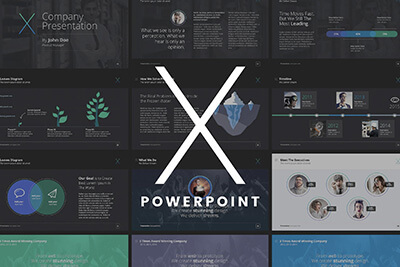
The X Note Template
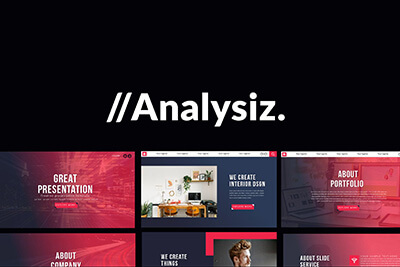
Analysiz Powerpoint
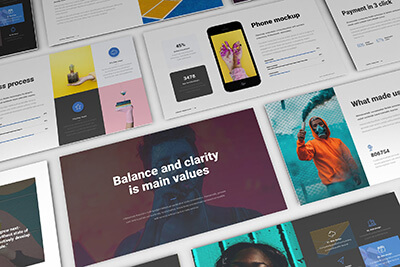
Clean Business PPT
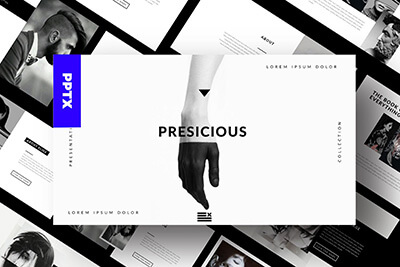
Agency Portfolio PPT
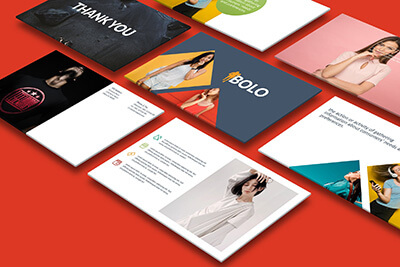
Bolo PPT Template
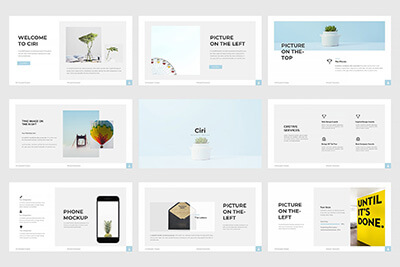
Ciri PPT Template
Science education powerpoint.
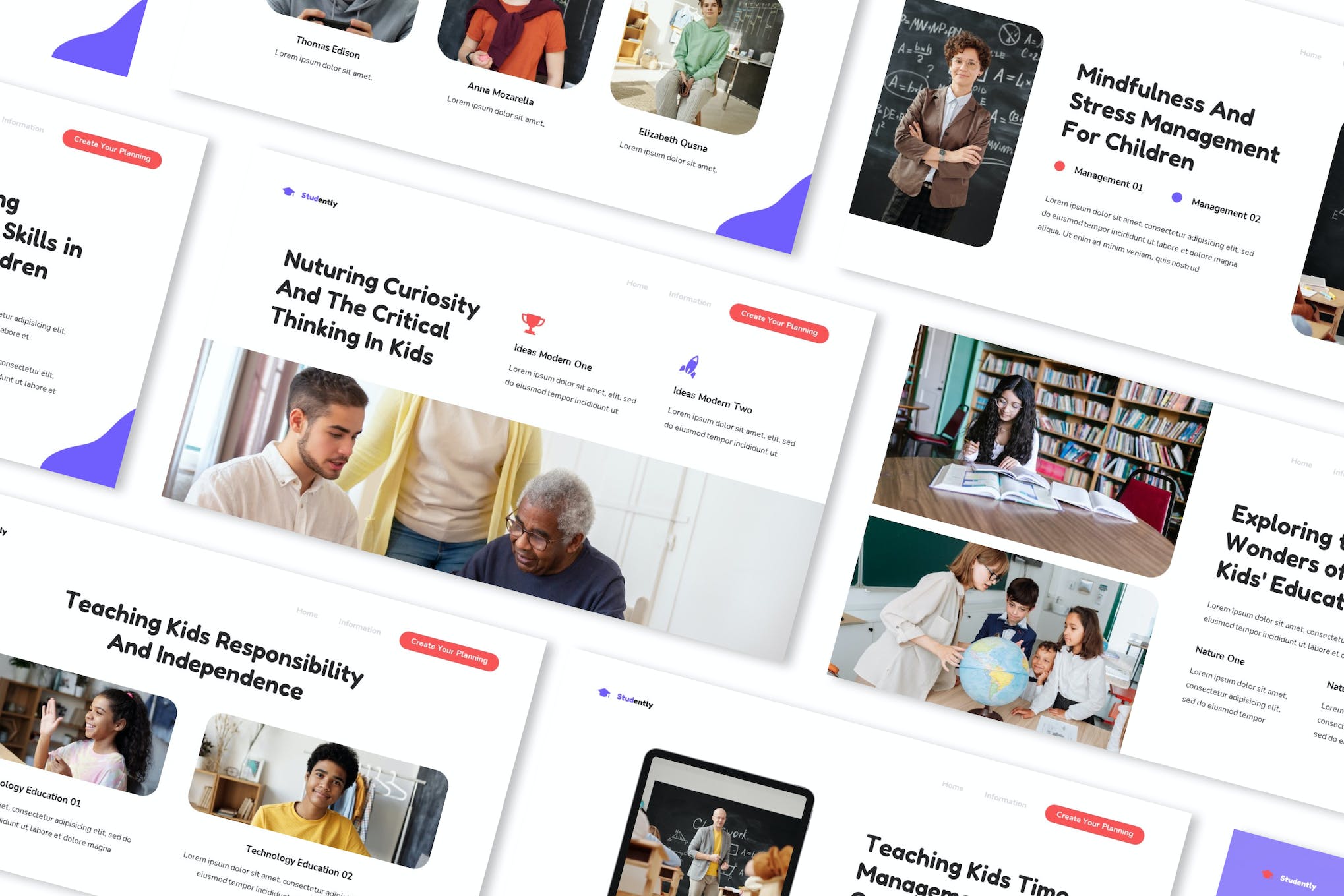
The Science Education PowerPoint template is a versatile asset for a variety of business needs, from company profiles to marketing endeavors. This template includes 30 editable slides in a high-definition widescreen format, giving you the ability to customize elements, colors, shapes, and charts to your liking. Simply note, images shown in the template previews are not included.
Science Kids PowerPoint Template
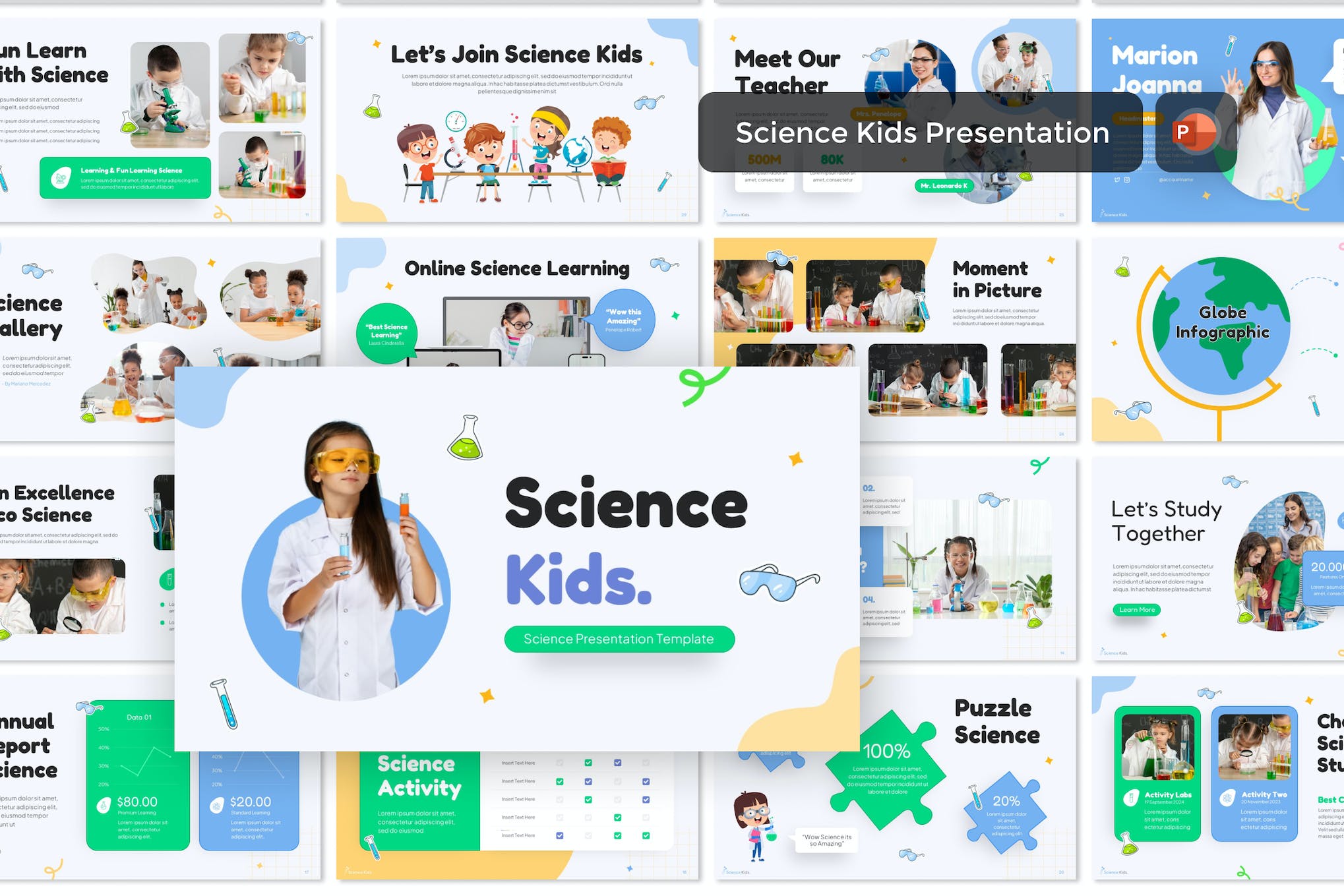
The Science Kids PowerPoint Template is a fun and engaging presentation tool that enhances your audience’s viewing experience. Comprising over 30 unique slides in widescreen (16:9) format, this easy-to-use template features editable charts and elements, a preset color scheme, and distinct font theme. Ideal for various stages of business development, it requires user’s own image stock. Your satisfaction is guaranteed with this exciting template.
Data Science PowerPoint Template
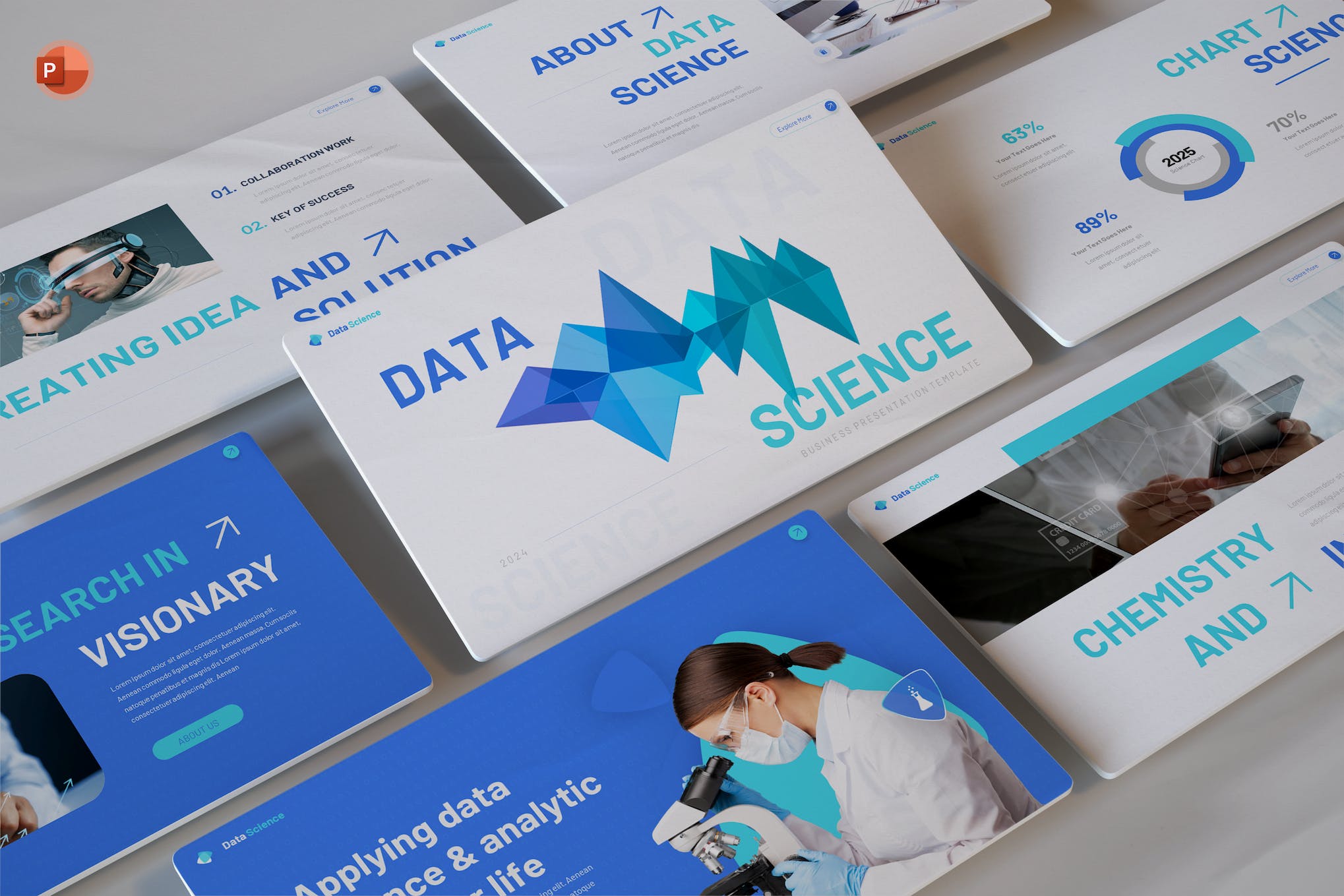
The Data Science PowerPoint Template is a unique, modern, and versatile tool that’s perfect for creating engaging pitch decks or marketing kits. This template packs 37 professionally-designed slides, each different in layout to maintain viewer interest. User-friendly features include easy-to-use image placeholders, editable charts, unique mock-up devices, and vector-based icons. Modify it to cater to any presentation need, utilizing its strong focus on typography and usability. Note, preview images aren’t included. This is a third-party creative asset definitely worth exploring.
Science Research PowerPoint Template
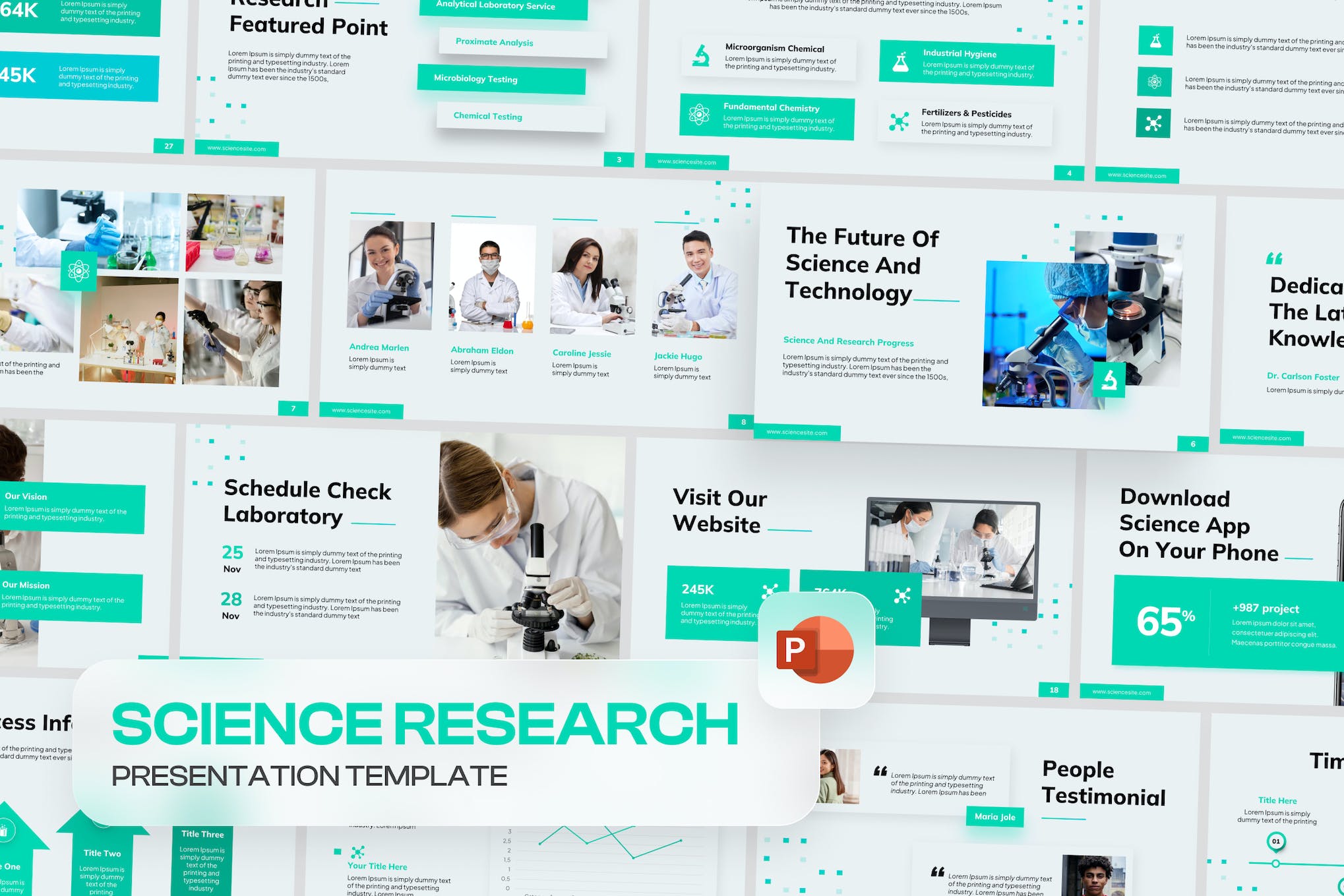
The Science Research PowerPoint Template is a versatile and modern presentation tool, perfect for research, lab reports, business pitches, and more. With 30 unique, editable slides and a sleek light background, it’s a refreshing, easy-to-use asset for all your presentation needs. The package includes PowerPoint files, XML Files for color schemes, an icon pack, and a help file. Please note, images are not included.
Science Education Presentation Template
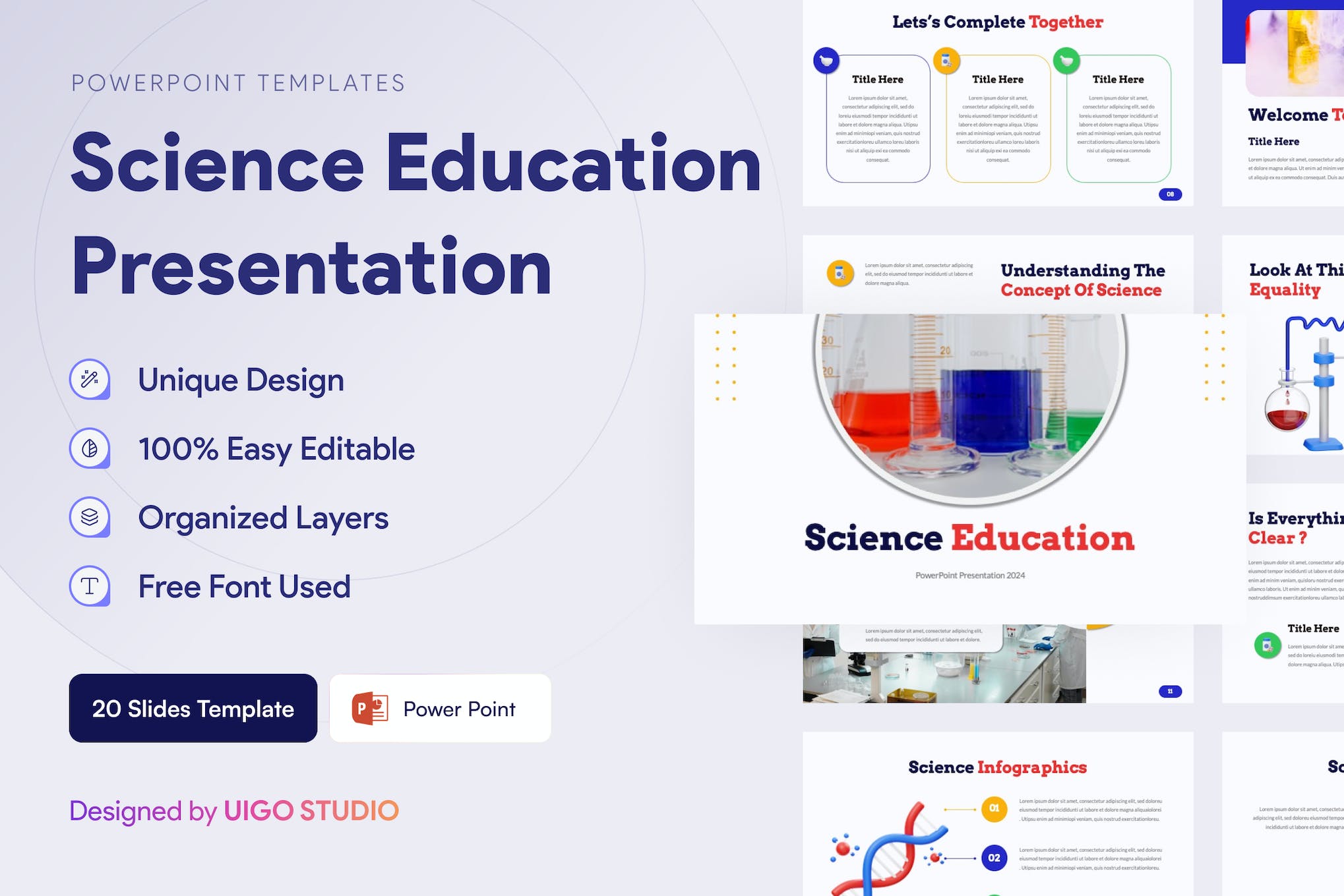
The Science Education Presentation Template is a modern, professional PowerPoint tool perfect for enhancing your next presentation. With a total of 20+ slides including handcrafted infographics and galleries, this easy-to-use template offers editable graphics and a drag & drop picture placeholder. It’s created by UIGO Design, ensuring pixel-perfect quality. Please note, preview images are not included.
Science Grow PowerPoint Template
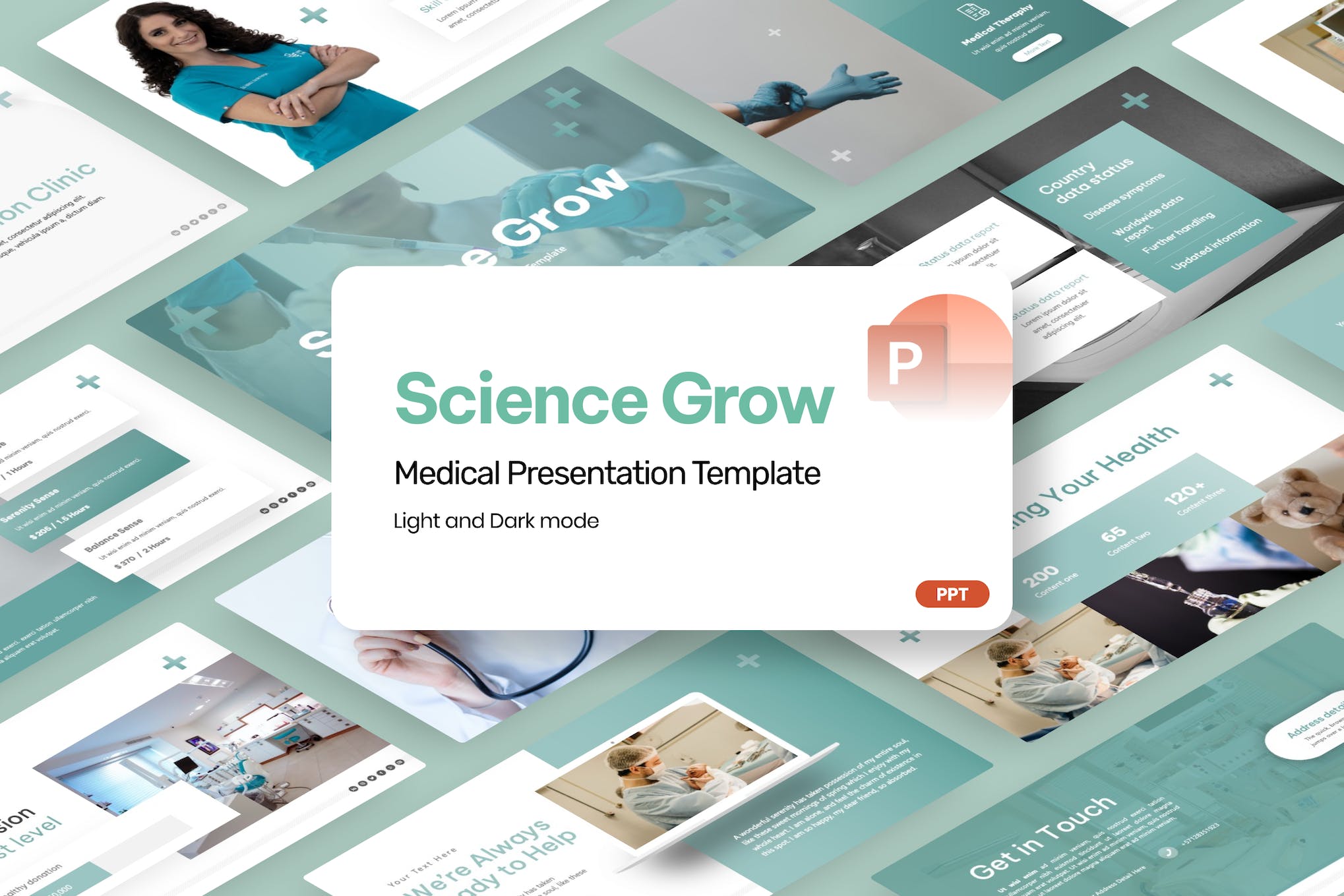
The Science Grow PowerPoint Template is a remarkable presentation toolkit marked with 30 unique slides, customizable light and dark backgrounds, and handmade infographics. Developed by RRGraph Design, known for their commitment to client satisfaction, the package provides a comprehensive suite for conveying business development stages. With this resource, you’re ready to build an engaging, enhanced business narrative that stands out among competitors. Note that images are not included.
Science Education PowerPoint Template
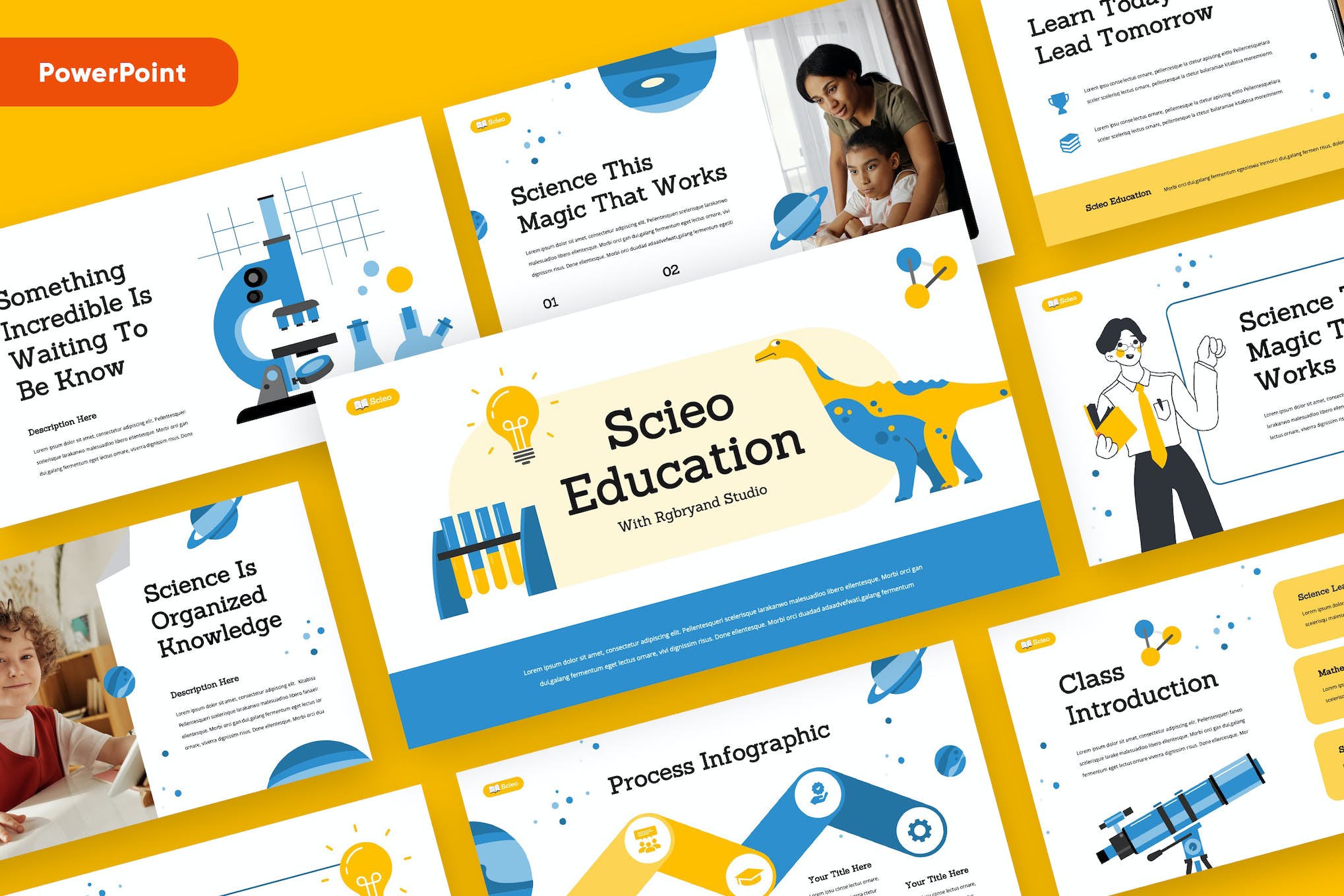
The Science Education PowerPoint Template is a versatile and easily editable asset—ideal for business, school or educational usage. With over 30 clean, modern slides in a high-res 1920×1080 pixel format, this template helps to make presentations more visually engaging. Furthermore, customization is made simple thanks to the Slidemaster feature and it includes a free font and device mockup.
Education Science PowerPoint Infographics
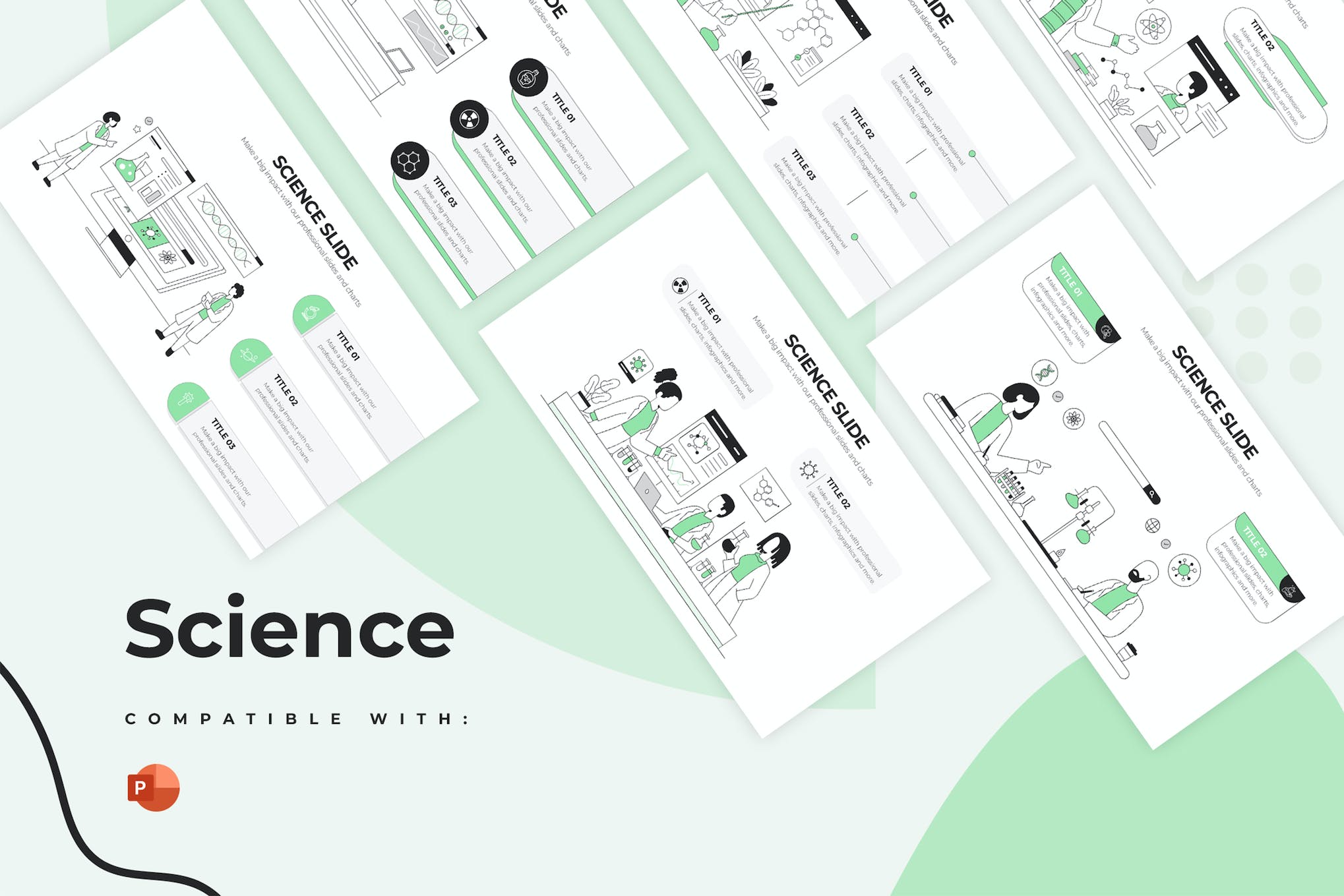
The Education Science PowerPoint Infographics is a versatile and modern template collection, perfect for presenting science-related topics in a professional setting. It includes 20+ unique slides that are easy to edit and fully customizable. Compatible with all versions of PowerPoint, these cleverly designed infographics can support any presentation, making complex scientific concepts more understandable and engaging.
Schoology Science Education PowerPoint
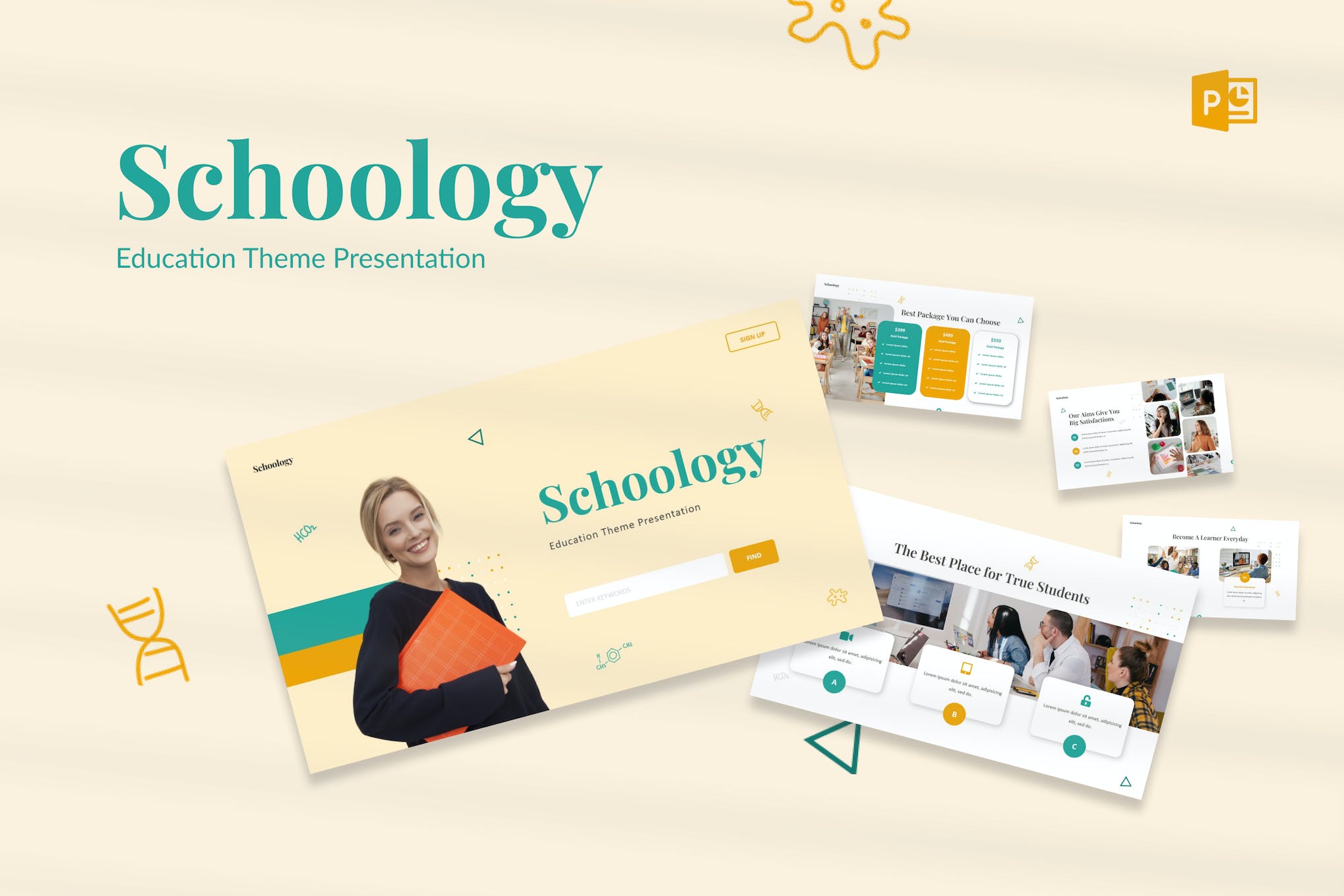
Explore the wonders of science education with Schoology’s professionally designed PowerPoint. With 30 bespoke slides providing clean, modern visuals, it’s both versatile and perfectly suited for educational needs. Cafefully designed for wide acceptability and full editability, this tool offers a fresh way to impress audiences and convey information. Note: Pictures are not included, enhancing space for personalization.
Laboratory Science Research PowerPoint
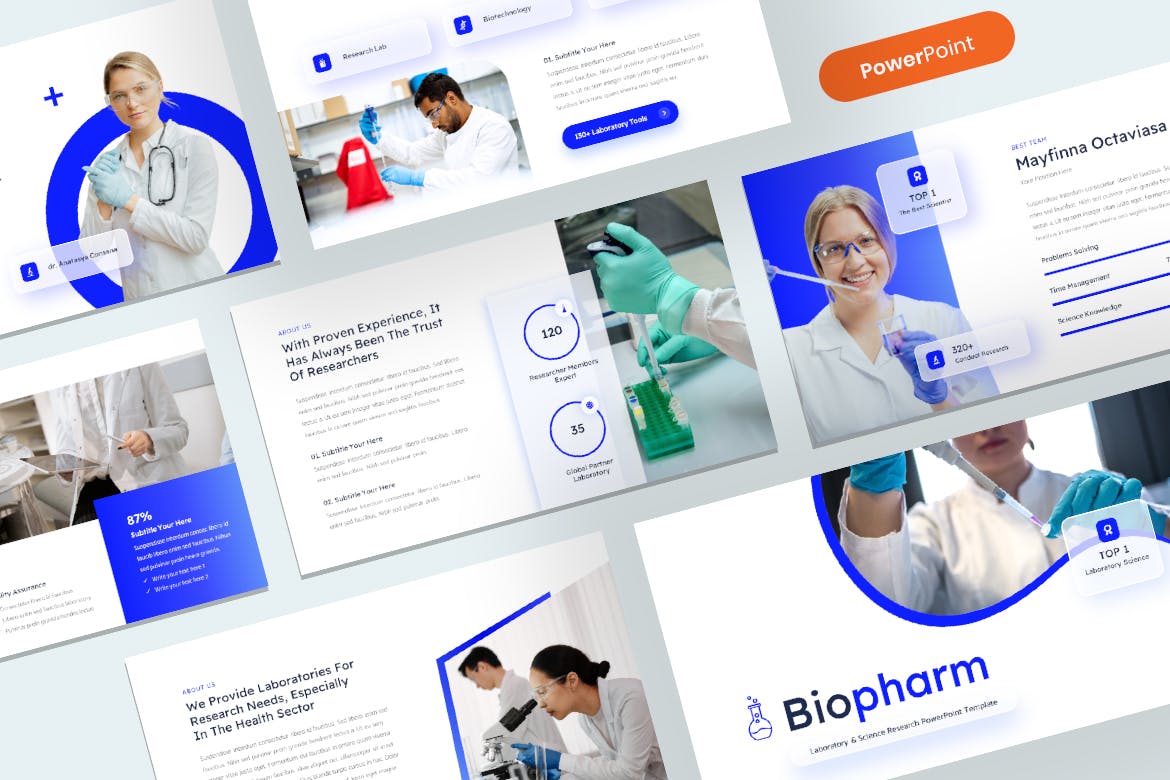
The Laboratory & Science Research PowerPoint Template, Biopharm, offers a professional and creative blend of unique layouts. Perfect for presenting various fields such as biology, chemistry, healthcare, and more, this template is loaded with 30 unique slides. Designed with a strong focus on usability and interesting typography, Biopharm makes editing a breeze with features like resizable graphics and a drag-and-drop interface.
Political Science PowerPoint v591
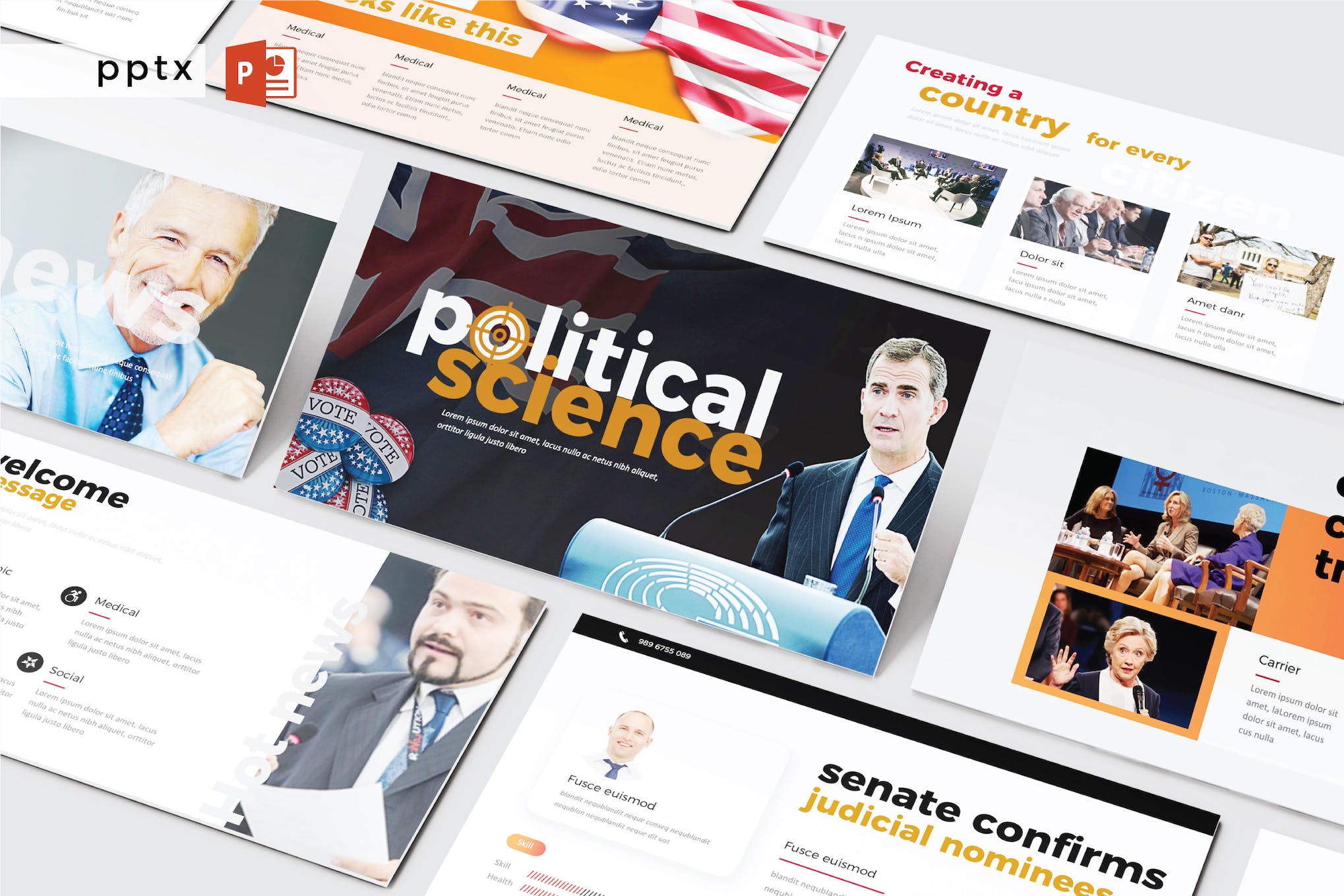
Political Science PowerPoint v591 is a professionally-crafted, contemporary template ideal for agencies or businesses. This fully customizable template allows you to easily modify colors, text, and photos. It boasts a sleek minimalistic design featuring 30 unique slides among a total of 150 slides in a widescreen layout. Also included are five distinctive color schemes and resizable vector icons, all based on a master slide.
Science and Research Presentation Template
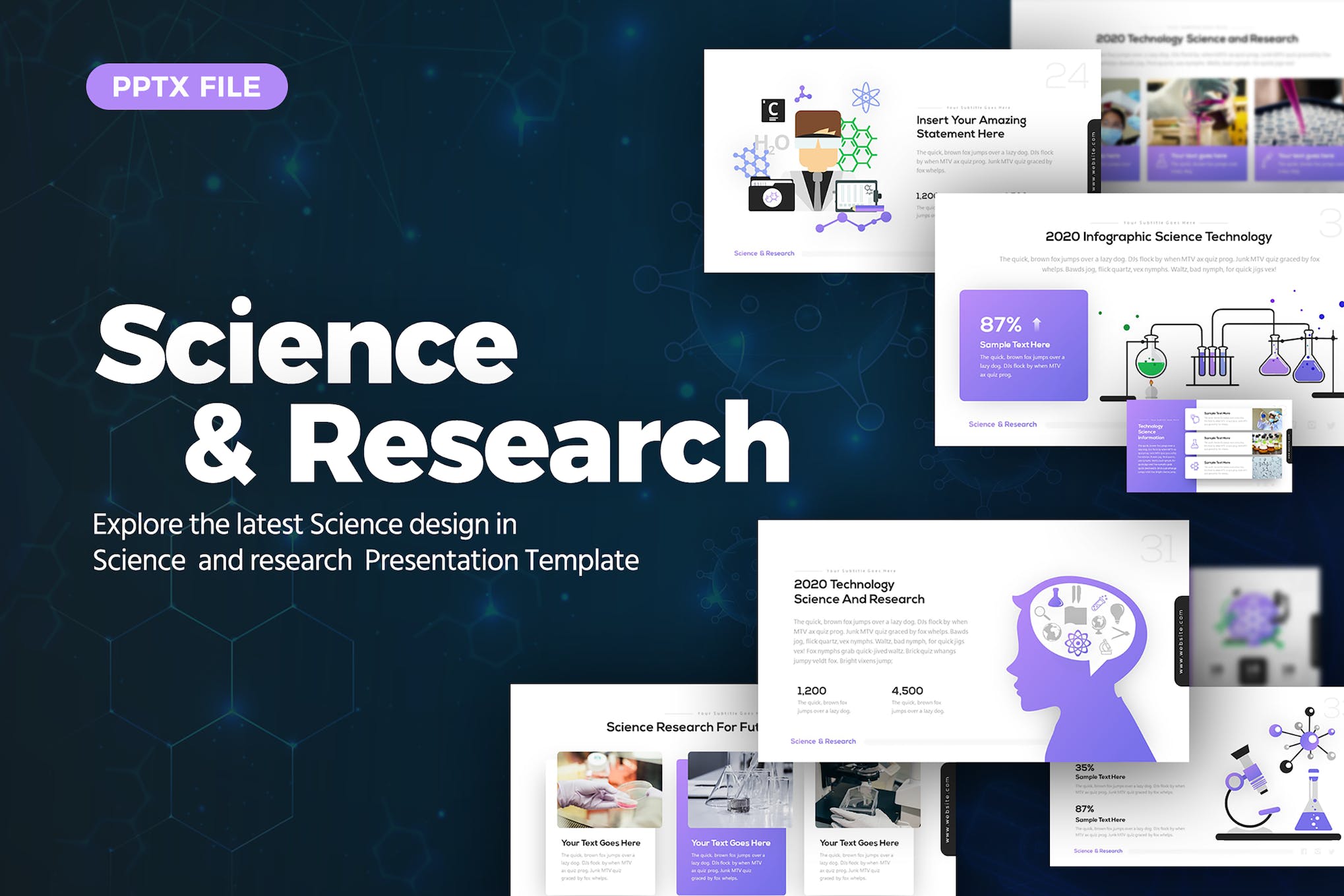
The Science and Research Presentation Template is a thoughtfully designed asset combining aesthetics and functionality in every slide. It includes over 30 unique slides, with diverse layout styles, hundreds of useful infographics, vectors, and charts, all customizable to your needs. This asset is ideal for creating impactful business or research presentations, offering over 90 color themes, and light or dark background options. Provided by RRGraph Design, a team committed to client satisfaction, this asset is an effective tool to meet your presentation needs.
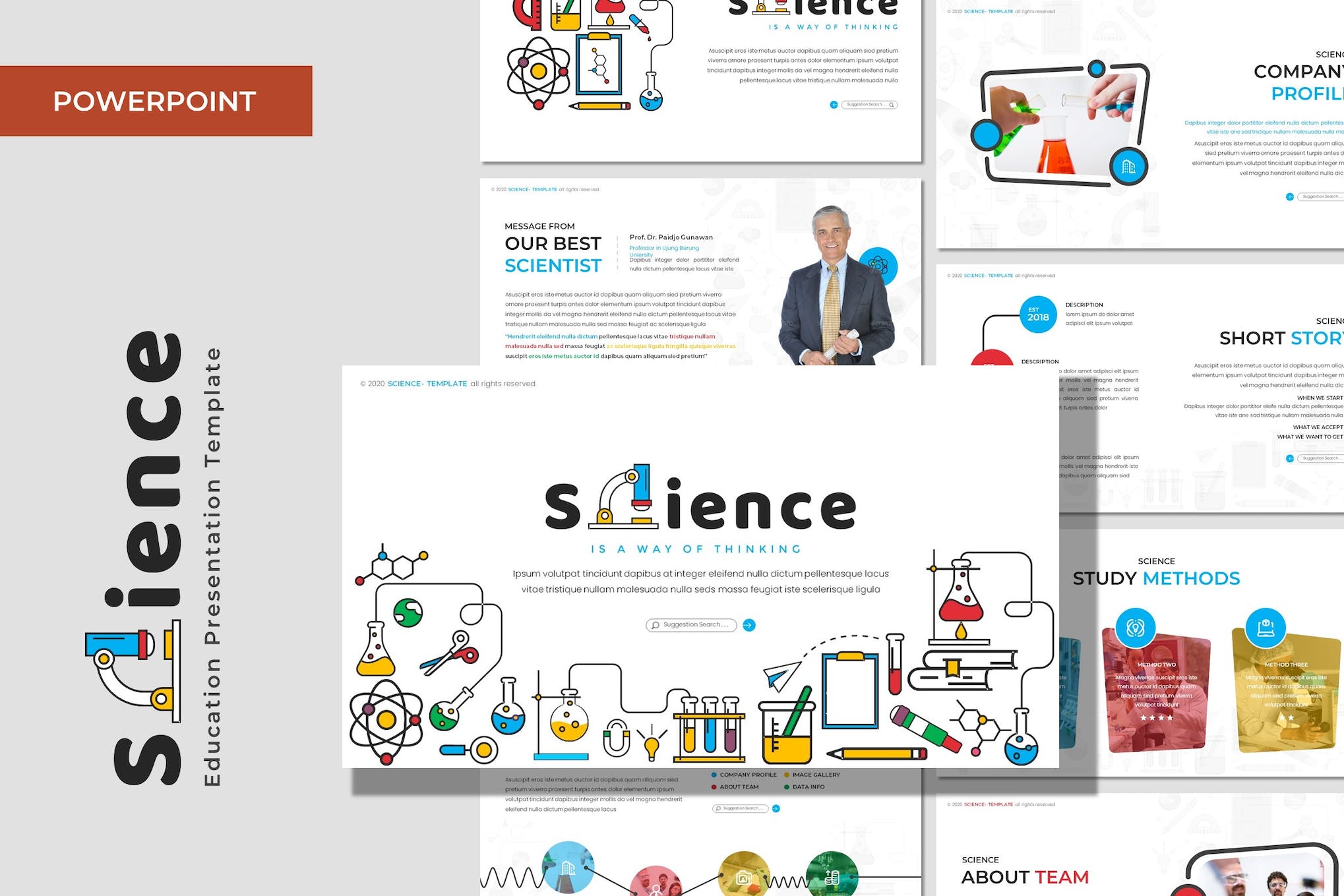
The Science Education PowerPoint Template is a modern and creative asset ideal for both personal and commercial use. This unique, professionally-designed template is versatile, fitting the needs of the creative industry, businesses, and agencies. It boasts 150 total slides, 30 slides per template, 5 color variations, device mockups, and pixel-perfect illustrations. The template also allows all graphics to be resized and edited, customizable to your needs.
Sinara Science PowerPoint Template
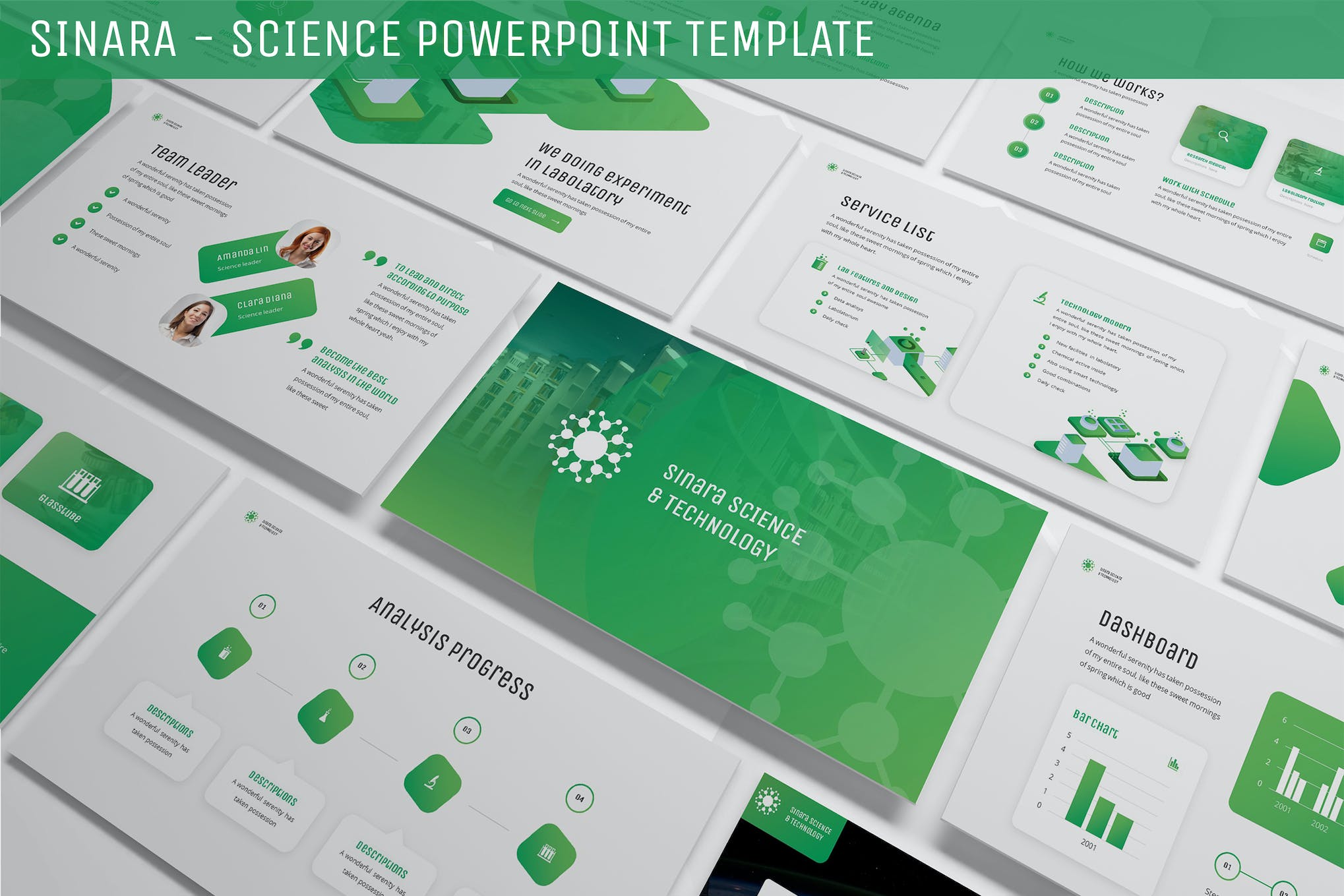
The Sinara Science PowerPoint Template is a versatile, modern design with a gradient theme, ideally suited for fields like technology, medical, or chemistry. It offers over 700 total slides, 30 unique slide templates, and three color themes. With features including picture placeholders and both light and dark backgrounds, the template is easy to edit directly in PowerPoint.
Garnie Science PowerPoint Template
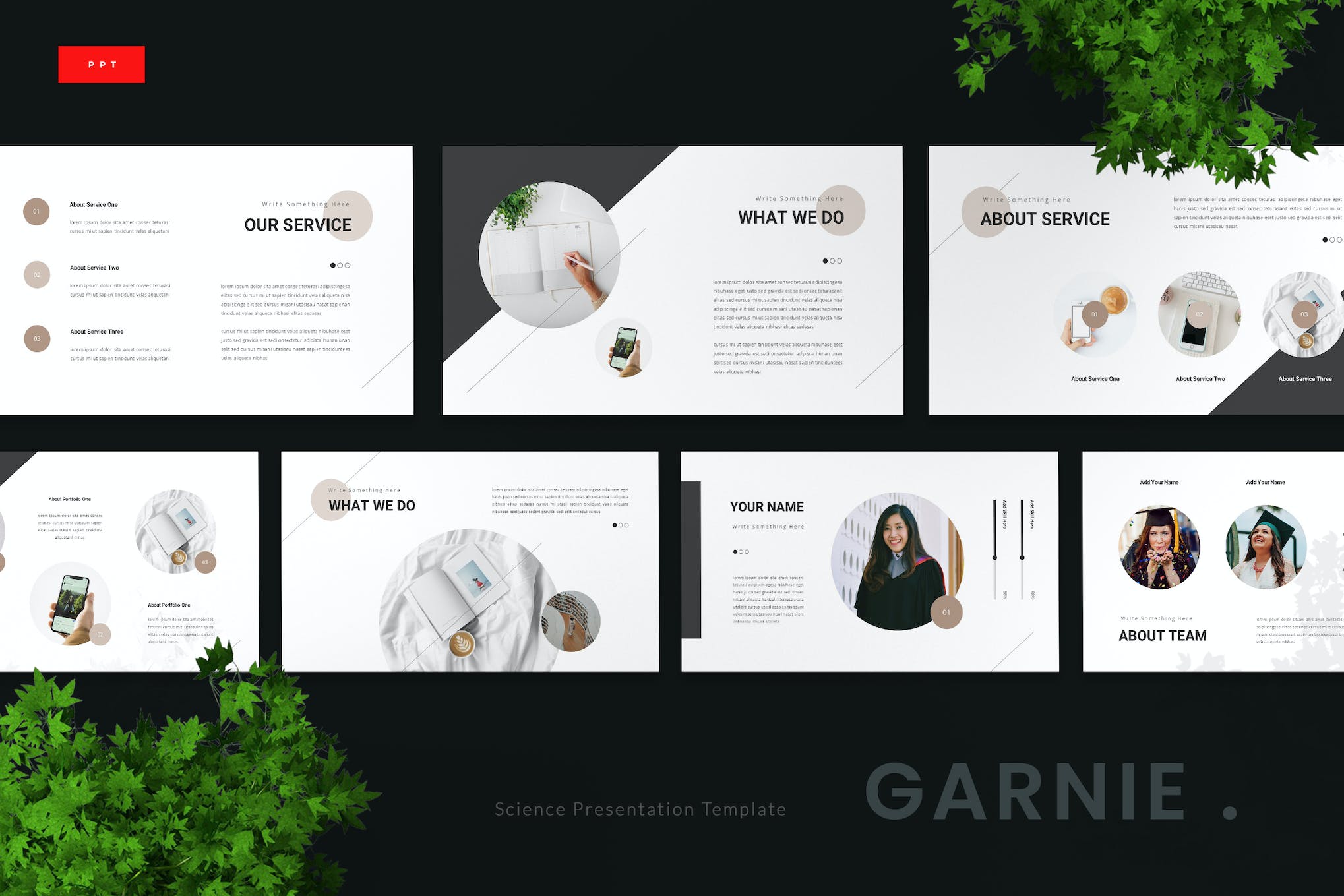
Garnie Science PowerPoint template improves how you present your business proposition. It’s got a clean layout that structures your content, helping your audience quickly grasp your message. Plus, it’s easy to edit! With over 30 creative and innovative slides, comprehensive help files, and fully editable shapes, it’s the resource you need for engaging presentations. However, note that images and cover mockups in previews are not included in the download.
Science Laboratory PowerPoint Template
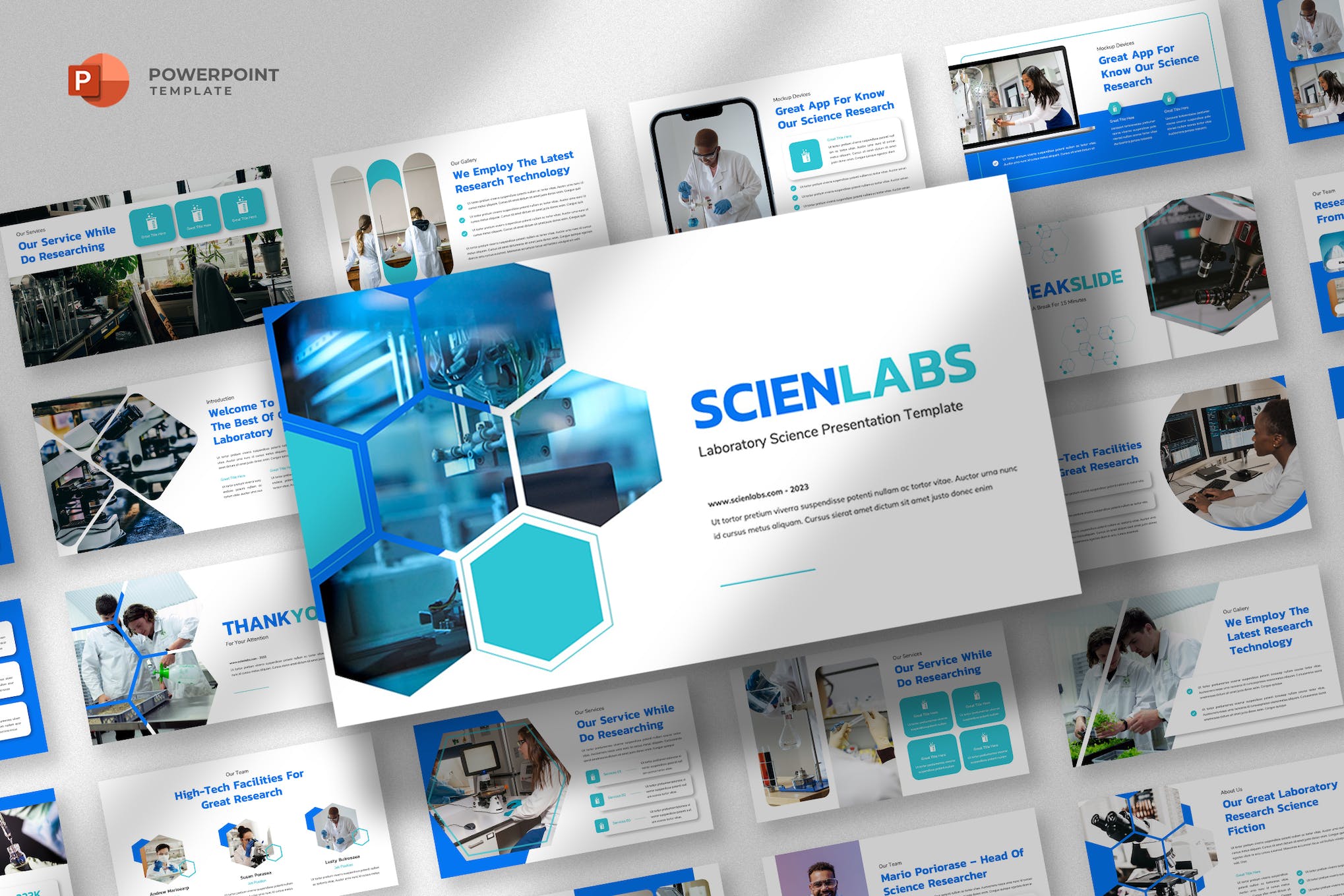
The Science Laboratory PowerPoint Template, branded as “ScienLabs,” offers a simple, clean, and modern design perfect for any scientific presentation needs. It includes 25 slides with resizable and editable graphics, a 16:9 wide screen layout, and a drag-and-drop image placeholder. Though images shown are for preview only, the template also provides free fonts and a help file for maximum usability. Ideal for the healthcare, pharmaceutical, or biotechnology industry.
Data Science Presentation Template PowerPoint
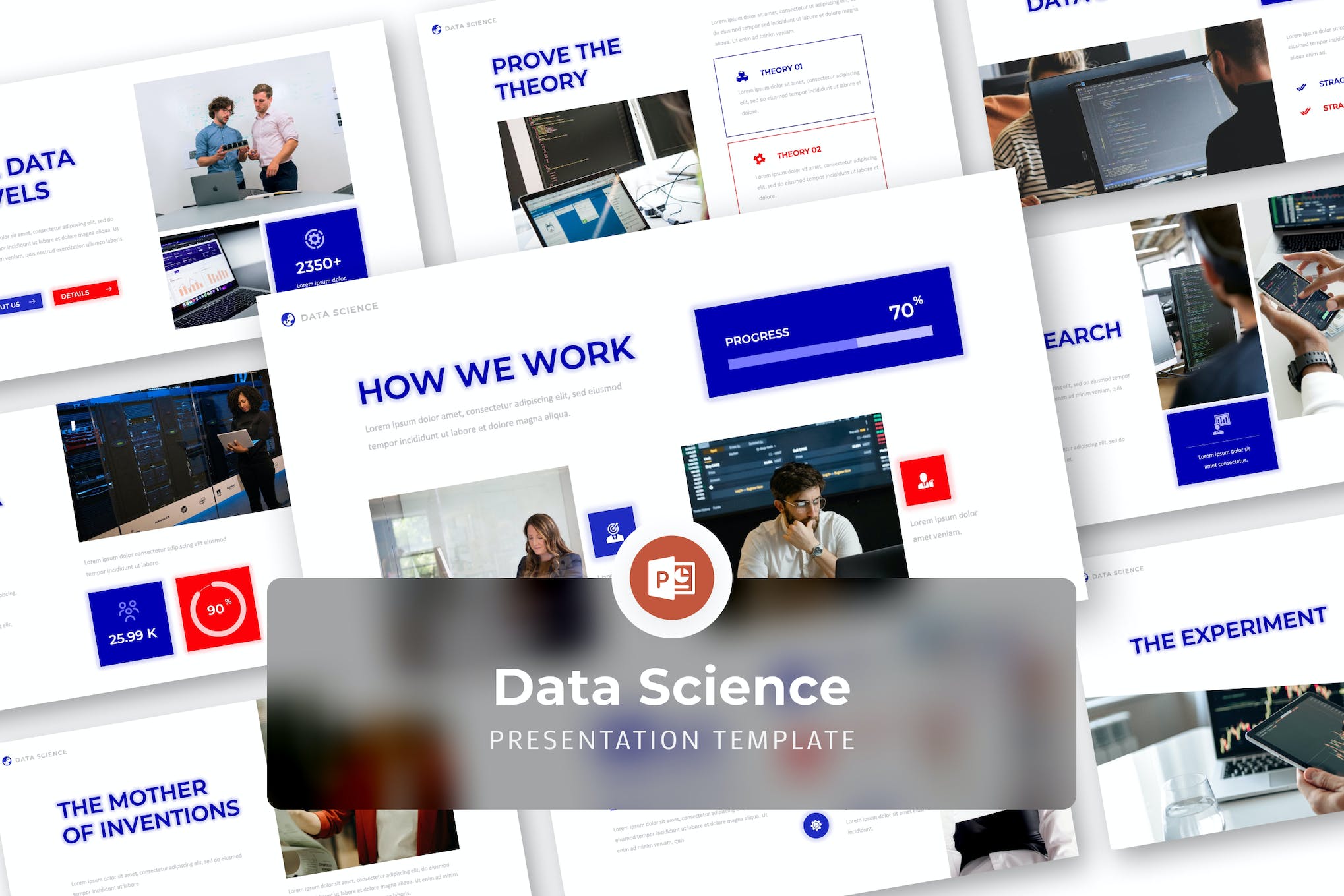
Opt for the Data Science Presentation Template PowerPoint to make your presentations memorable and impactful. This versatile template features 10 editable slides, customizable graphics, and uses recommended free web fonts. It operates on a 16:9 wide screen ratio for an immersive visual experience, ensuring clarity in your message and leaving a powerful impression on your audience. Note, images are used for preview only.
Localab Science Research PowerPoint Presentation
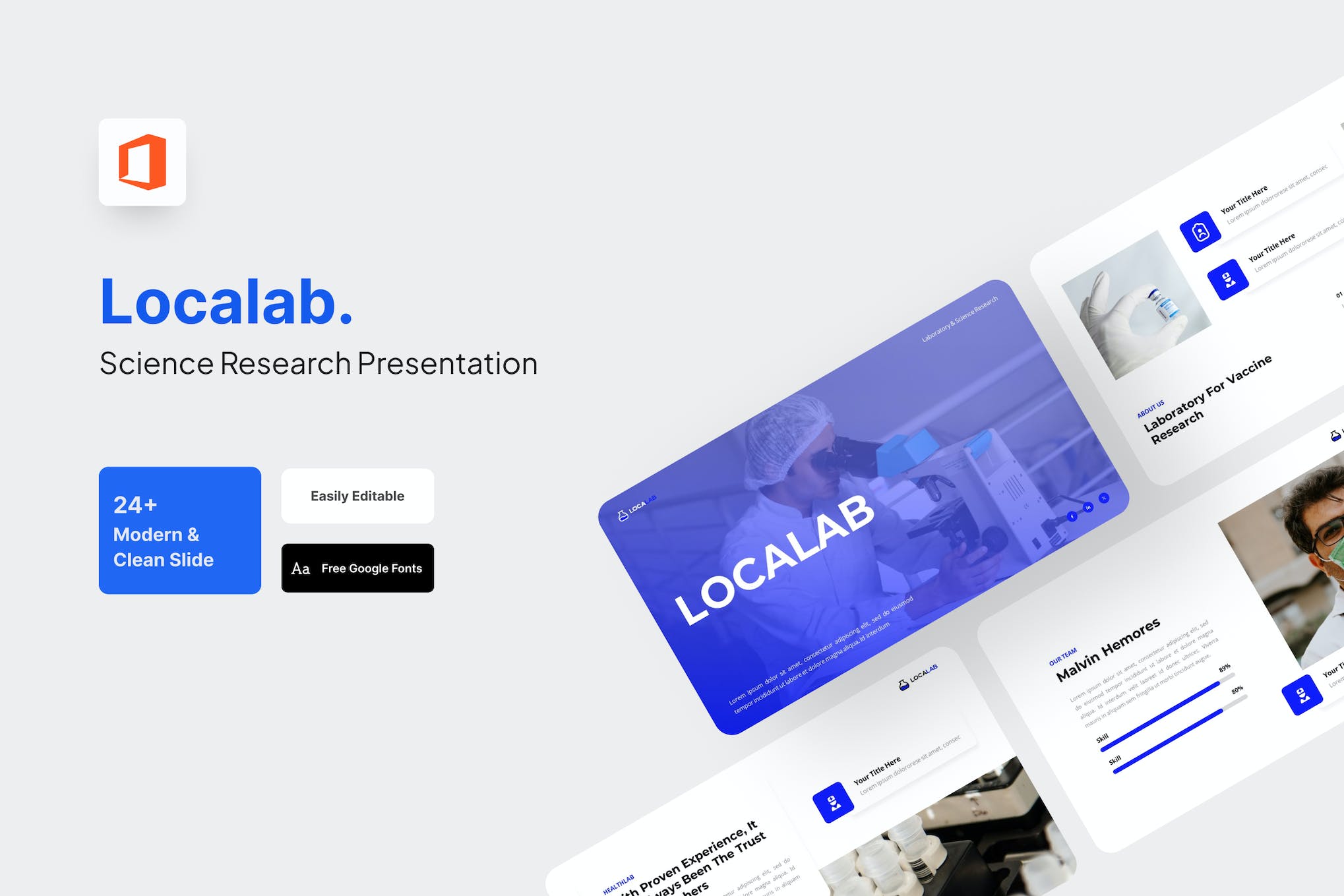
Localab’s Science Research PowerPoint Presentation is a versatile and impressive template providing ultra-modern designs. It’s perfect for a wide range of topics, including but not limited to research, science, health, and technology. With resizable and editable graphics based on Master Slides, it’s easy to customize to fit your presentation needs. Notably, it’s particularly fitting for presentations related to pharmaceuticals, biotechnology, or innovation.
Neolabs Laboratory Science Research PowerPoint
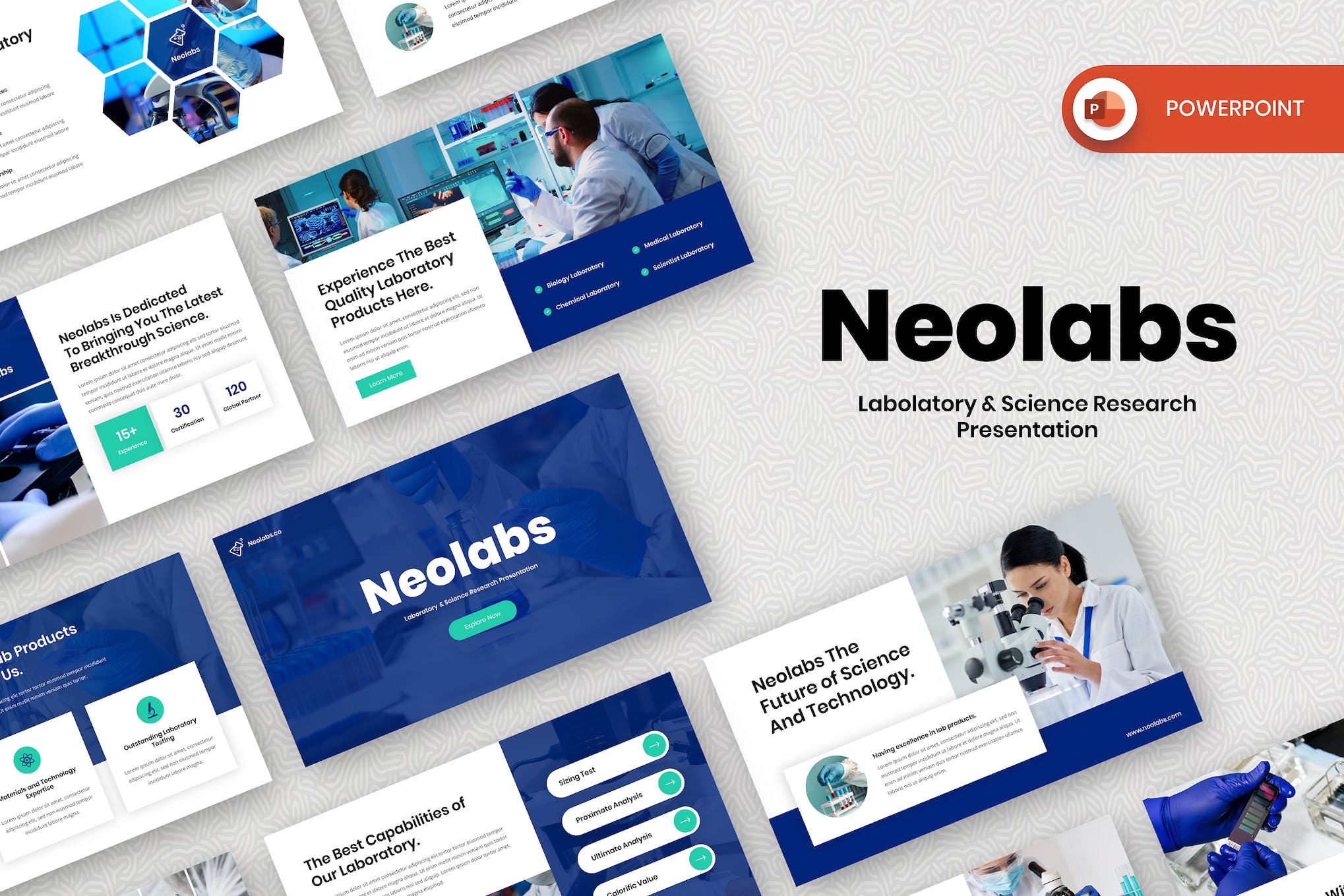
The Neolabs Laboratory & Science Research PowerPoint is a dynamic, visually engaging platform tailored to present your scientific research and findings. It’s versatile, catering to various scientific fields, and laid out for clear communication to both academic and non-technical viewers. Highlights include resizable graphics, free web fonts, wide screen ratio, and an easy drag-and-drop, editable format. Ideal for professional presentations in corporate, creative, and academic contexts.
Genetics Laboratory Science Research PowerPoint
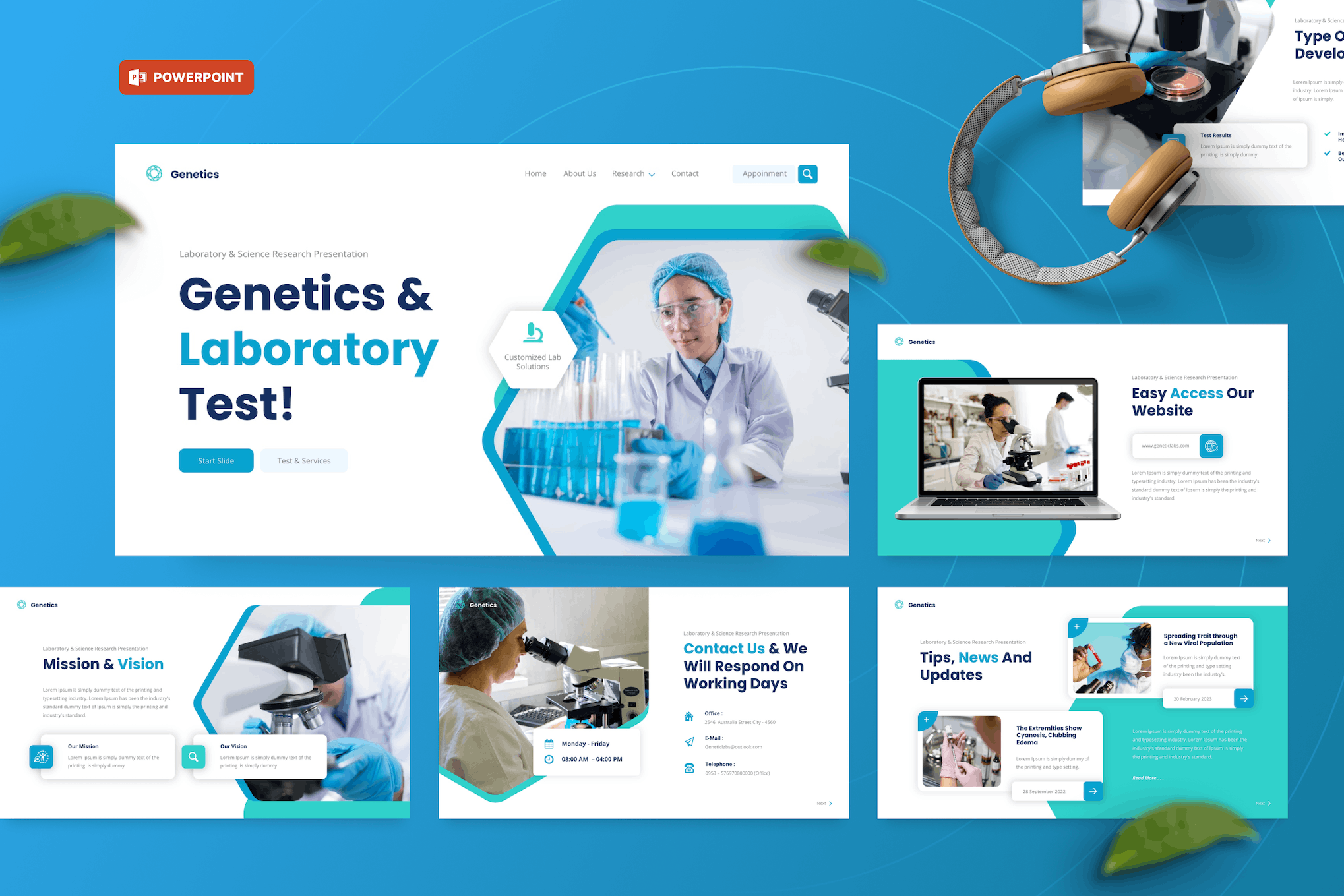
The Genetics Laboratory Science Research PowerPoint Template is a versatile, professionally designed presentation aid that’s easy to edit and customize. Employing a modern, clean aesthetic, it’s perfect for businesses, creative agencies, and designers needing to communicate complex topics effectively. The template, provided by Annora Studio, features a range of unique layouts, and uses free web fonts and resizable graphics to enhance your presentation’s appeal. Note: demo images aren’t included in the download.
Enzilabs Laboratory Science Research Template
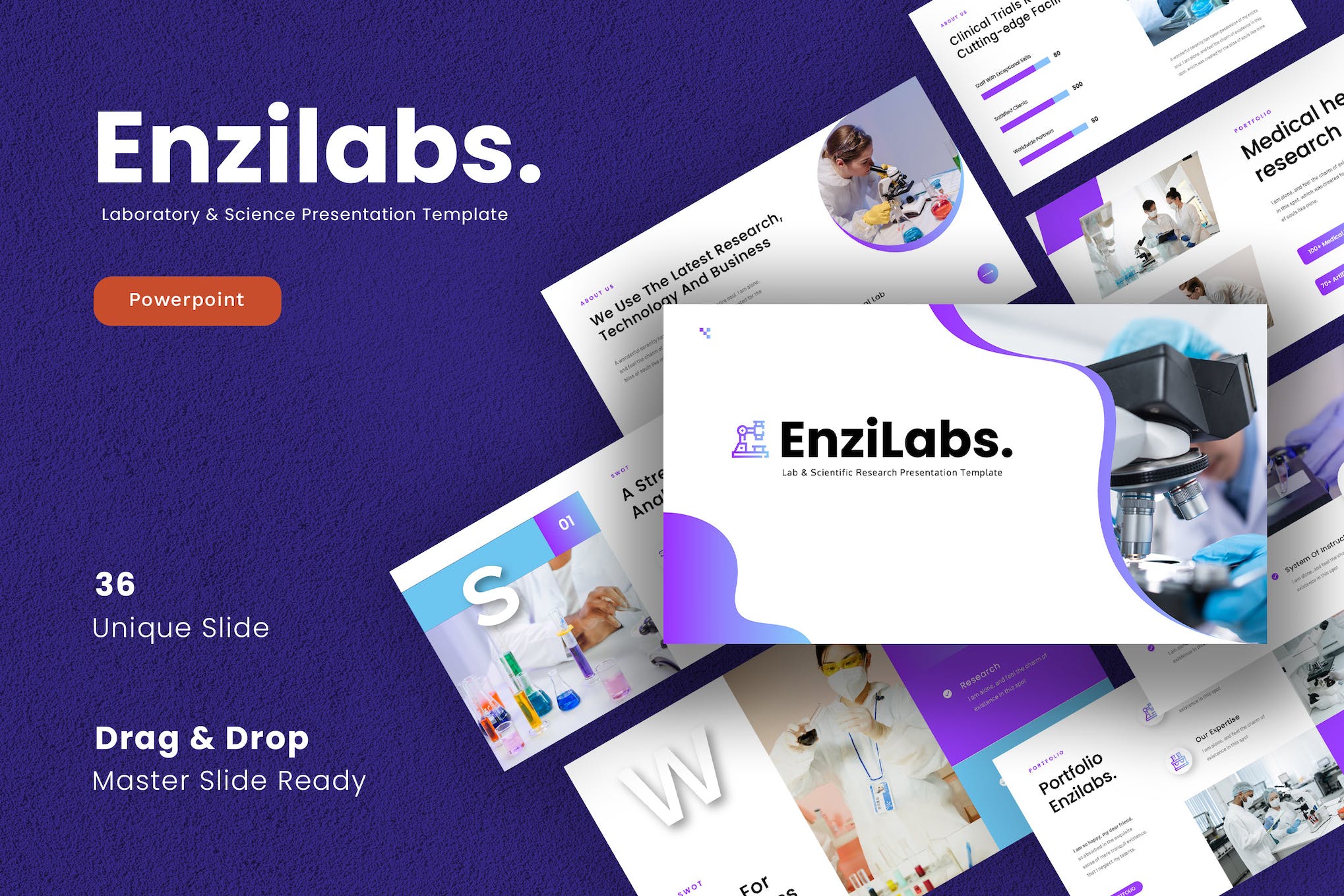
The Enzilabs Laboratory Science Research Template is a polished, modern PowerPoint tool perfect for any professional or business-related presentation. With 36 fully customizable slides featuring editable graphics and free web fonts, it’s especially useful for those involved in scientific research or lab work. It also offers drag-and-drop convenience, master slide-based design, and a wide 16:9 screen ratio. However, demo images are not included.
Life Science PowerPoint Presentation Template
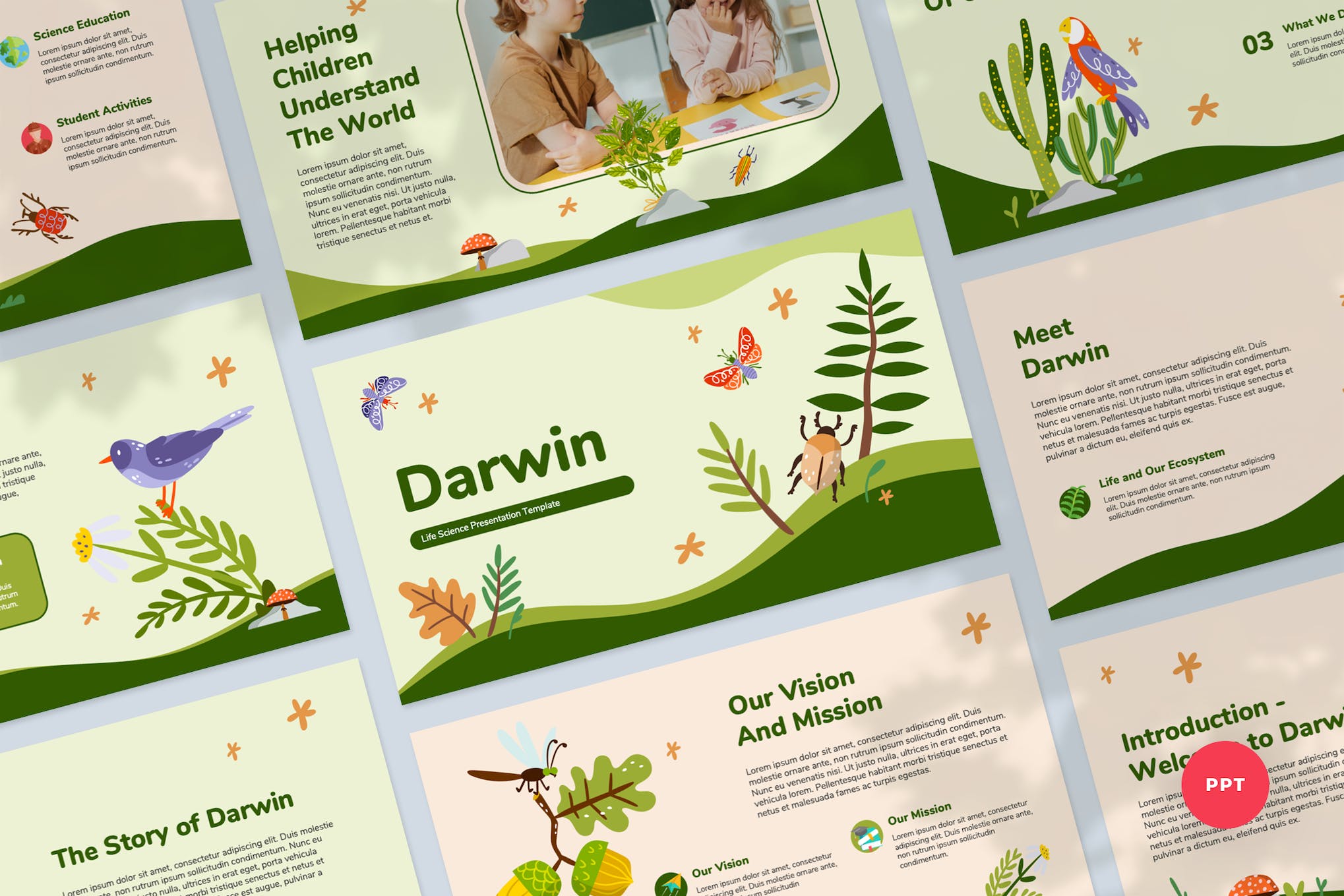
The Life Science PowerPoint Presentation Template is a modern, professional tool perfect for enhancing business meetings or lectures. Designed with educators and students in mind, this template includes 30 customizable slides that effortlessly translate your data into a compelling visual story. The template also employs free web fonts, drag-and-drop picture placeholders, and is fully adjustable for widescreen display. Try it out for an efficient, engaging presentation experience.
Labvire Science Research PowerPoint Template
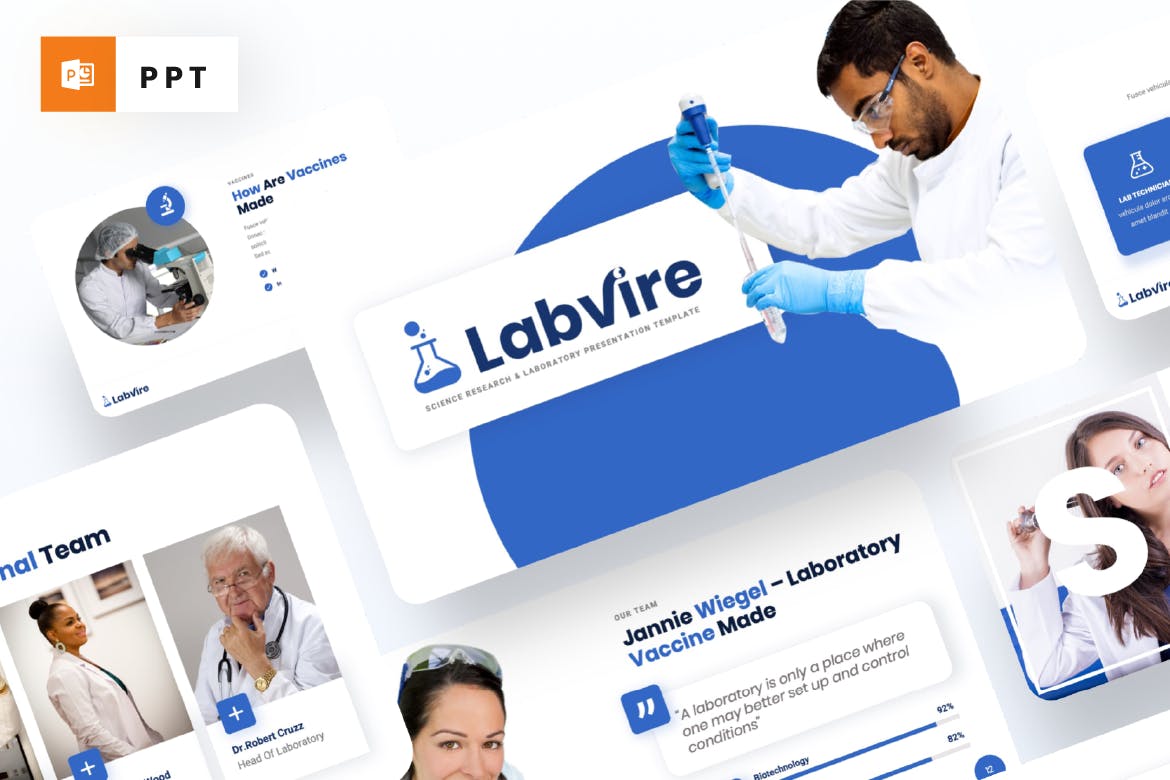
Labvire Science Research & Laboratory PowerPoint Template offers a sophisticated, modern design, perfect for any presentation – ranging from business to lab research projects. Created with a keen attention to detail, its features include more than 40 unique premade slides, editable charts, and image placeholders. Despite its sleek design, this template is user-friendly, crafted for optimal usability and is easy to customize.
Science Academy PowerPoint Template
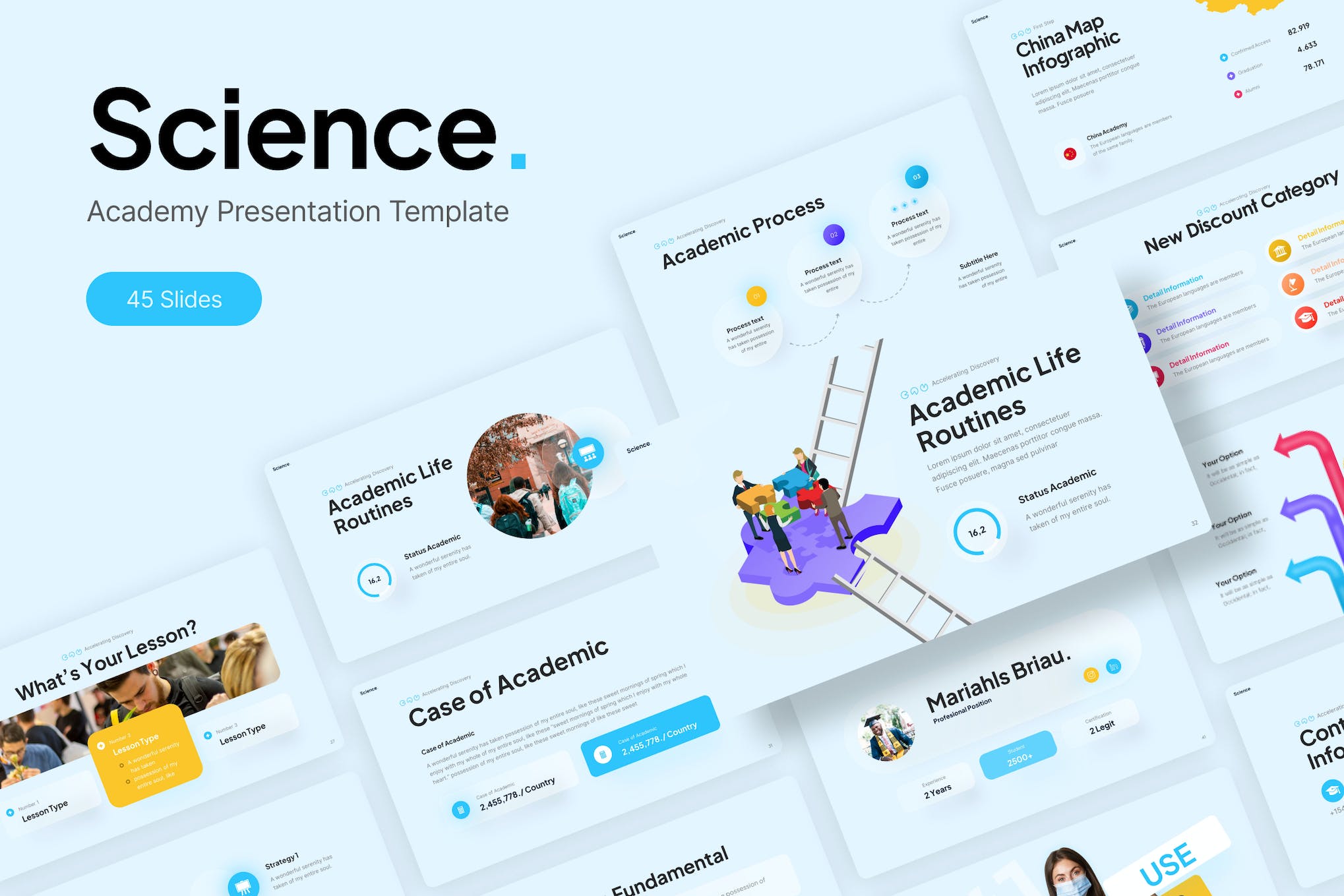
The Science Academy PowerPoint Template is a comprehensive tool designed to enhance your presentations. It comes with 45 unique slides and over 90 XML files, featuring a light and dark background option, and a handmade infographic, ensuring every presentation is exceptional. This customizable template, made by RRGraph Design, is perfect for all stages of business development, helping you stand out amongst competitors and propel your brand forward.
Neuralight Science Google Slides Template
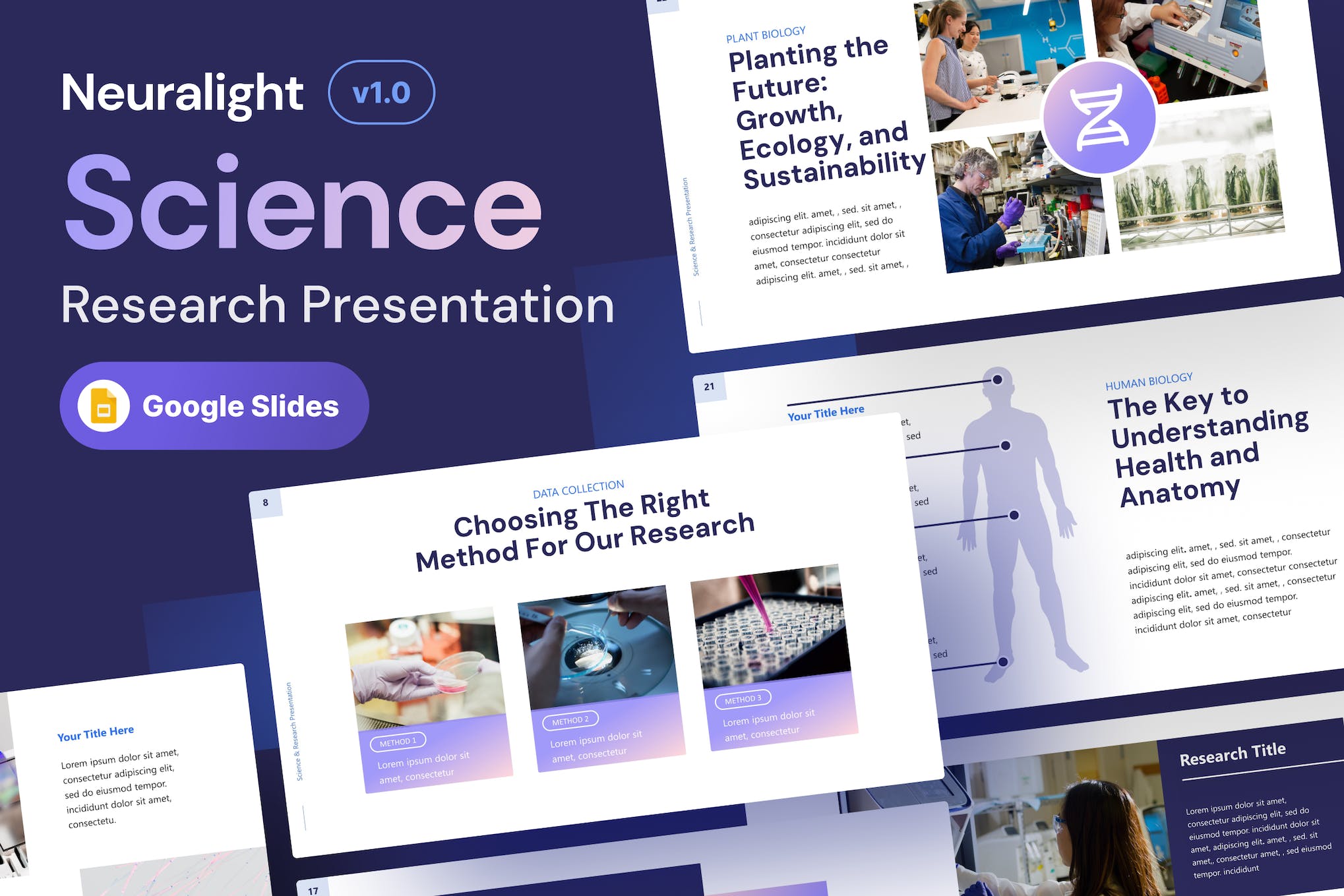
The Neuralight Science Google Slides Template is a user-friendly, customizable resource perfect for science and research presentations. Its modern, sleek, and futuristic design, with 30+ unique slides in a 16:9 wide-screen ratio, is exportable to Google Slides through PowerPoint alone. Every feature, including editable icons and elements, can be resized without losing clarity, personalized to your needs, or removed entirely.
Facility for Rare Isotope Beams
At michigan state university, ‘distinguished trailblazers in the sciences’ competition winners recognized at virtual ceremony.
FRIB, Michigan State University (MSU) , and the Thomas Jefferson National Accelerator Facility (Jefferson Lab) honored the winners of the “Distinguished Trailblazers in the Sciences” competition at a virtual ceremony on 22 January. For the competition, pre-college students created video presentations about scientists and engineers from minority and marginalized ethnic/racial groups who have excelled or contributed to the fields of nuclear science, accelerator science, and accelerator engineering.
There were two categories based on grade level:
Category one: Grades 5-8
Category two: Grades 9-12
Students created an original artistic design expression, personalized poem, musical performance (song/rap), video, or poster to highlight their selected “Distinguished Trailblazer in the Sciences.” They then created an original video in which they presented their submission. The winners and their winning videos are:
- Presentation on Chien-Shiung Wu
- Presentation on Shirley Jackson
- Presentation on Margaret Melhase
- Presentation on Homi J. Bhabha
- Presentation on He Zehui
- Presentation on J. Ernest Wilkins
The competition was developed under the Student Training and Engagement Program for Undergraduates in Physics (STEP-UP). STEP-UP is a national organization of physics teachers, researchers, and professional societies that designs high-school physics lessons to inspire young people to pursue physics in college. It is a joint initiative between FRIB and Jefferson Lab. STEP-UP Coordinators Chandra Oaks-Garcia and Mornetka Gueye, and Artemis Spyrou, professor of physics at FRIB and in the Michigan State University (MSU) Department of Physics and Astronomy, created and organized “Trailblazers.”
“It is paramount to continuously expose all students very early in their education to increase representation in STEM fields,” said Paul Gueye, an associate professor of nuclear physics at FRIB and in the Michigan State University (MSU) Department of Physics and Astronomy, and founder of the STEP-UP program. “We are all inspired by the talents of all of these bright students and looking forward to their impacts in basic and applied nuclear science, and beyond.”
At the ceremony, the students were recognized for their work by representatives of FRIB and Jefferson Lab. Each winner was able to present their video and offer their thoughts on the most exciting part of making their presentation. One award winner noted that prior to her research, she did not know who her scientist was, and that was a fun experience conducting her research. In addition, the winners heard from practicing physicists, each of whom shared their career journey and encouraged the students to further explore their scientific interest.
FRIB Laboratory Director Thomas Glasmacher and Jefferson Lab Associate Director for Experimental Nuclear Physics Cynthia Keppel also attended the ceremony. Both commended the students, stating they were impressed by the students’ presentations.
“We train a third of the nation’s nuclear scientists at FRIB and Michigan State University, and aim for our graduate student body to reflect the nation’s vibrant makeup of backgrounds and cultures,” Glasmacher said. “All of our students started with excitement about science at school. I loved seeing the videos and the passion and excitement that went into each Trailblazer project.”
Michigan State University operates the Facility for Rare Isotope Beams as a user facility for the U.S. Department of Energy Office of Science (DOE-SC), supporting the mission of the DOE-SC Office of Nuclear Physics.

COMMENTS
Preparation of a scientific presentation involves three separate stages: outlining the scientific narrative, preparing slides, and practicing your delivery. Making the slides of your talk without first planning what you are going to say is inefficient. Here, we provide a 4 step guide to writing your scientific presentation:
First is a two part set of videos that walks you through organizing a presentation. Part 1 - Creating an Introduction for a 10-15 Minute Scientfic Presentation. Part 2 - Creating the Body of a 10-15 Minute Presentation: Design/Methods; Data Results, Conclusions. Two additional videos should prove useful: Designing PowerPoint Slides for a ...
Simplify. The best science talks start with a process of simplifying - peeling back the layers of information and detail to get at the one core idea that you want to communicate. Over the course of your talk, you may present 2-3 key messages that relate to, demonstrate, provide examples of or underpin this idea.
Step 1. Create a Presentation Outline. The first step to giving a good scientific talk is to create a presentation outline that engages the audience at the start of the talk, highlights only 3-5 main points of your research, and then ends with a clear take-home message. Creating an outline ensures that the overall talk storyline is clear and ...
Below we propose a quick framework for creating a compelling scientific presentation in PowerPoint (+ some helpful templates!). 1. Open with a Research Question. Here's how to start a scientific presentation with ease: share your research question. On the first slide, briefly recap how your thought process went.
Talk from your diaphragm, not your throat, to give your voice authority and resonance. 7. Take your time. A moment or two of silence as you gather your thoughts or move to a new topic can actually make the audience pay attention. Don't feel you have to talk continuously, and avoid filler phrases, such as "you know.".
7 Appearance: if you look good, you'll feel good, which will help you give a great speech. 8 Pauses: they give the audience time to think, and help them engage. 9 Body language: use ...
The result highlighted in your title will help you to focus your talk so that the solutions you present lead to this overarching result. Here is the general pattern: 1. Present the first part of ...
Tip 3: Deliver your talk with intention. Tip 4: Be adaptable and willing to adjust your presentation. Tip 5: Conclude your talk and manage questions confidently. Concluding thoughts. Other sources to help you give a good scientific presentation. Frequently Asked Questions about giving scientific presentations.
Here are his 10 keys to an engaging scientific presentation: 1) Be an Entertainer First: Before your science can wow your audience, they have to understand it. Before they can understand it, you must engage them with what you're saying. Look at your presentation from your audience's perspective and think about how they'll relate to your ...
A 10-15 Minute Scientific Presentation, Part 1: Creating an Introduction. For many young scientists, the hardest part of a presentation is the introduction. ... Make sure you select 720p HD on the video (bottom right corner) for best resolution and so scientific illustrations and figures are clear. You can also find this video, ...
6. Practice making your presentation. First, practice by yourself or in a mirror. If you have a time limit, time yourself to make sure your presentation isn't too long or short. Ask your parents or a friend if you can present your project to them, and ask if they have any pointers. 7.
Keep the audience interested by clearly motivating your decisions based on your original research question or the tension built in your introduction. Results (climax) Less is usually more here. Only present results which are clearly related to the focused research question you are presenting.
Tip #1: Know your audience. View the presentation as a dialogue with the audience rather than a monologue, and always consider the interests and expertise of your audience. This will help you tailor your scientific presentation to their level of knowledge and interests. Tip #2: Make use of PowerPoint.
Step 1: Identify your audience: this will control the level of your presentation and the amount of background material you need to orient everyone in the audience. Step 2: Determine how much time you have for your presentation: this will control how much time you have to talk about each part of your outline (see below) Step 3: Identify the main ...
A compelling science presentation is not just a collection of facts and data; it's a story. People remember stories much better than isolated pieces of information. Start your presentation with a clear narrative structure, including: Introduction: Begin with a captivating opening that grabs your audience's attention. You can use a personal ...
Practice a 1- to 2-minute pitch until you feel comfortable. The poster and your pitch must be aimed at the audience that will be present. The clearer and more rational your poster layout, the easier it will then be for you to make a strong pitch. —Srinivas.
NEW FREE COURSE on Scientific Presentation for Busy Students. Learn it for free with code FREEFORYOU https://www.udemy.com/course/scientific-presentation-fo...
Invest a sufficient amount of time or poster space in describing the study methods. Clearly organize and deliver the results or synopsis of relevant studies. Include absolute numbers and simple statistics before showing advanced analyses. Remember to present one point at a time. Stay focused.
2 No chart junk! This one is easy, but oh, is it important. If you create slides with charts or graphs, make them clean. We can all see in 3D, so it's really not remarkable enough to use it in your slides. Get rid of the grid lines, shadows, patterns, outlines and what not. Chart junk is basically the homeopathy of presentation design; it ...
Explaining Aerodynamics can be an interesting topic. It also allows you to introduce props such as a plane and practical exercises such as creating your own plane and analyzing its aerodynamics. The introduction of visuals for such a topic can greatly enhance the learning experience. 6. Gravity.
Science Fair Tip #5. Keep your project simple. Try to test only one variable or one hypothesis in your project. The more experiments in the project, the harder it is to keep track of all the factors that influence your science project. After all, there is always next year to expand on this year's project. Consult our Science Fair Guide for ...
Free Science Google Slides themes and PowerPoint templates. Science Presentation templates. Download cool Science PowerPoint templates and Google Slides themes and use them for your projects and presentations. Find creative and professional slide decks full of resources at your disposal for maximum customization. Filters.
Science Education Presentation Template. The Science Education Presentation Template is a modern, professional PowerPoint tool perfect for enhancing your next presentation. With a total of 20+ slides including handcrafted infographics and galleries, this easy-to-use template offers editable graphics and a drag & drop picture placeholder.
The current warming trend is different because it is clearly the result of human activities since the mid-1800s, and is proceeding at a rate not seen over many recent millennia. 1 It is undeniable that human activities have produced the atmospheric gases that have trapped more of the Sun's energy in the Earth system. This extra energy has warmed the atmosphere, ocean, and land, and ...
For the competition, pre-college students created video presentations about scientists and engineers from minority and marginalized ethnic/racial groups who have excelled or contributed to the fields of nuclear science, accelerator science, and accelerator engineering.There were two categories based on grade level:Category one: Grades 5 ...
Students also learn to conduct research that pushes medical science ahead, whether in basic research, clinical or translational science, or the compassionate and just delivery of health care. ... that he'd been awarded the Judah Folkman Prize for Clinical/Translational Research for his poster during the awards presentation at the end of the day.